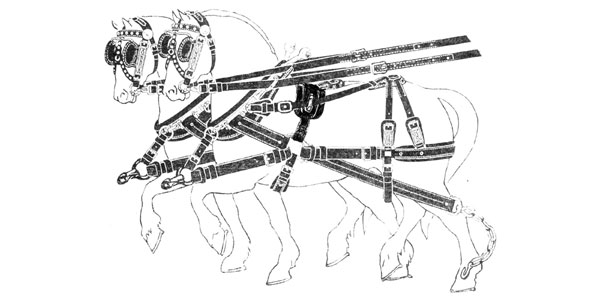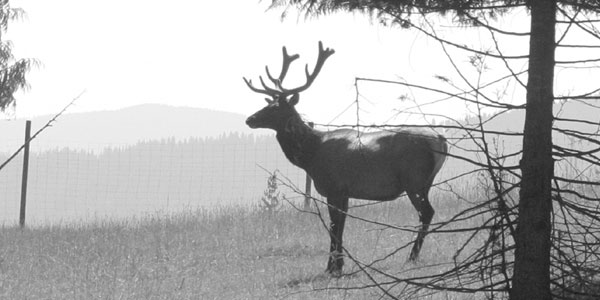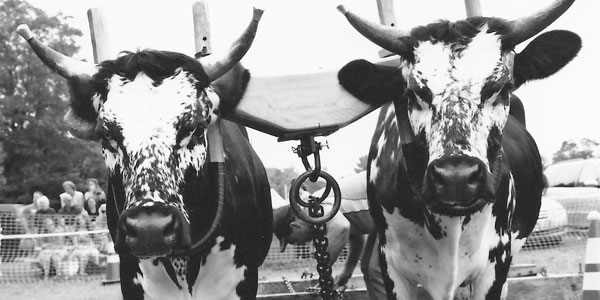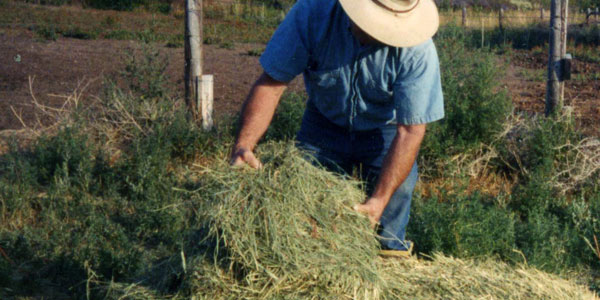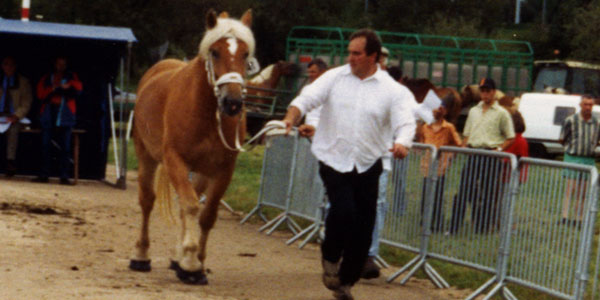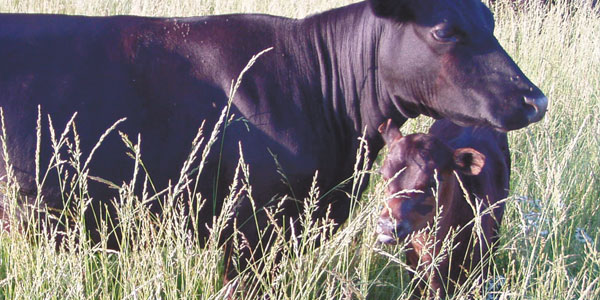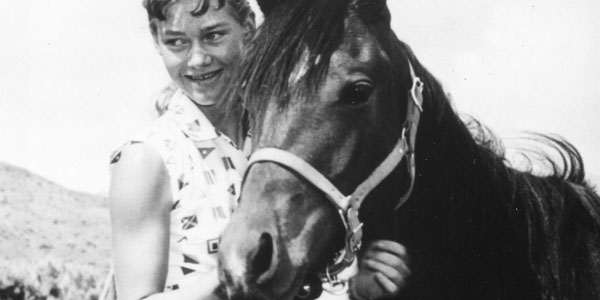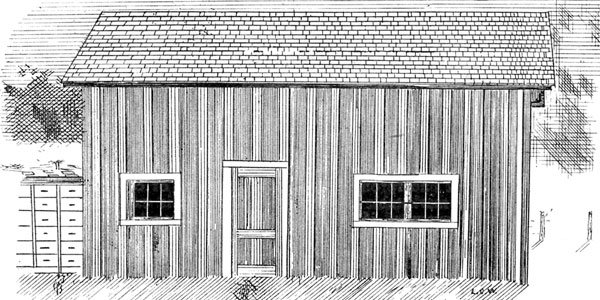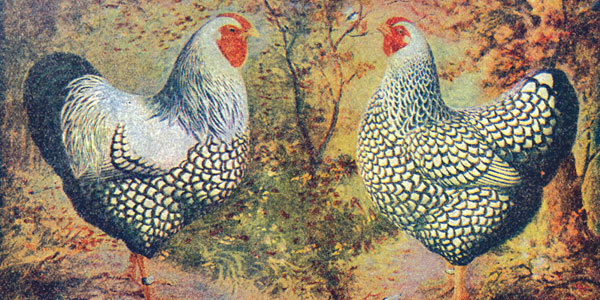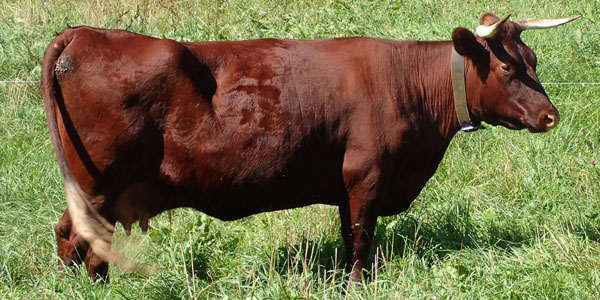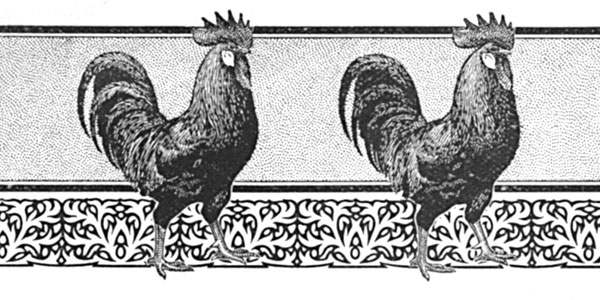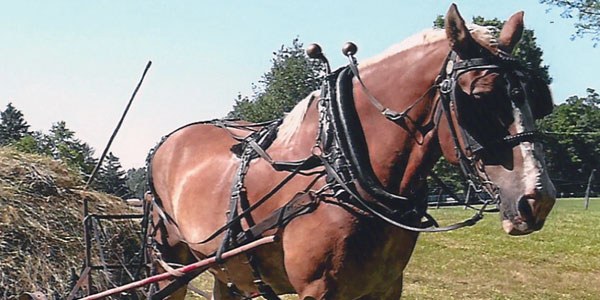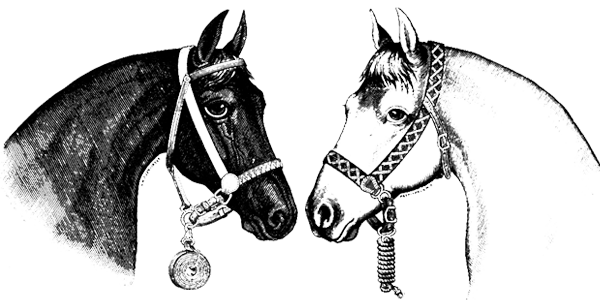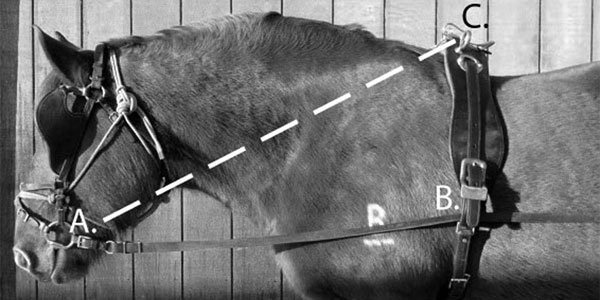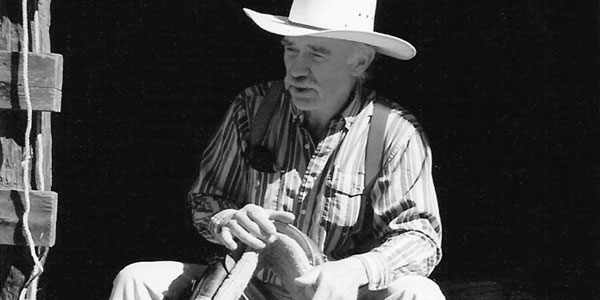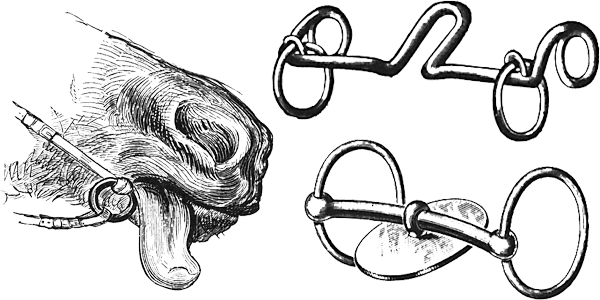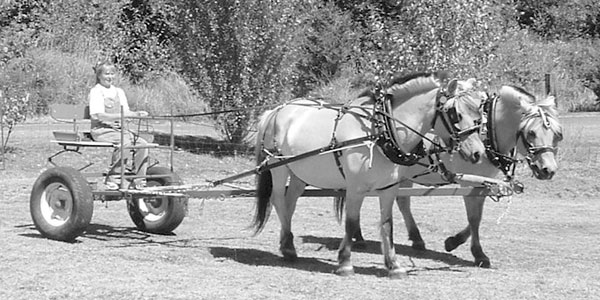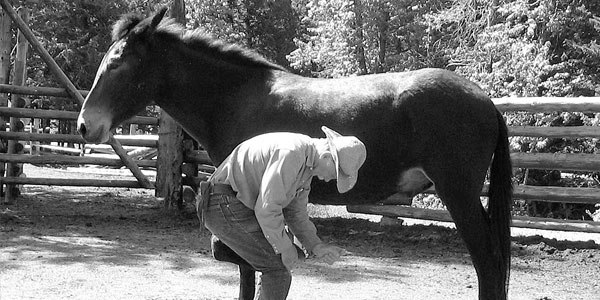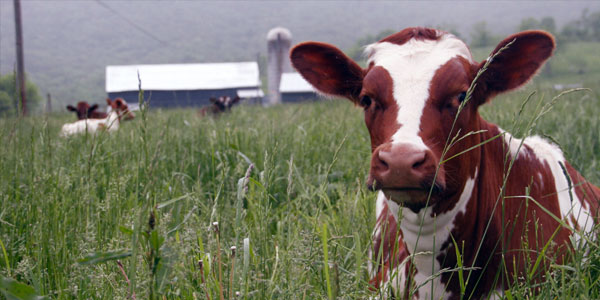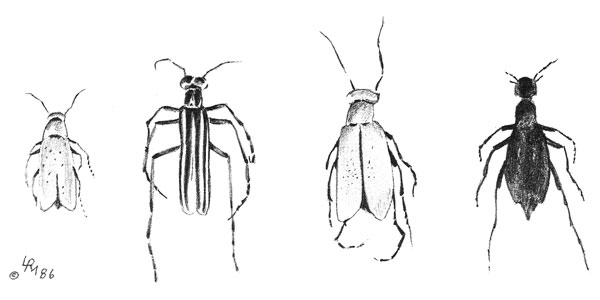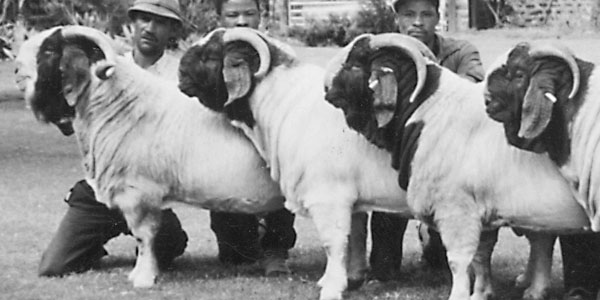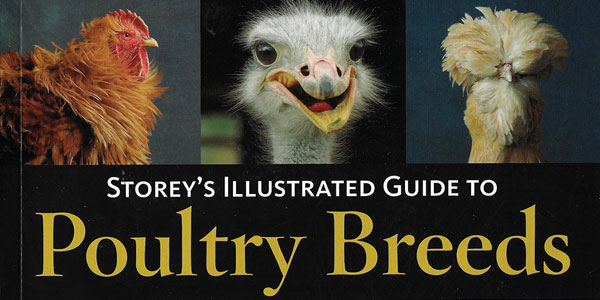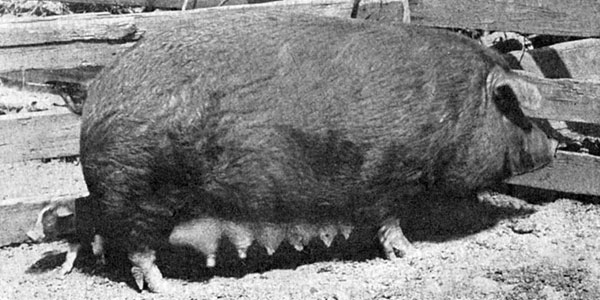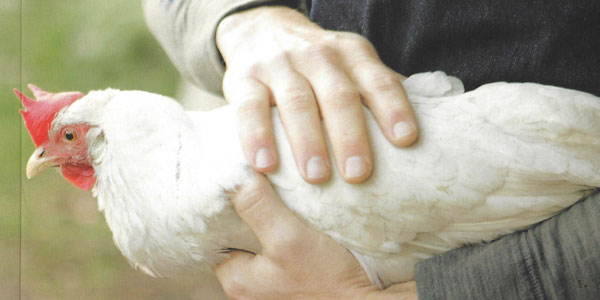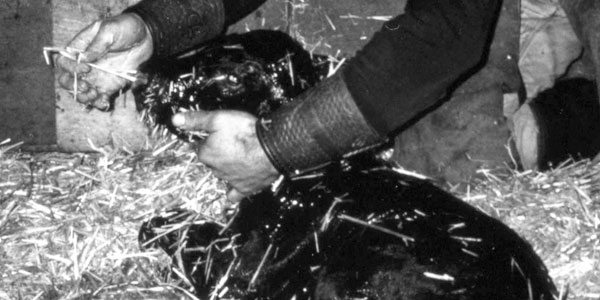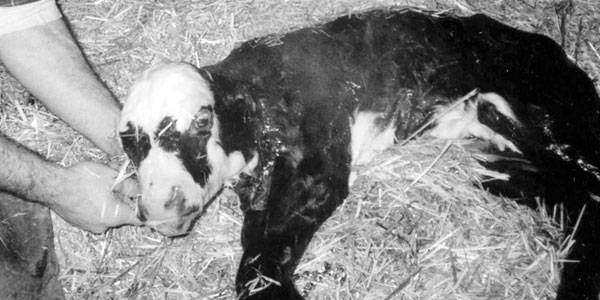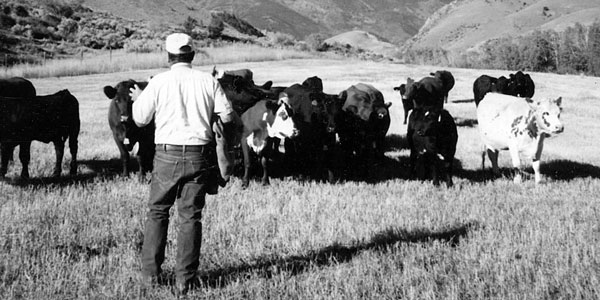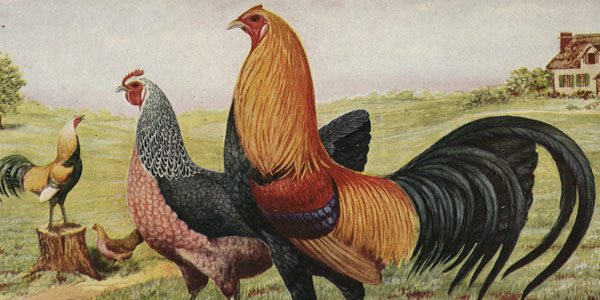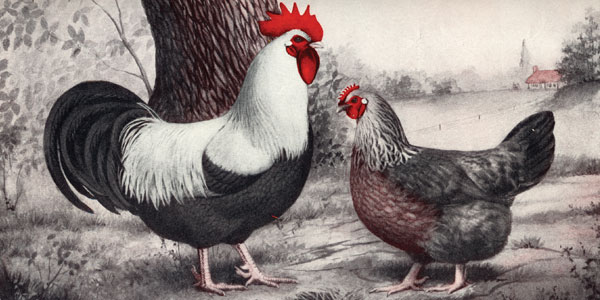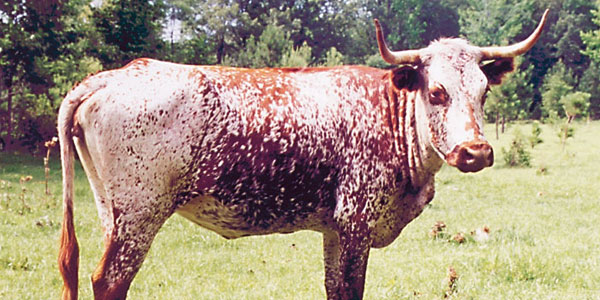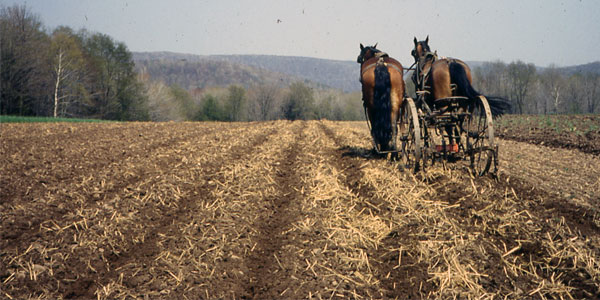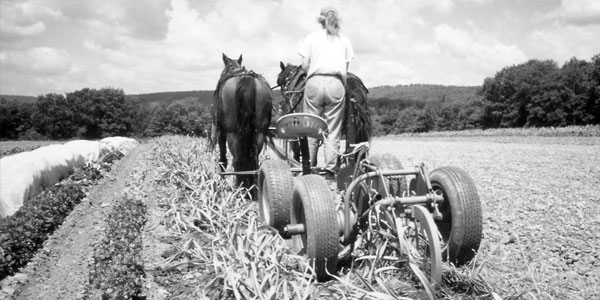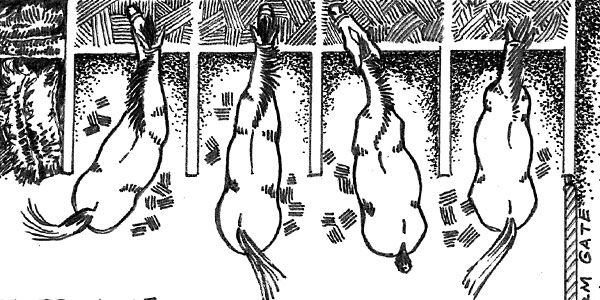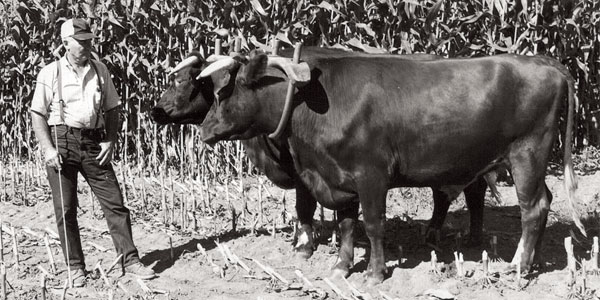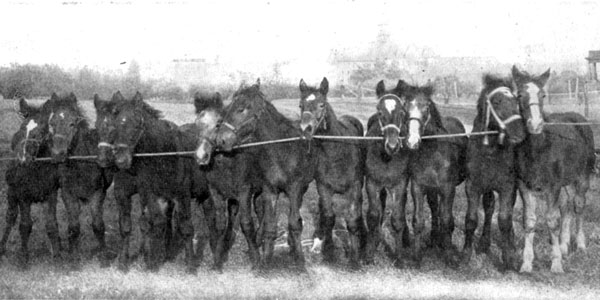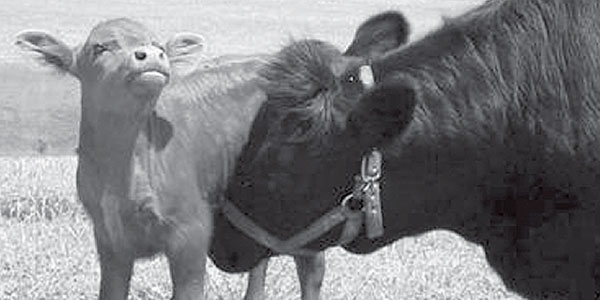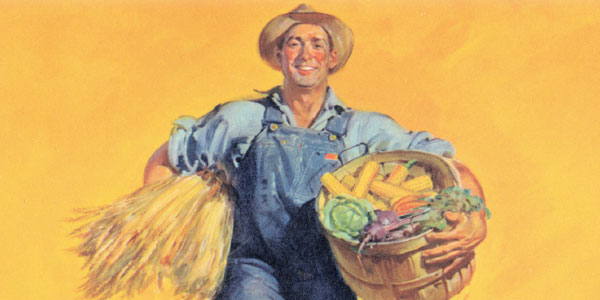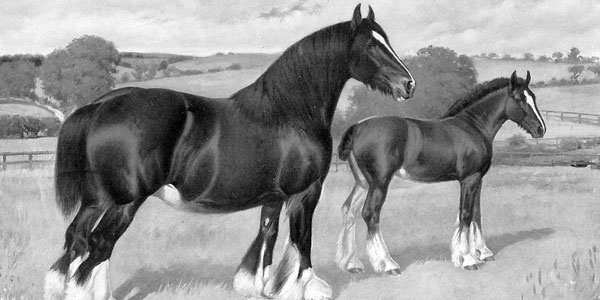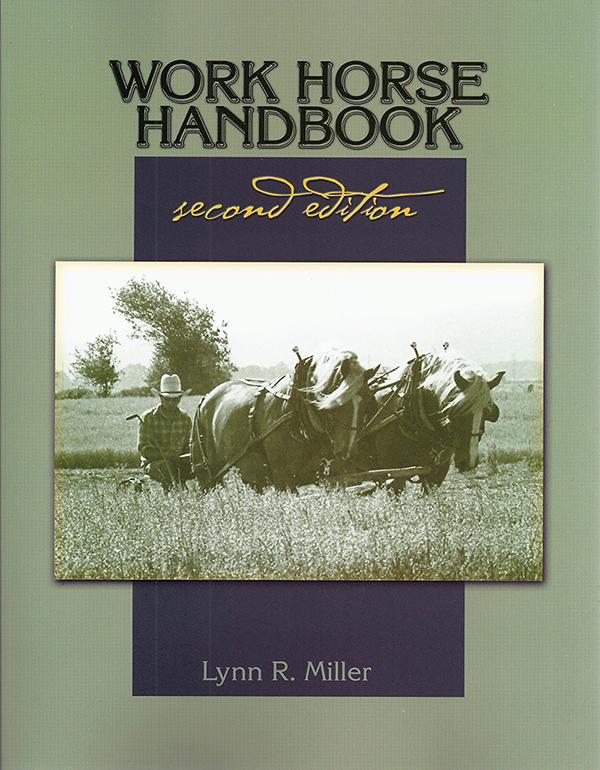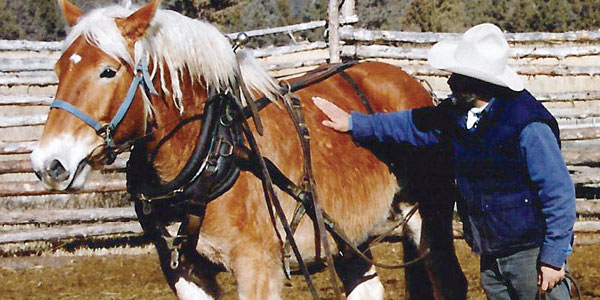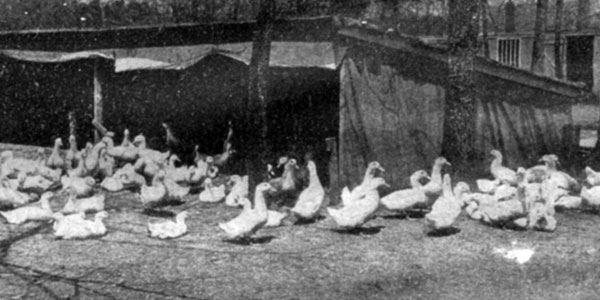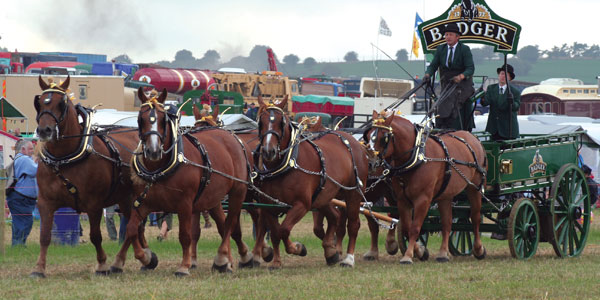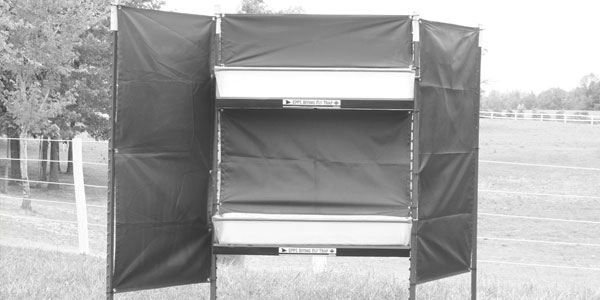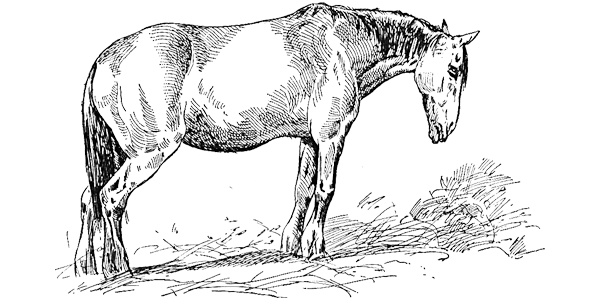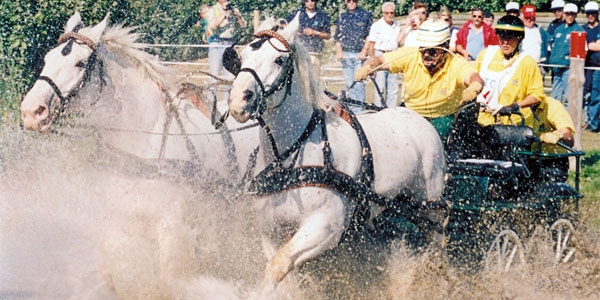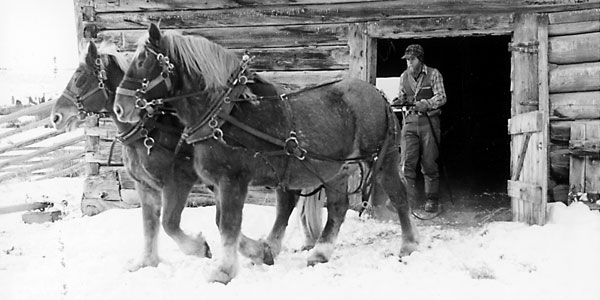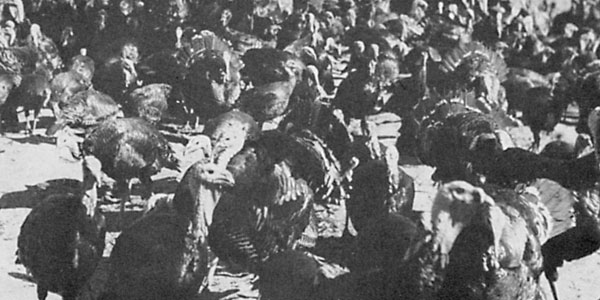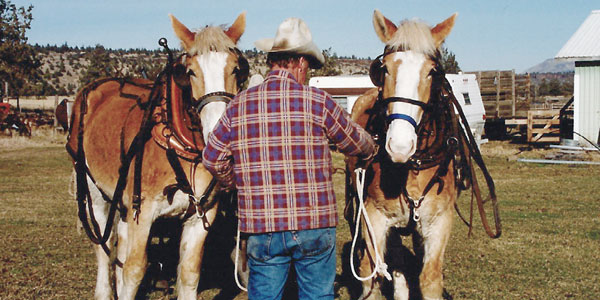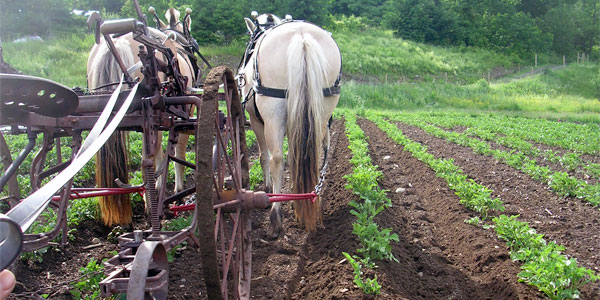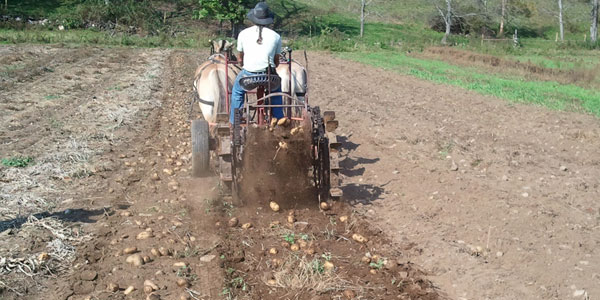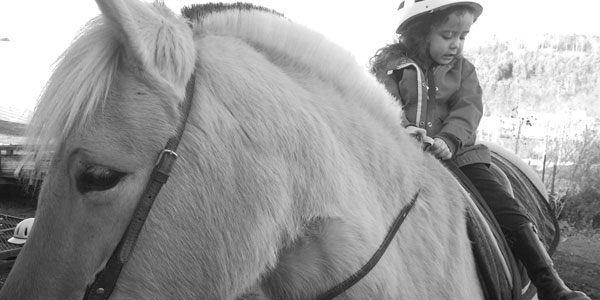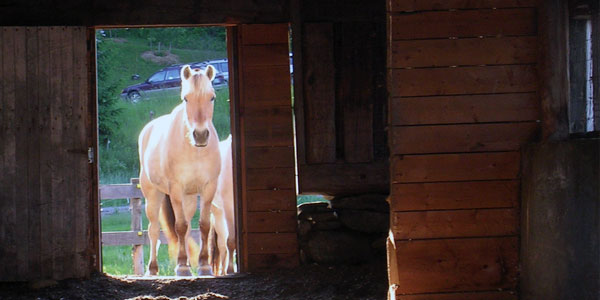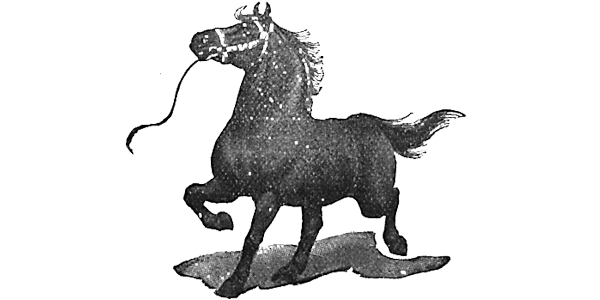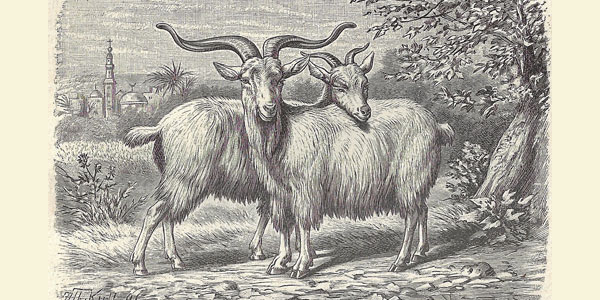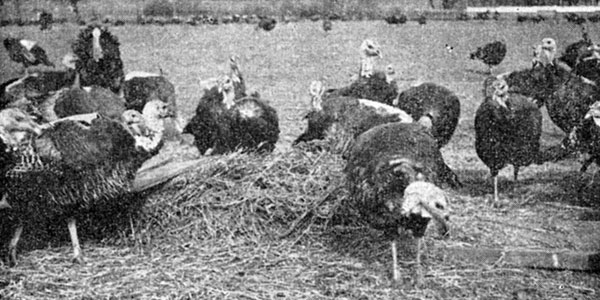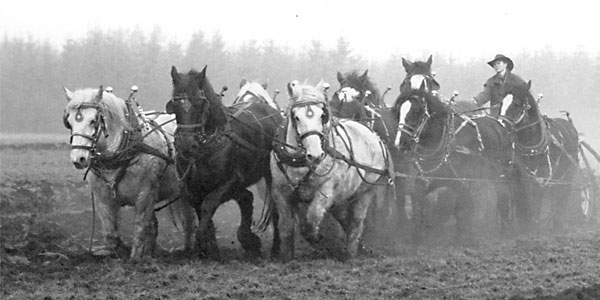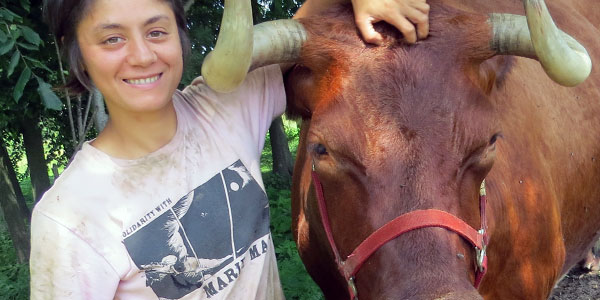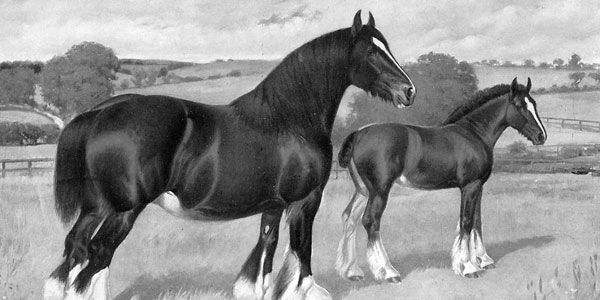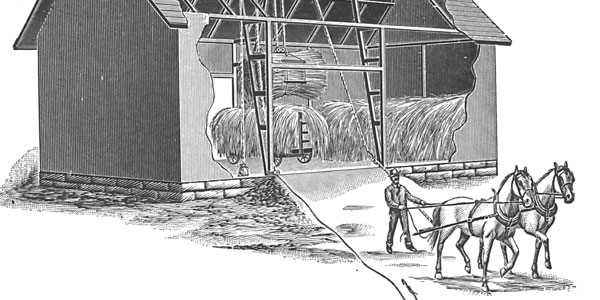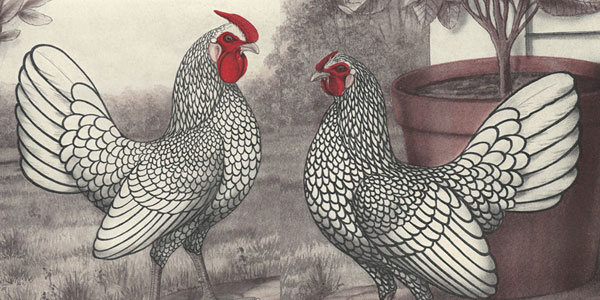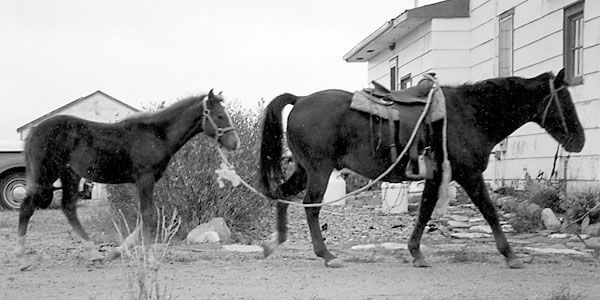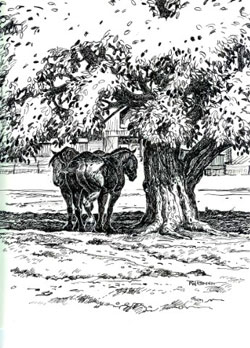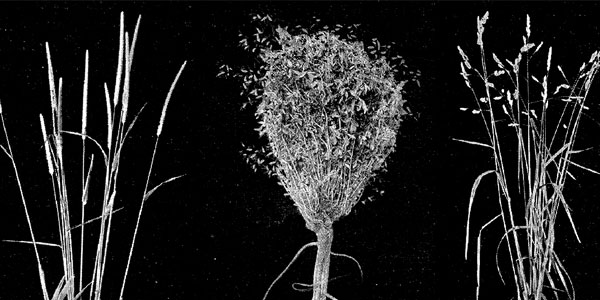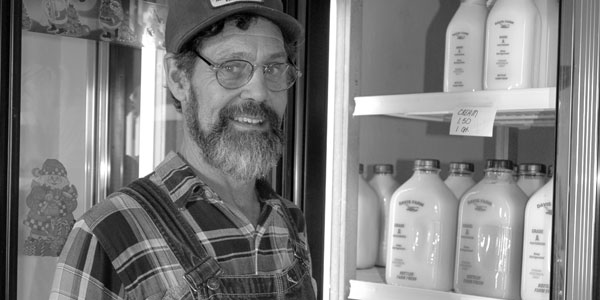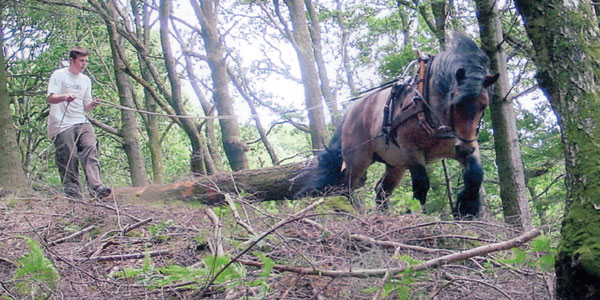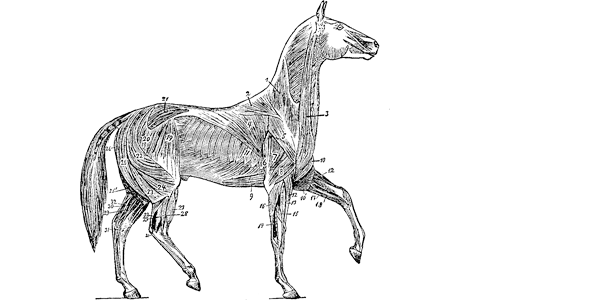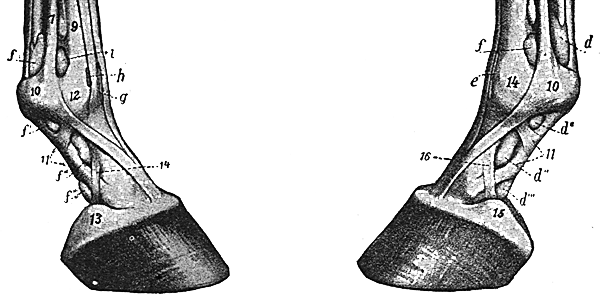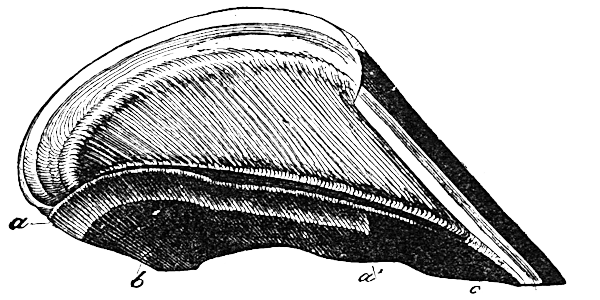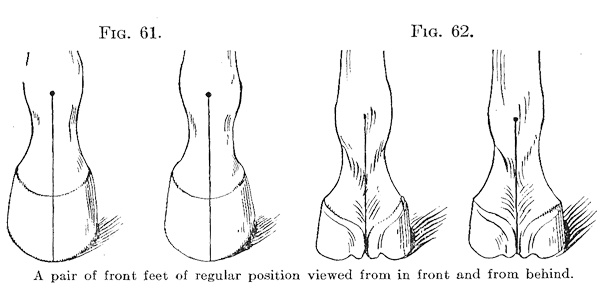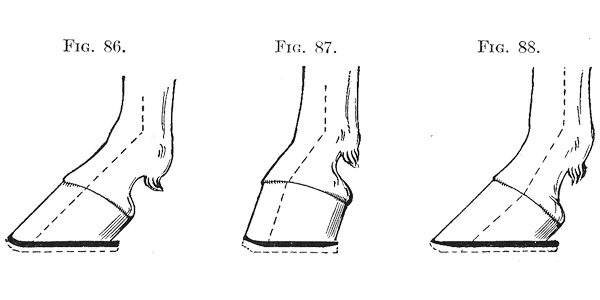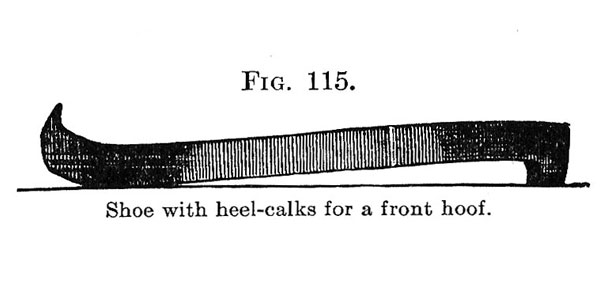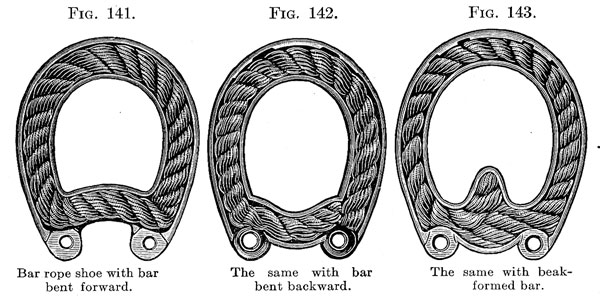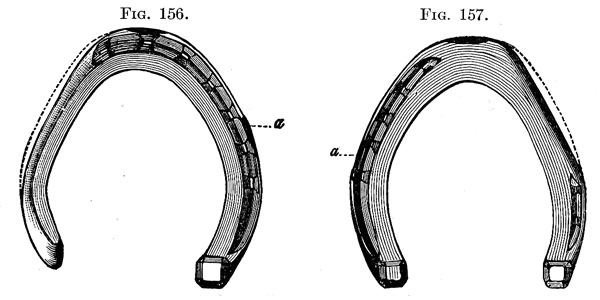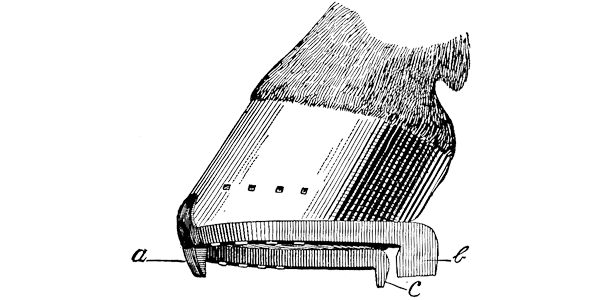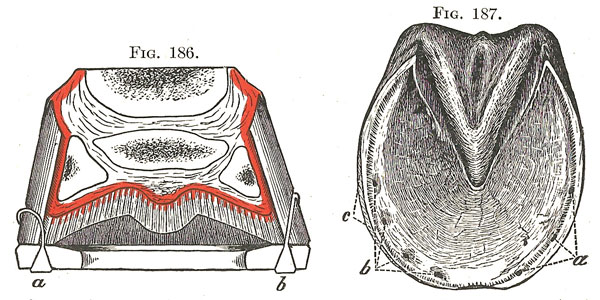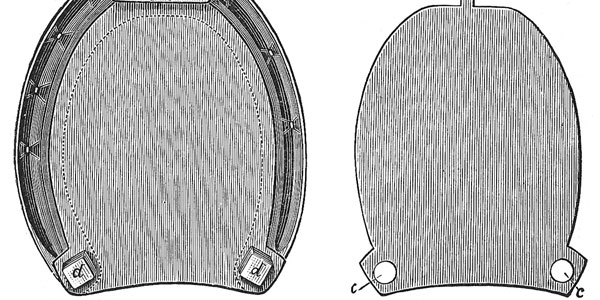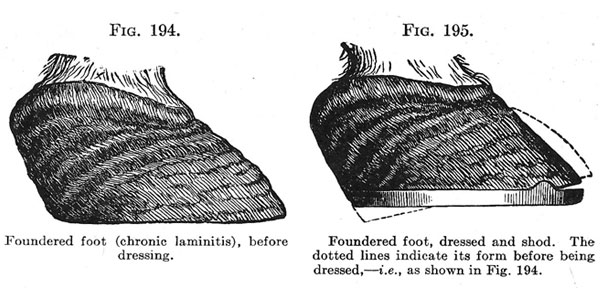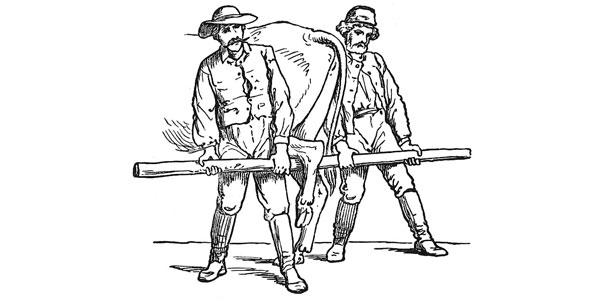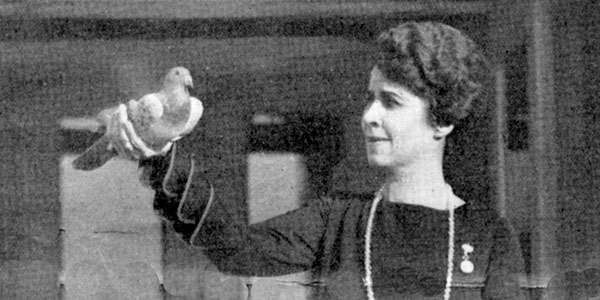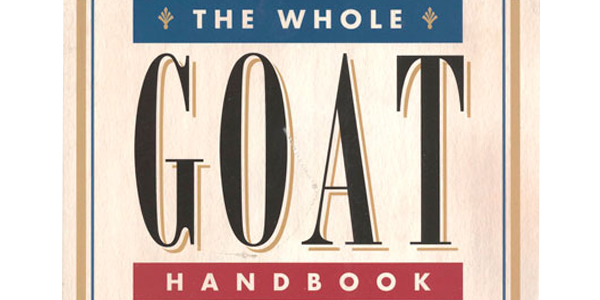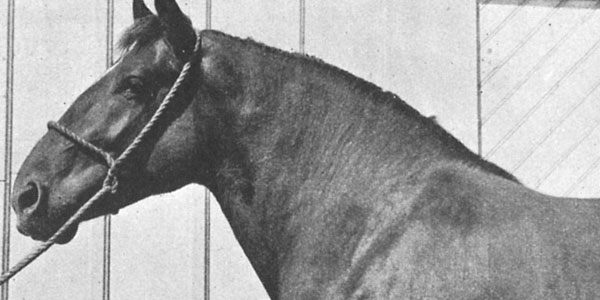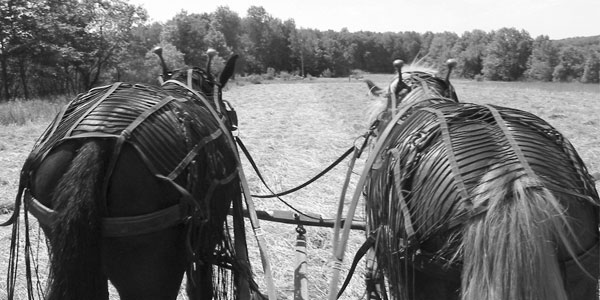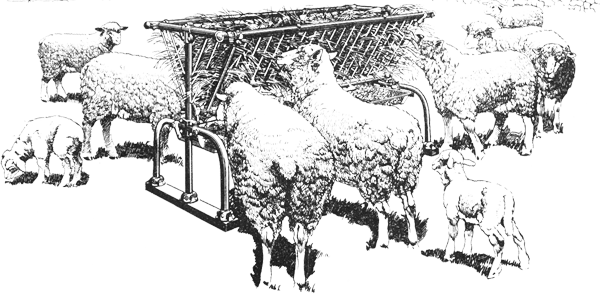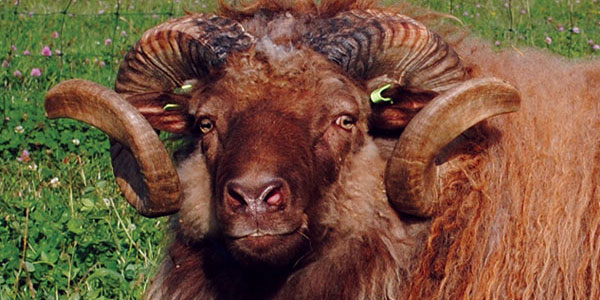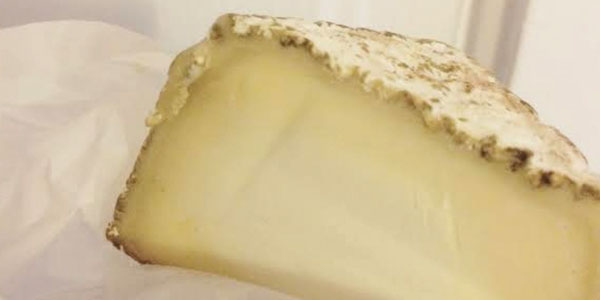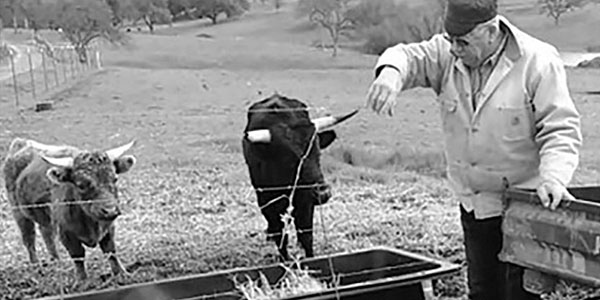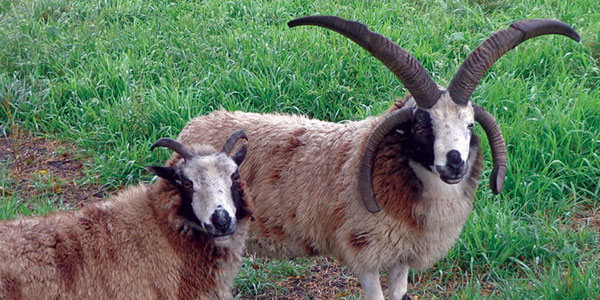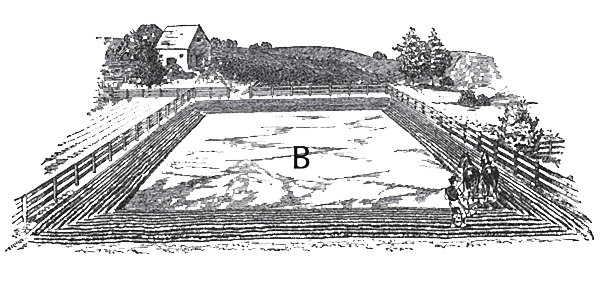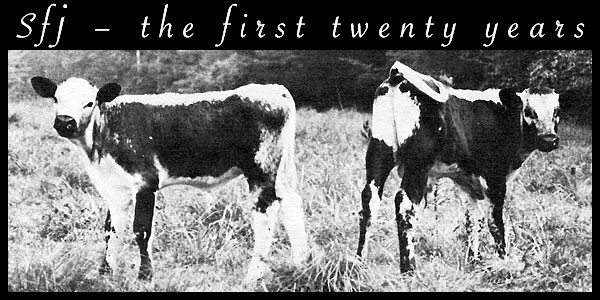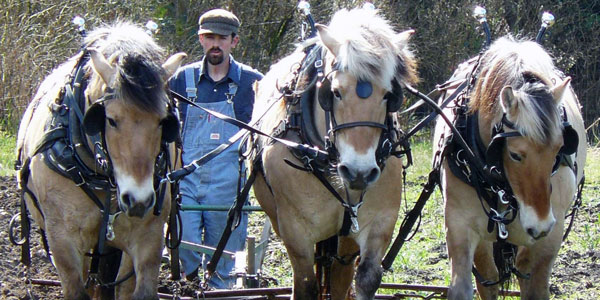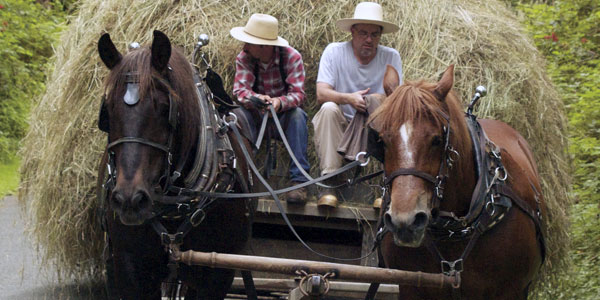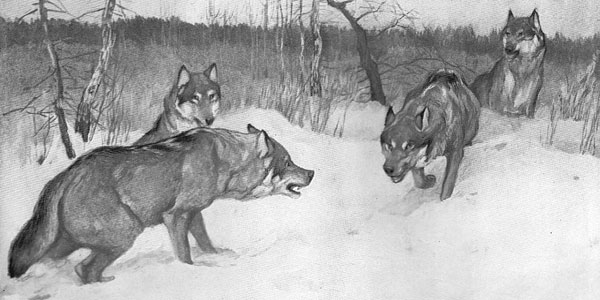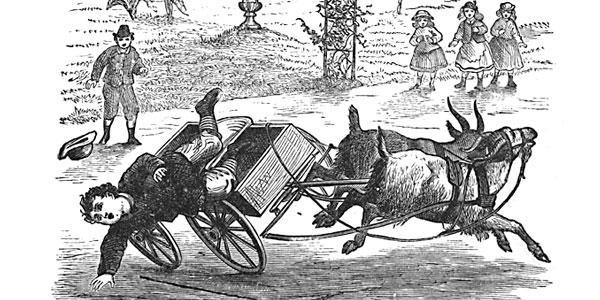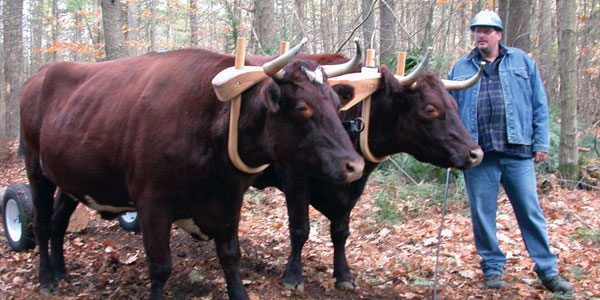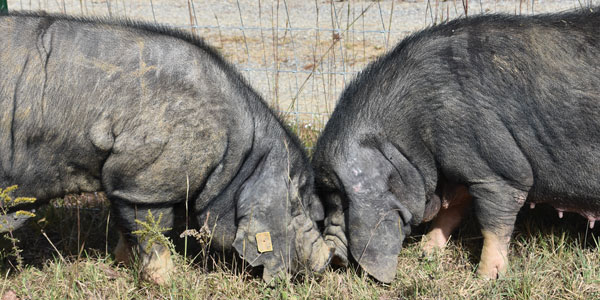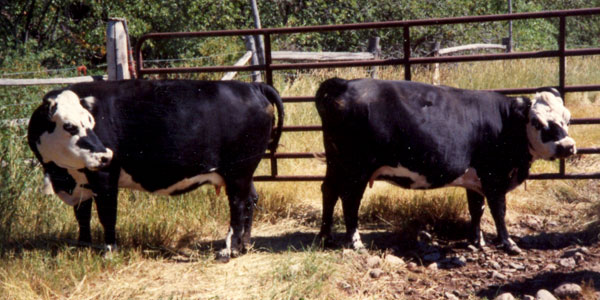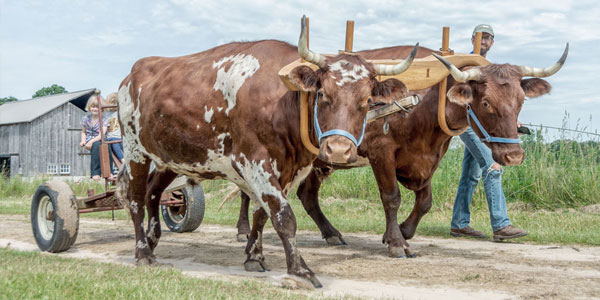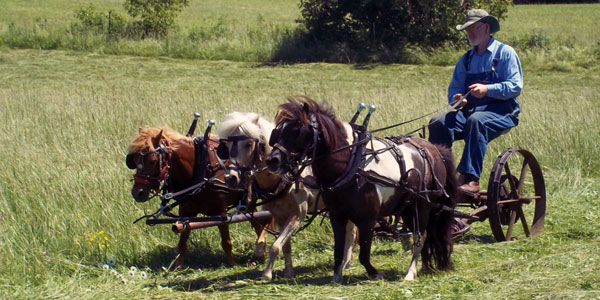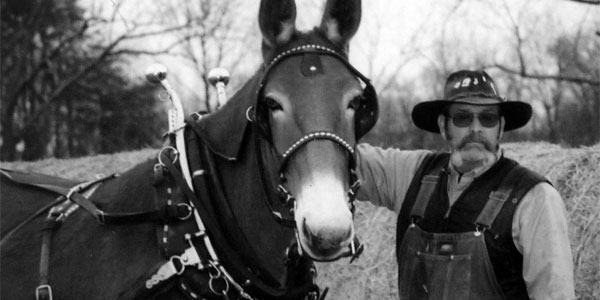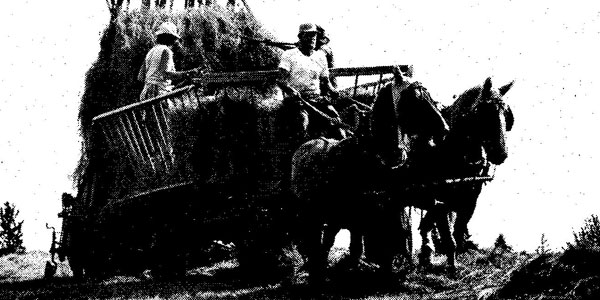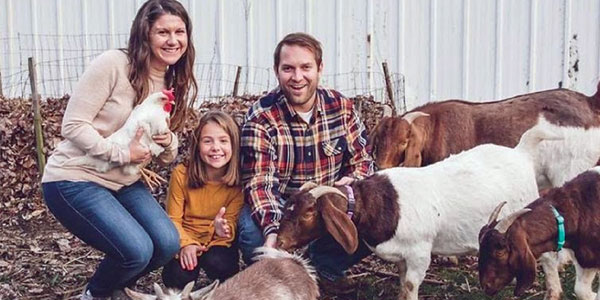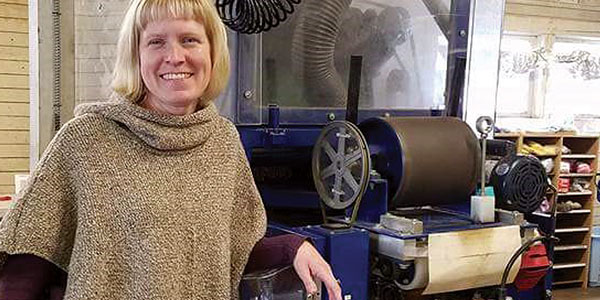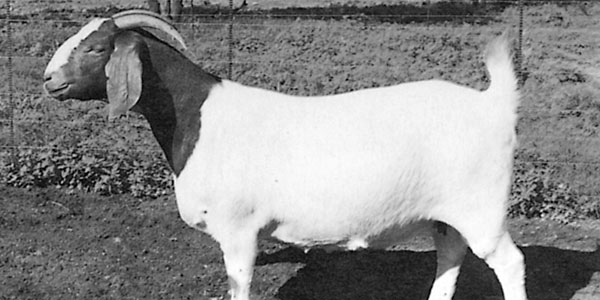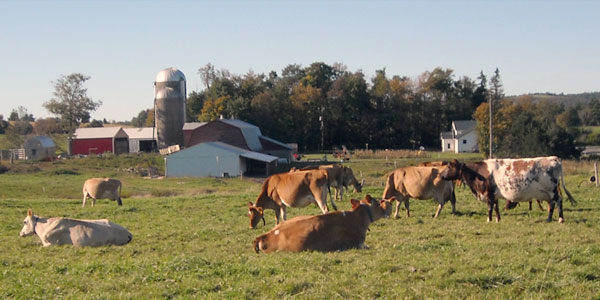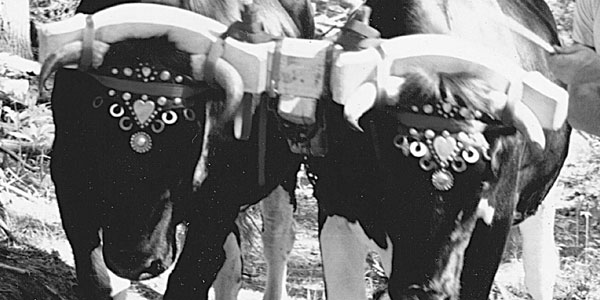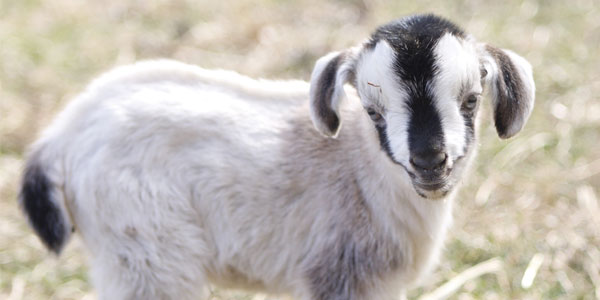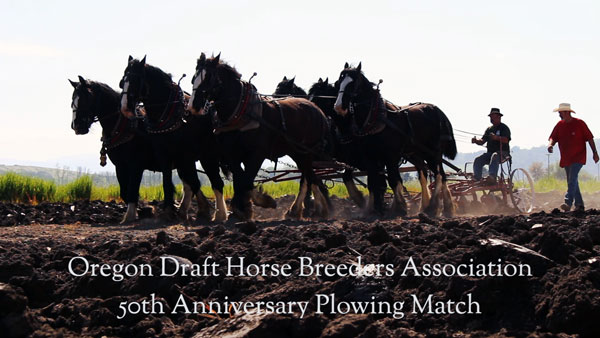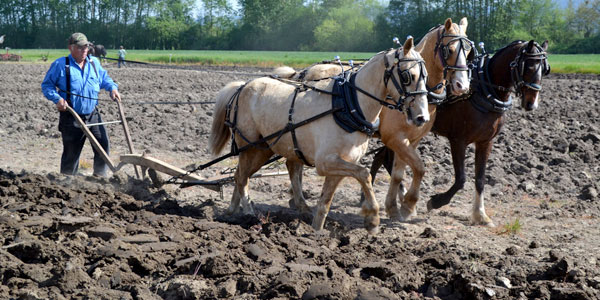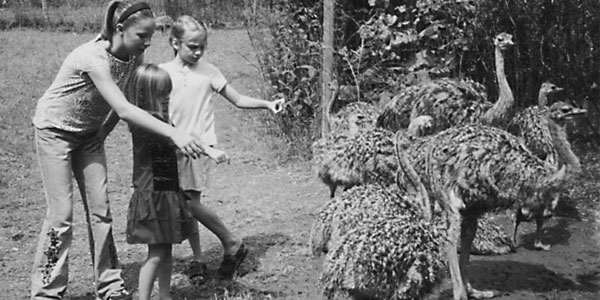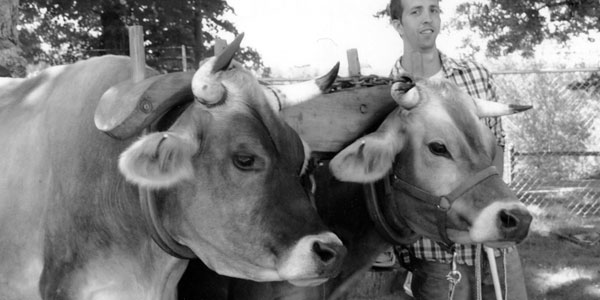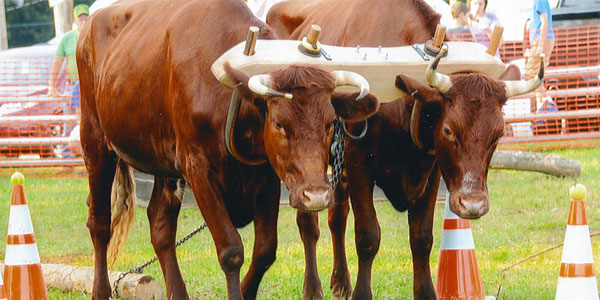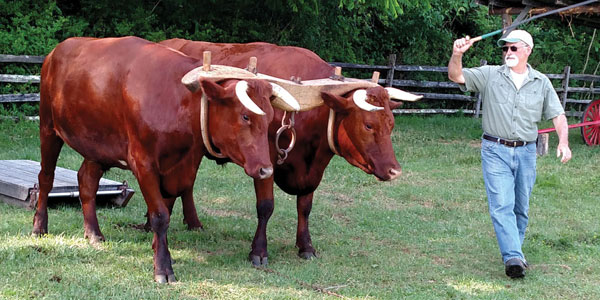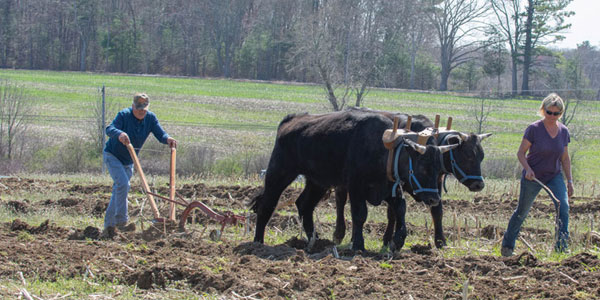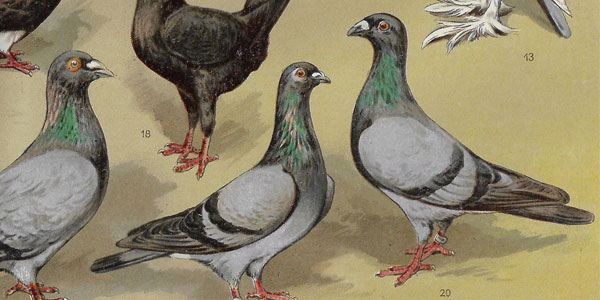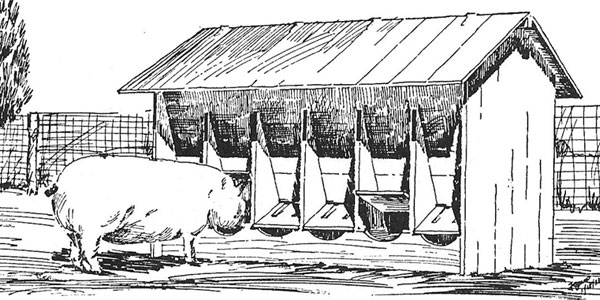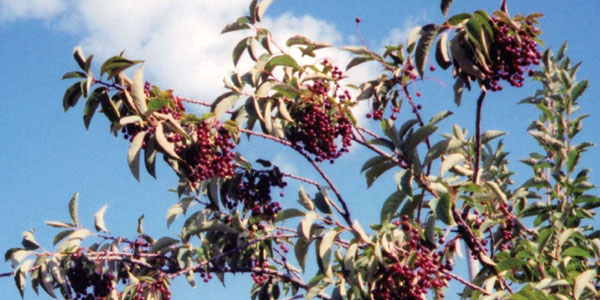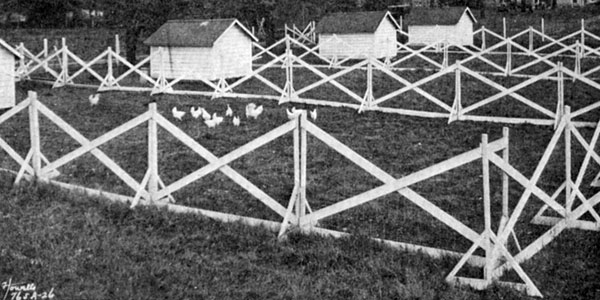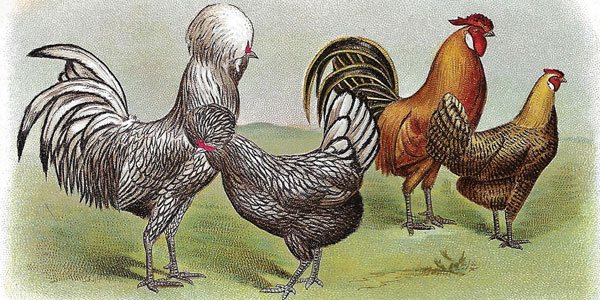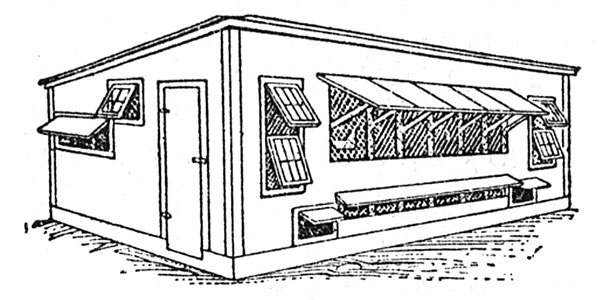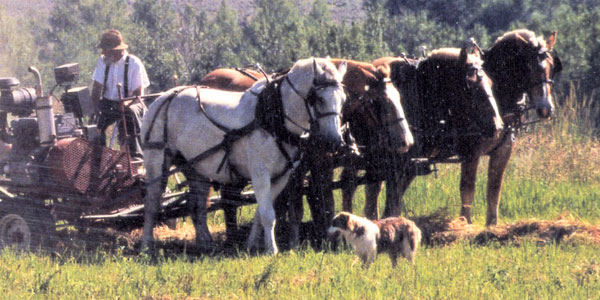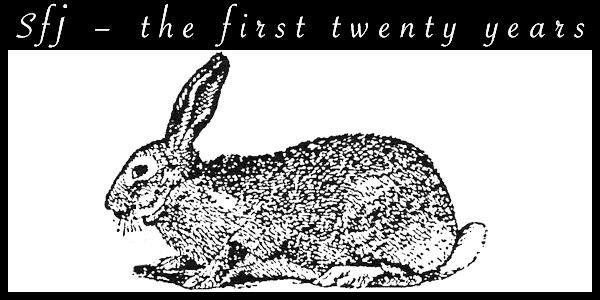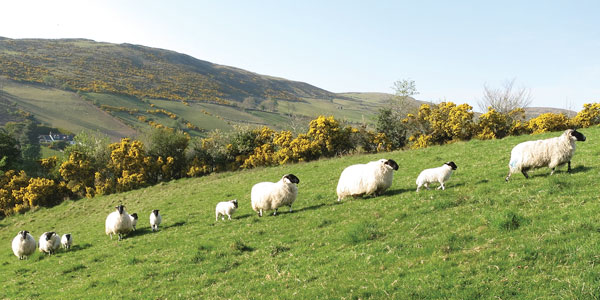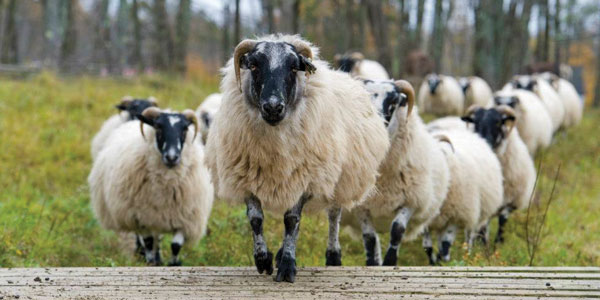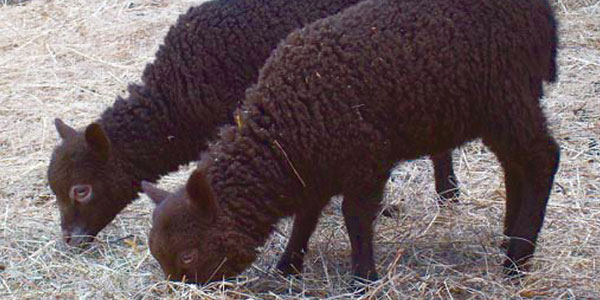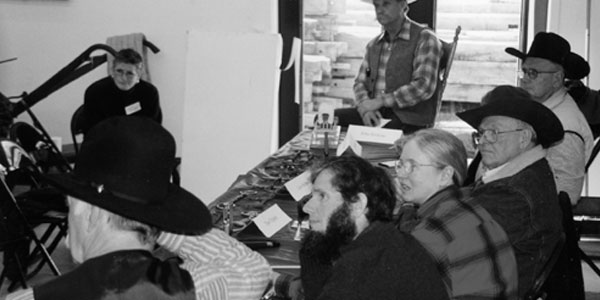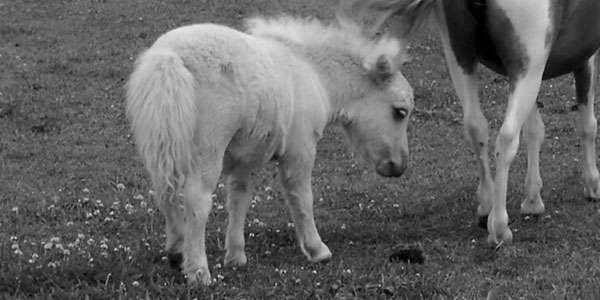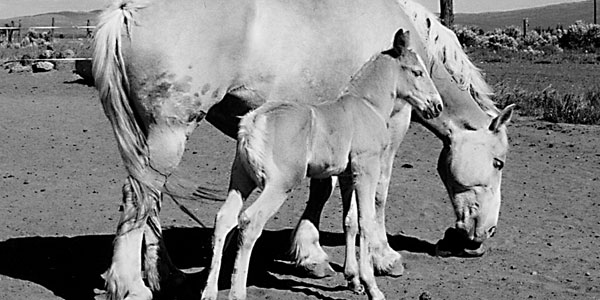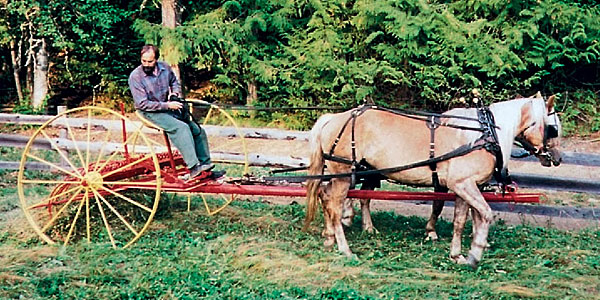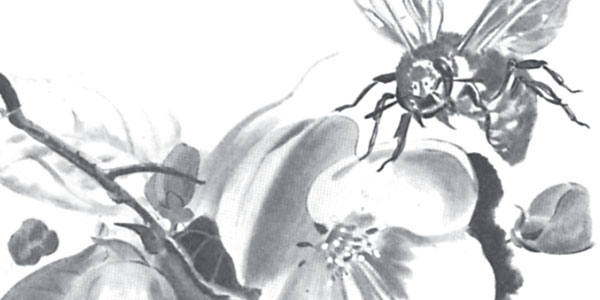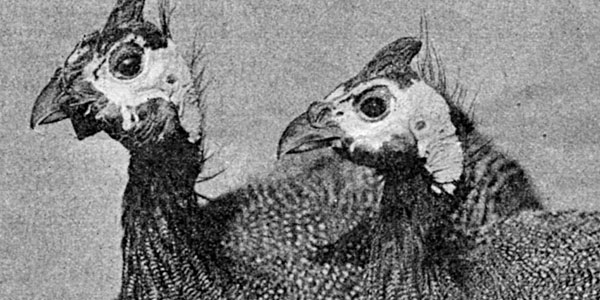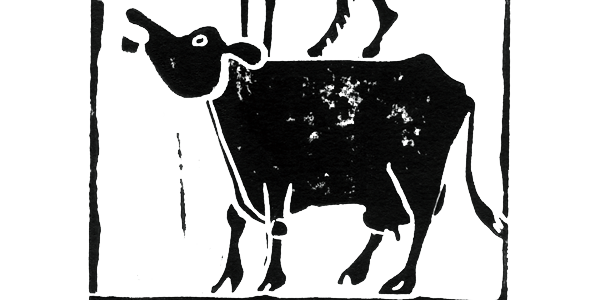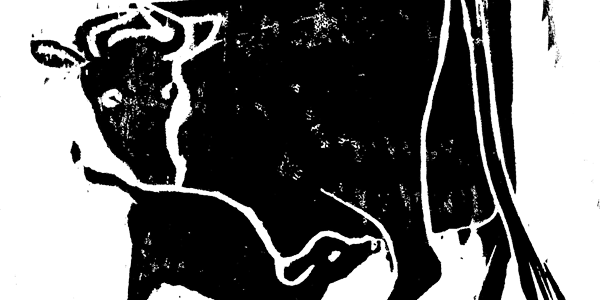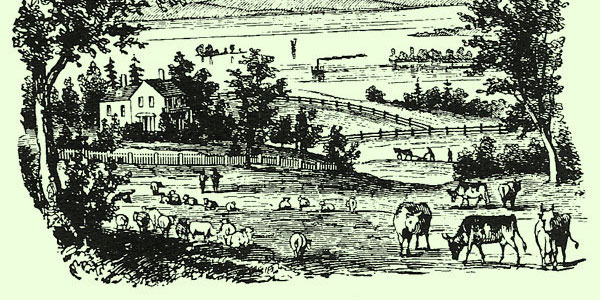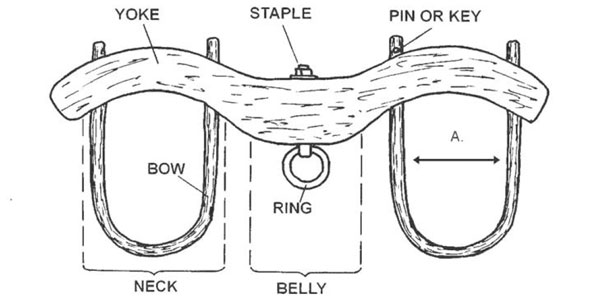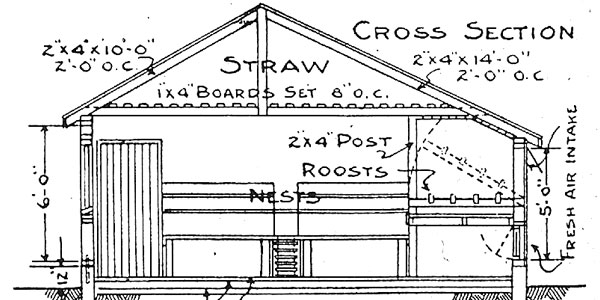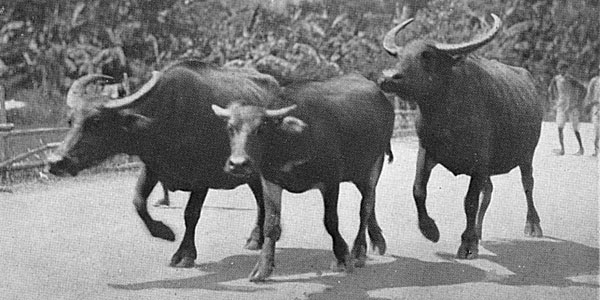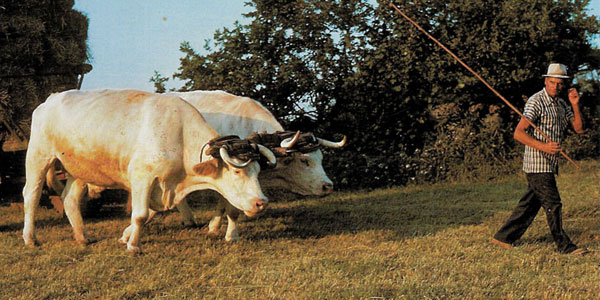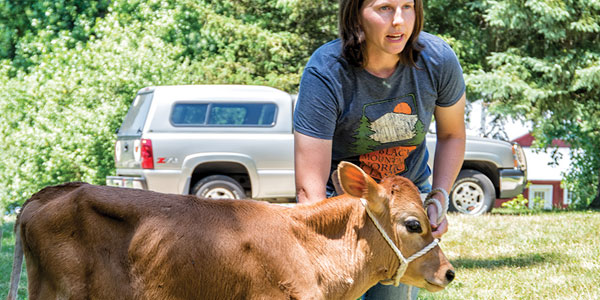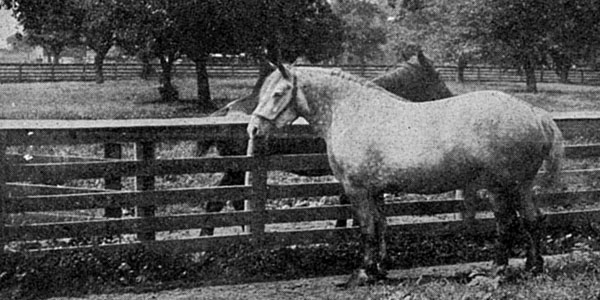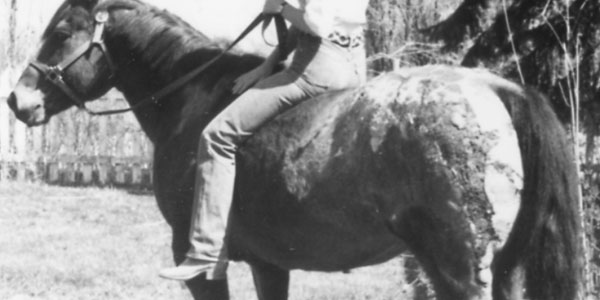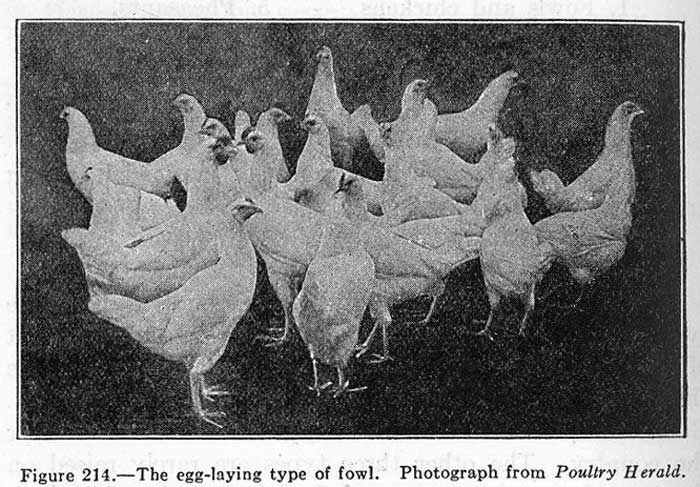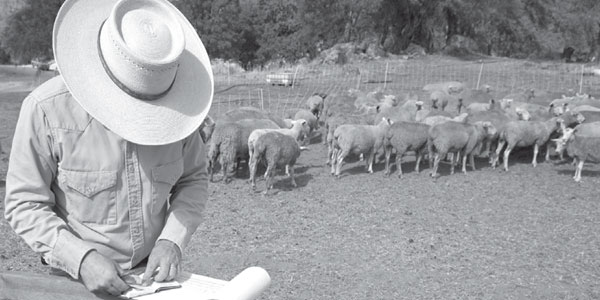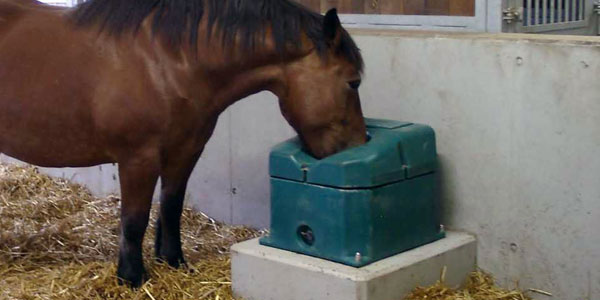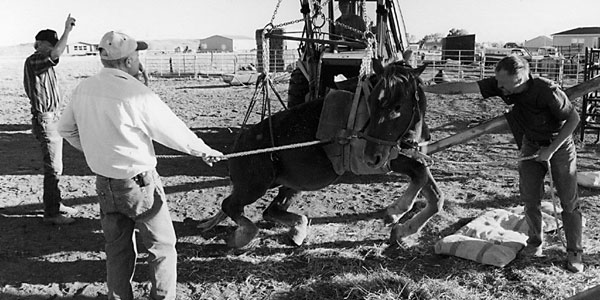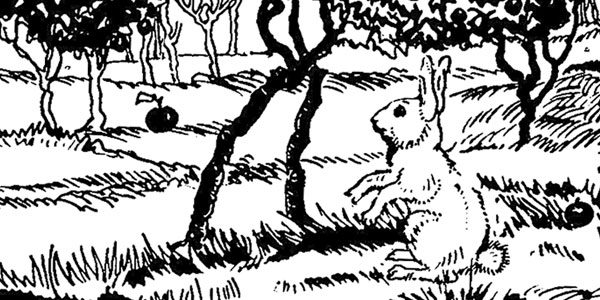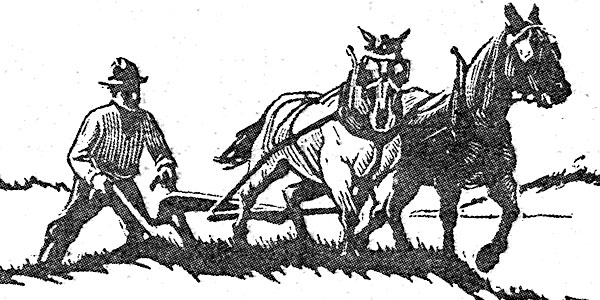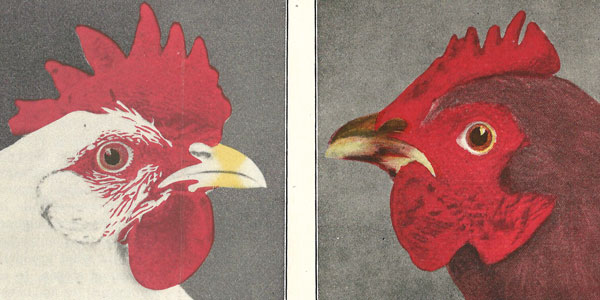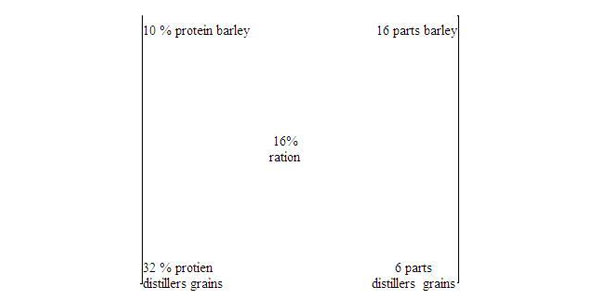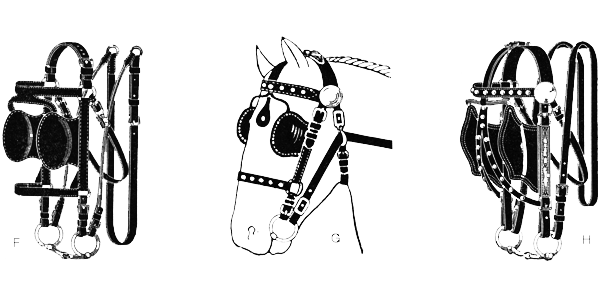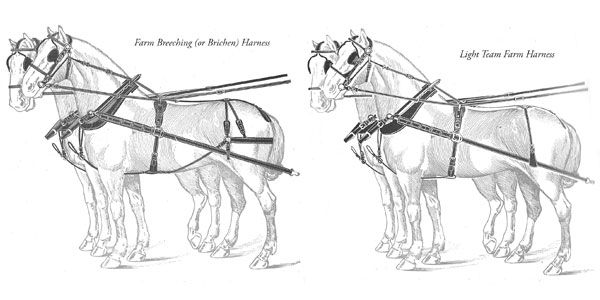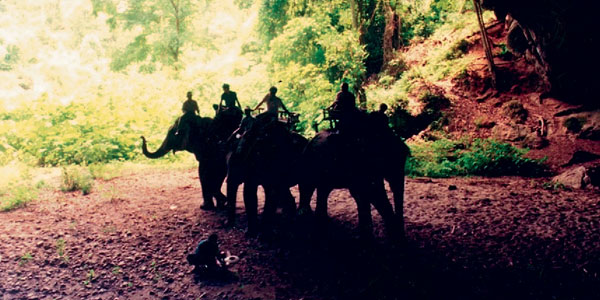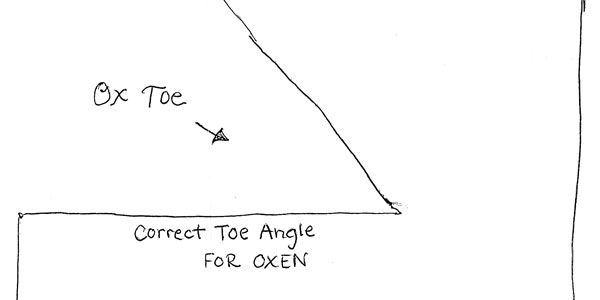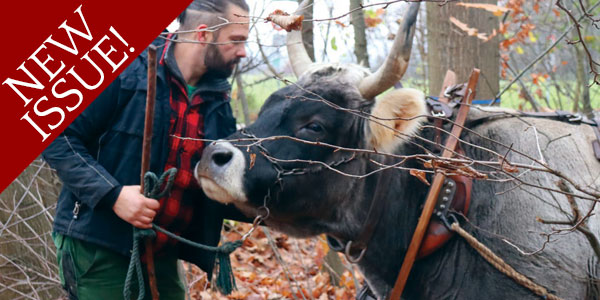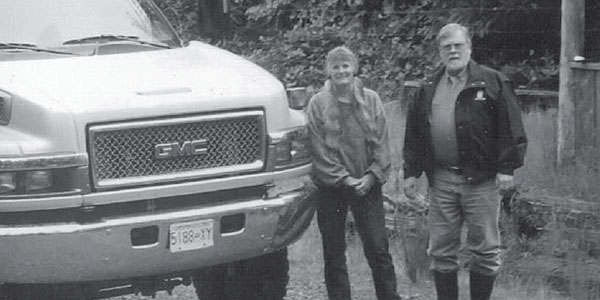Livestock
2011 Ox Teamster’s Challenge: Still Going Strong
2011 really tested our metal. All day there was tension among the Crew, the Oxen, the Teamsters and the Crowd. Why? Hurricane Irene was ever so slowly worming her way up the east coast, leaving havoc in her wake. She was aimed directly at New England and the Cummington Fair. By Saturday (which is known as OX DAY) Irene was so close that the air was deadly calm and the sky an unhealthy yellow-green. All the fair animals were restless, as was the overflow crowd, many of whom were tuned to hand-held technology for updates on Irene’s progress.
A Beginner’s Guide to Selecting Hay
When buying hay for livestock, there are several factors that must be considered besides the price per ton/bale and type of hay (legume, grass or a mix of grass and legumes). Two of the most important considerations are quality (nutritional make-up) and whether the hay is healthy and safe for the animals. A certain batch of hay may have excellent protein levels, for instance, but is still a poor choice if it is dusty or contains patches of mold.
A Brief History of the Cattle Industry
It all started with an experiment at our kitchen table six years ago. We had read that 100% grass fed beef was better for our health than grain-finished beef, that there were “good” fats and “bad” fats, and that the ratios of these fats to each other was also important. The old saying: “You are what you eat” should apply to cattle as well as us, right? So, we tried a simple experiment that would end up changing our lives forever.
A Gathering of Comtois in France
I was soon planning for a stop in the town of Pontelier, the main hub in one corner of the country I had never been to and was bent on exploring: the Franche-Compte. As luck would have it, this region has its very own breed of draft horse, the Comtois. It was to an “exhibition” of this horse that I was heading, although thanks to my lousy French, I was not sure exactly what kind of “exhibition” I was heading to.
A Greenhorn Tries Draft Horses
We have tried a workhorse, and for our needs he has proven quite satisfactory as well as satisfying to use. Thus we feel it is possible for someone with little or no experience to learn to care for and use a horse or a team for farm and woods work, although, obviously, this is not a process to be undertaken lightly. One of the basic aims of the farm operation for us is self-sufficiency, and we thought that the horse would be more efficient than a tractor in achieving this aim.
A Guide to Raising and Marketing Rosé Veal
Here at Providence Farm, we produce what is referred to as “rosé veal,” though we aim to make clear that not all rosé veal is the same. Some rosé veal producers rear their calves in batches, housing them in open sheds on deep straw bedding, away from their mamas, and feeding them on milk or milk replacer, hay, and sometimes grain. We, however, use a more extensive method. Our calves are unconfined, and are born and raised on pasture. They spend their days as part of the cowherd, nursing from their mamas, cavorting with their fellow calves, and grazing on lush grasses and clovers at their leisure. They are never fed grains, nor do they receive growth hormones or antibiotics. It is for these reasons that we call this “Milk & Meadow Rosé Veal.”
A Life With Cattle and Horses
When I was 10 my parents acquired a small acreage in a canyon up a creek near Salmon, Idaho, and 2 years later started buying the neighboring ranch. This was a dream come true, because now our family had cattle and horses. During my teen years I worked on the ranch – irrigating our hayfields with water ditched from the creek, building fence, riding range to look after the cattle – to earn some cows of my own. The annual calf crop from my small herd helped pay my way through college.
A Suggestion for a Honey House
The pen drawings represent my honey house as it stands today. I am not sending it to you because I think it is an ideal honey house by any means, but considering the surroundings it suits me very well. The surface of the ground around the house and bee-yard is perfectly flat and level, so there is no chance to build on two levels, or I would have built it that way. As it is I have tried to have things as handy as possible with everything on one level.
A Year of Contract Grazing
Contract grazing involves the use of livestock to control specific undesirable plants, primarily for ecological restoration and wildfire prevention purposes. The landowners we worked for saw grazing as an ecologically friendly alternative to mowing, mechanical brush removal, and herbicide application.
Additional Notes on Horsepower
If it don’t feel right – check it out! Instinct is a most important applied aspect in every successful teamster’s tool chest. When things seem not to be as they should be, when things feel odd or out of balance, when everything looks a little different to you but you can’t put your finger directly on the change – PAY ATTENTION. Take the time to check the animal’s comfort, the fit of the harness, the buckles and snaps. It could be in the air and they feel it but you don’t.
American Milking Devons and the Flack Family Farm
On a sunny early September day I met Doug Flack at his biodynamic and organic farm, just South of Enosburg Falls. Doug is an American Milking Devon breeder with some of the best uddered and well behaved animals I have seen in the breed. The animals are beautifully integrated into his small and diversified farm. His system of management seems to bring out the best in the animals and his enthusiasm for Devon cattle is contagious.
American Suffolk Horse Association
The homeland of the Suffolk horses is Norfolk and Suffolk counties. It is bordered on the north, east and south by the North Sea and on the west by the Fens. Isolated from their neighbors, the farmers of Suffolk independently developed breeds of livestock to fit their special way of life. The first Suffolk Punch draft horse arrived in North America in 1865, going to Canada. All the Suffolks who were offspring of those imported were registered with England’s stud book until the American Suffolk Horse Association was first incorporated on February 17, 1911, in Illinois.
Andrew Van Ord: Ox Drover
Dad was always a firm believer that the best way to train an animal was real work. As a kid, I always liked to take them out and take them for a walk down the road, and if dad would let me get away with that, that’s what I did. I still tend to do that, but he’s absolutely right: the best thing for training is real work and probably the best real work for them, that I can find, is picking rocks. We’ve got plenty of them around here. You know, you take a stone boat out. We generally kept a horn tie on them if nothing else but an insurance policy, but dad whipped on us very hard to manage the rope correctly.
Are Excessive Calcium Levels Cutting Short the Lives of Your Poultry?
Many poultry nutrition experts now report that feeding excessive amounts of calcium can lead to basically, “loving your birds to death,” giving them too much of a good thing. Excessive calcium can lead to their premature death from kidney failure. If a necropsy was performed, it would indicate that the bird perished from gout, which is an excessive build up in the kidneys, indicating either too much protein or calcium in their diet.
Are You Working Your Horses?
I would imagine that at least for those with draft horses, many may have some intention of working those animals in some capacity on their property. These goals will vary from those who would like to do all the draft work on their place with a horse or team, to those who never plan to do more than wagon or sled rides or perhaps a little hauling of materials around the farm or homestead. My main interest is in thinking through some issues I believe those who really mean to use their draft animals, for farm work or logging or for regular hauling projects, may encounter as obstacles to really achieving those goals.
Are Your Horses Working for You?
“Old timers” are fond of saying that all it takes are lots of long hours in the field, ‘get yourself and the horses sweatin’ and keep them that way.’ It is felt that most training challenges and glitches in the system will work their way out by long hard hours of work. There is certainly something to say for this. However, it is far from the only way. It is my contention, born of a quarter century of experience, that foundation training and good common sense system structure will give us better results. The horse who stands quietly and calmly when needed, regardless of whether he is tired or fresh, is the superior work mate. This is accomplished by well set training and trust.
Ask A Teamster: Driving
I have been questioned (even criticized) about my slow, gentle, repetitious approach “taking too much time” and all the little steps being unnecessary when one can simply “hitch ‘em tied back to a well-broke horse they can’t drag around, and just let ‘em figure it out on their own.” I try to give horses the same consideration I would like if someone was teaching me how to do something new and strange.
Ask A Teamster: Halters Off!
When my friend and mentor, the late Addie Funk, first started helping me with my horses, he suggested that we get rid of my halter ropes with snaps and braid lead ropes on to all the halters permanently. Actually as I think about it, it was more than a suggestion. Knowing him, he probably just braided the new ropes on, confident that anyone with any sense would be pleased with the improvement. In any case, when the task was completed I clearly remember him saying to me, “Now nobody will turn a horse loose around here with a halter on.”
Ask A Teamster: Hauling Horses
For a claustrophobic animal like the horse, being confined to a small box while speeding down the highway at 60 miles per hour is a mighty unnatural experience. Luckily, equines are adaptable animals and are likely to arrive in good condition – if – you make preparations beforehand and take some precautions. Here are some tips to help your horse stay healthy, safe, and comfortable while traveling.
Ask A Teamster: Horse Don’t, Won’t, Can’t Turn
After moving the drop ring on the other side down we went out to the round pen for a test drive. The difference in how she ground drove and turned was amazing – not perfect, but real sweet. With the lines at that level a right turn cue on the line obviously meant go right to her, and a left turn cue meant left. After we drove around for a while with me smiling I couldn’t resist moving the drop rings back up to the line rings – Bam, back to the old confusion.
Ask A Teamster: Nervous Horse
Your horse Frank seems typical of the many horses that I work with and hear about that have learned to associate humans (and certain things humans do with and to them) with psychological and/or physical discomfort. Whenever a horse is not comfortable with things we do around them or ask them to do on the ground, we need to resolve those issues on the ground, not in harness or under saddle. When things are not going well in harness and we cannot get our horses to maintain or return promptly to a state of comfort, relaxation, willingness, and compliance, I feel it is imperative to go back to basic ground work and build a stronger more complete foundation of trust, respect, and accepting us as their kind, gentle and yet assertive leader.
Ask A Teamster: Perfect Hitching Tension
In my experience, determining how tight, or loose, to hook the traces when hitching a team can be a bit challenging for beginners. This is because a number of interdependent dynamics and variables between the pulling system and the holdback system must be considered, and because it’s ultimately a judgment call rather than a simple measurement or clear cut rule.
Ask A Teamster: Round Pen Training
When we ask a horse to follow us in the round pen we can help him succeed by varying things a bit – changing direction and speed frequently, stopping periodically to reward him with a rub (“a rub” or two, not 100), picking up a foot, playing with his tail/ears/mouth, etc. In other words, working at desensitizing or sensitizing him by simulating things he will experience in the future (trimming and shoeing, crupper, bridle over the ears, bit, etc.).
Ask A Teamster: Ten Common Wrecks with Driving Horses
One of the things I’ve learned over time is that the truly great teamsters rarely – if ever – have upset horses, close calls, mishaps or wrecks, while the less meticulous horsemen often do. Even though it may take a few minutes longer, the master teamsters constantly follow a series of seemingly minute, endlessly detailed, but always wise safety tips. Here are 10 of them:
Ask A Teamster: The Bit
I work at a farm that uses their team of Percherons to farm, give hayrides, spread manure, etc. One of the horses gets his tongue over the bit. I’ve been told he’s always done this since they had him. I have always thought: #1. You have very little control, and #2. It would hurt! The horse is very well behaved, does his work with his tongue waving in the air, and sometimes gets his tongue back in place, but at that point it’s too late. They use a snaffle bit. Any suggestions?
Ask A Teamster: Tongue Length
My forecart pole is set up for draft horses. My husband thinks we should cut the pole off to permanently make it fit better to these smaller horses. What would be your opinion? Like your husband, my preference would be a shorter tongue for a small team like your Fjords. The dynamics and efficiency of draft are better if we have our horse(s) close to the load. A shorter tongue will also reduce the overall length of your outfit, thereby giving you better maneuverability and turning dynamics.
Ask A Teamster: Who’s the Boss? part 1
For horses being part of a group and interacting with others in the group is very important for comfort and safety. It is natural and important for horses to both rely on a leader and to have trusted companionship. We can be a friend and companion to our horses, but only if we earn and keep their trust. One of the primary principles and goals of Natural Horsemanship is 100% trust (others are 100% respect and 0% fear). It’s relatively easy to gain a horse’s trust if we use their language and logic and play by horse rules rather than trying to communicate and behave in ways that are natural and seem logical to us as humans.
Ask A Teamster: Who’s the Boss? part 2
One of the primary goals of natural horsemanship is to get our horses to trust us 100 percent. Great horsemen and horsewomen throughout history have known that in order to become truly and completely accepted as a friend, companion, boss, leader, and/or trainer to any equine we must first gain the animal’s trust. In his book, Colt Training, Jesse Beery, the famous 19th century horse gentler/trainer, author, and founder of the Jesse Beery School of Horsemanship states, “The first lesson we give a colt is simply to teach it to have confidence in us and that we are its best friend and don’t intend to hurt it.”
Ask A Teamster: Wolf Teeth
The problem resulting from wolf teeth are due to the bit hammering on them or bouncing over them and banging into the much larger premolar teeth behind. This causes varying degrees of aggravation and pain to the animal. The problems that result range from minor irritation (often unapparent due to the wonderful and tolerant nature of many horses and mules) to dangerous reactions and behavior.
Ayrshire Ambassadors Cooperative
The Ayrshire Ambassadors Cooperative was founded in 2016 by a group of dairymen who want to be outspoken advocates of the Ayrshire breed. Ayrshires are one of the most cost-effective breeds for dairy farmers, as the breed is known for efficiently producing large quantities of high-quality milk, primarily on a forage diet. These vigorous and hardy cows can be found grazing in the sun, rain, and cold while other breeds often seek shelter.
Big Logs at Tarn Hows
Simon and his elder sons Simon, Keith, and Ian, with their Belgian Ardennes horses, work good timber in bad places. The felling and extraction operation at the Lake District beauty spot of Tarn Hows was done in often appalling weather, and in the full glare of publicity. It must rank as one of the most spectacular pieces of horse logging, or indeed of commercial horse work done in these islands in recent years.
Black Pigs & Speckled Beans
As country pigs go the Large Blacks are superb. They are true grazing pigs, thriving on grass and respectful of fences. Protected from sunburn by their dark skin and hair they are tolerant of heat and cold and do well even in rugged conditions. Having retained valuable instincts, the sows are naturally careful, dedicated, and able mothers. The boars I’ve seen are friendly and docile.
Blister Beetles
Blister beetles occasionally cause localized areas of damage within soybean and alfalfa fields. However, the significance of damage to these crops is questionable. This is because the gregarious nature of the more commonly occurring blister beetles limits the area attacked and because soybean and alfalfa plants can compensate for substantial foliar losses. It is in this area that blister beetles may become a major concern. The bodies of blister beetles contain a substance called cantharadin. This chemical is an irritant capable of causing the formation of blisters upon those body tissues exposed to the chemical. Livestock may come into contact with blister beetles via the consumption of alfalfa hay containing dead beetles.
Boer Goats
The introduction of the Boer Goat has stirred up a lot of interest in all sectors of agriculture. The demand for goat meat exceeds the supply; goat meat is the most consumed meat in the world. One of the main points about South African Boer Goats is that out of all meat goat breeds the Boer is the top meat producer whereas in the cattle business you have over 100 breeds of beef cattle that all compete for the beef dollar.
Book Review: Storey’s Illustrated Guide to Poultry Breeds
I absolutely love chickens and ducks and geese! There, I stand exposed. And this book I am reviewing, I love it, too!! It is both a wondrous and wonderful book, especially if you are a poultry fancier who needs to know the what (duck, goose, chicken etc.), why (as in why would you want to raise this breed) and whose-its (as in crazy tidbit info i.e. coloration nomenclature) of individual species – or maybe you just want to be able to see how they are different. As you may note by the copyright date, this is not a new book but it deserves careful attention as a reference volume. It will have a long shelf life. It features well over one hundred excellent color photos and is expertly organized for easy use.
Breeds of Sheep
Cheviot ram • Shropshire ewe • Shropshire ram • Dorset-Horn ewe • Suffolk Down ram • Oxford Down ram • Oxford Down ewe • “Woolless” sheep • Dorset-Horn ram • Hamshire ewe • Rambouillet ram • American Merino ewe • Hardwick ram • Lincoln ram • Ryeland ram • Southdown ram • Rambouillet ewe • Cotswold • Leicester ram • Wensleydale ram • Hampshire ram • Delaine Merino ram
Brood Sows and Their Litters
The brood sow with her litter is becoming such an important factor in the life of our people that world-wide consideration is being given her. One of the most valued of assets on the farm today is the brood sow and the expectancy of her litter. It is therefore necessary that due attention be given this and every other sow in order that she will produce the greatest number of pigs of the best quality the greatest possible length of time.
Building a Shoeing Stock
I recently built a shoeing stock and thought that there may be some others who could benefit from the design information or gain some ideas for construction of a stock of their own design. All the time I’ve owned workhorses, and even saddle horses, frequent hoofcare has been one of these non-pressing tasks which often seems like it can be put off one more day or until the weekend. Then before you know it there are several horses needing attention at the same time. The task of catching up becomes more pressing and in some prolonged cases even seemingly overwhelming.
Butchering Chickens
Some years back I had the pleasure of reviewing Adam Danforth’s outstanding and astounding volumes on butchering meats. Those titles won him the James Beard Award among others. His newest title, Butchering Chickens, follows in the very same astute footsteps. This attractive, well organized handy 175 page book, subtitled A Guide to Human Small-Scale Processing, is published by Storey.
Calves that Don’t Breathe at Birth
Heart rate is one way to tell if the calf is in respiratory distress, since it drops as the body is deprived of oxygen. Normal heart rate in a newborn calf is 100 to 120 beats per minute. Place your hand over the lower left side of the ribcage, just behind and above the elbow of his front leg. If heart rate has dropped as low as 40, the calf ’s condition is critical; he needs to start breathing immediately.
Calving: Delivering Backward Calves
Most calves are born head first, front feet extended. But a few are positioned backward and may not survive the birth process unless you are there to help. The number of backward calves in a herd during a calving season can vary from year to year, and all the factors influencing this presentation are not yet fully understood. While the fetus is growing in the uterus it is quite active and can change positions, especially while still relatively small. The position of a fetus when a cow is pregnancy-checked is not necessarily the position it will be in at the end of gestation when the birth process begins.
Calving: Knowing When to Check a Cow Can Save Calves
Most cows progress normally through the stages of labor; uterine contractions in early labor get the calf aimed toward the birth canal, the cervix dilates and the calf starts through. The calf entering the birth canal stimulates abdominal straining and second stage (active) labor begins – to push him on out. Sometimes, however, the calf does not start into the birth canal and the cow does not begin hard straining. If you don’t intervene, you’ve lost the calf (and the cow, if you don’t get the dead calf out of her). Knowing when to check a cow is crucial – and you have to be watching her to know how long she’s been in early labor.
Calving: Reasons for Pregnancy Losses
After a cow is bred, she should calve about 9 months plus 1 week later (283 days, on average). But sometimes accidents of gestation terminate pregnancy early, or other factors (disease or toxins) kill the developing calf. Immediately after conception, when the tiny embryo is traveling down the fallopian tube into the uterus, it is safe from harmful influences. After it reaches the uterus a few days later, it becomes more vulnerable to problems. The conceptus is called an embryo during the first 45 days of pregnancy; after that, all major organs and body systems have been formed and it becomes a fetus. If loss occurs before 45 days of gestation, it is termed early embryonic death.
Camel Power in Georgia
Last spring we got the bright idea to plow some corn with one of the camels, so we went to the shed and drug out the “Planet Jr. one camel cultivating plow”. My 86 year old Grandfather said “Son, don’t worry about thinning that corn, those camels are going to do a fine job of it, for you!” We plowed corn and I have some video to prove it, and as soon as I quit running over the corn and learned how to “drive the plow” we didn’t lose any more corn!
Cattle Handling Part 1: Basic Cattle Handling
If they understand what you want them to do, and you give them time to figure it out, cattle are very easy to herd. Pressuring and release of pressure at the proper times will encourage them to move (or halt) and to go the direction and speed you desire. The herd will also stay together, moving as a group if you herd them calmly and don’t get them upset and excited. Best results are had when you move them at a walk, controlling the speed and direction of the leaders.
Cattle Handling Part 2: Use Good Cow Sense When Handling Cattle
Cattle are very intelligent, and are just as “trainable” as horses. Like horses, they “reason” differently than humans. Understanding the way cattle think and why they react to you the way they do can enable you handle them in ways that will help rather than hinder your purposes. If you can “think like a cow” you can more readily predict what cattle will do in various situations and be able to handle them with fewer problems.
Cheval de Merens Revisited
In the Fall ’97 issue of SFJ you printed an article on the Cheval de Merens, the all black horse of the French Pyrenees. I was immediately obsessed by their beautiful stature, a very strong draft-type-looking horse with powerful legs and long flowing manes and tails. The article sent me running for maps to locate France and the Ariege Valley, the central location for the Merens. After making contact with the writer of the article and being told of the major Merens horse show in August, plane reservations were made.
Chicken Guano: Top-Notch Fertilizer
Whoever thought I’d be singing the praises of chicken poop? I am, and I’m not the only one. Chickens are walking nitrogen-rich manure bins.
Chicken Money
A great many small farms across North America keep ten to thirty laying hens for home family supply. Some of those folks might be surprised to discover that with a modest investment they could turn, or grow, that ‘sideline’ into additional farm income – but you need to know that it will take planning, an increase in daily chores, and attention to detail. And of course, to further assure success, it would help if you naturally enjoyed poultry.
Collars, Hames and Harness Fitting
Farmers who are good horsemen know everything that is presented here: yet even they will welcome this leaflet because it will refresh their memories and make easier their task when they have to show hired men or boys how to adjust equipment properly. Good horsemen know from long experience that sore necks or sore shoulders on work stock are due to ignorance or carelessness of men in charge, and are inexcusable.
Communicating with Horses
Discipline is a habit which has to be taught, to children as well as to horses. To sit quiet in a school desk is sometimes a challenge for a young child; standing still is the same for a young horse. Discipline is a basic element, but this has to count for everyone. Our way is not by rude manners but by being fair and consistent. This attitude not only helps us while working with the horses, but also in their daily care.
Conserving Rare Southern Livestock
Conserving rare livestock breeds is a challenging venture, and conservation of some of the rarest breeds can be a costly undertaking. Most people who keep rare breeds must balance breed conservation with the need to make a profit. David and Jennifer Ozborn, along with their three sons have an eighty acre farm in Brandon, Mississippi where they work to maintain herds of four rare livestock breeds that are native to the Southeast. Over seven years they have had excellent success in conserving these rare breeds while at the same time keeping their farm in the financial black.
Cookies for Josephine
We calve in January and February, and some years it can be very cold – and we calve the cows in a barn. Most of the older cows go into the barn readily because they’ve been there before. But the first-calf heifers are a different story. Many of them are hard to get into the barn. We solve this problem with a Judas cow – a gentle, older cow who leads the heifers into the barn. Even the wildest or most timid heifer will usually follow another cow. The old cow serves as security for the timid young heifer, and into the barn they go.
Cultivating Questions: A Horsedrawn Guidance System
Market gardening became so much more relaxing for us and the horses after developing a Horsedrawn Guidance System. Instead of constantly steering the horses while trying to lay out straight rows or cultivate the vegetables, we could put the team on autopilot and focus our whole attention on these precision tasks. The guidance system has been so effective that we have trusted visiting chefs to cultivate the lettuce we planned on harvesting for them a few weeks later.
Cultivating Questions: Horsedrawn No-Till Garlic
We were inspired to try no-tilling vegetables into cover crops after attending the Groffs’ field day in 1996. No-tilling warm season vegetables has proved problematic at our site due to the mulch of cover crop residues keeping the soil too cool and attracting slugs. We thought that no-tilling garlic into this cover crop of oats and Canadian field peas might be the ticket as garlic seems to appreciate being mulched.
Cultivating Questions: Overwintering the Work Force
Combining late winter/early spring grazing with pasture renovation seems to work best when we let these sacrifice areas rest for the remainder of the grazing season. If time permits, one or two mowings helps to set back the less desirable grasses and weeds while the sun-loving clover gets established. Applying minerals, such as rock phosphate and lime, along with a mulch of strawy horse manure, also increases the chances for the new seedlings to take off and thrive in these long neglected and infertile patches of the thirty-year-old pasture.
Cultivating Questions: Portraits of Four Horse-Powered Produce Farms
Thanks to the many resources available in the new millennium, it is relatively easy for new and transitioning farmers to learn the business of small-scale organic vegetable production. Economic models of horse-powered market gardens, however, are still few and far between. To fill that information hole, I asked three experienced farmers to join me in tracking work horse hours, expenses and labor over a two-year period and to share the results in the Small Farmer’s Journal.
Cultivating Questions: Social Security and Sprouted Horse Feed
It was important to us that the homemade senior horse feed tasted more like dessert than medicine because one of the purposes of their small grain ration is to serve as a reward for the horses coming in from pasture on their own. Ninety percent of the time they are waiting at the stable doors, or within calling distance of the barn, when it is time to stable them. Without the sprout incentive, our daily labor for stabling the horses would be a lot more than 20 minutes. It takes almost that long just to make the round trip on foot to bring in the horses from the back end of the farthest paddocks.
Curly Horses
Although they are most famous for being hypo-allergenic, Curly horses have many other exceptional features. Nature has provided these horses with a unique heating and cooling system. Their thick curly winter coat repels rain and snow. Underneath, air is trapped near the short hair coat next to the body, keeping them warm. They are able to withstand cold winters, and can stay outside year-round. In the spring, they shed their coats. Their hooves are extremely hard and do not require shoeing. Curlies come in all colours, plus they may also be appaloosa, pinto, tricolour, etc. The coat can range from a crushed velvet look, to a gentle wave, to tight corkscrew curls over the entire body. Their thick manes often appear wavy.
Cy and Don: A Pair of Knowing Oxen
Cy and Don were born to big, rugged cows and were sired by the same bull. Their body type was what we refer to as old fashioned. They had long bodies, deep and wide chests, and thick, straight legs. They were straight along the top of their backs and wide across the forehead. The old ox men would say a team built like Cy and Don were, “square as a brick and smooth as a trout.”
Determining the Age of Farm Animals by their Teeth
Establishing the age of farm animals through the appearance of the teeth is no new thing. The old saying, “Do not look a gift horse in the mouth,” is attributed to Saint Jerome, of the fifth century, who used this expression in one of his commentaries. Certainly for generations the appearance, development, and subsequent wear of the teeth has been recognized as a dependable means of judging approximately the age of animals.
Developing Draft Colts
During October, 1910, The Pennsylvania State College and Experiment Station purchased a group of ten grade Belgian and Percheron colts and one pure bred Percheron for use in live stock judging classes. An accurate record of the initial cost, feeds consumed and changes in form has been kept in order that some definite information as to the cost of developing draft colts from weaning to maturity might be available for farmers, investigators and students.
Developing Organic Wool
Although organic food is becoming common, organic wool is a product in its’ infancy. Markets are small, there are few processing facilities, and regulations haven’t been agreed on. What wool is being produced is coming from meat flocks, not wool breeds. Without regulations, when products are marketed as “Organic Wool” the label means far less than the consumer might assume.
Dexter Cows and Kefir Cheese
We started hand-milking one cow. Now there are three. We are still milking by hand, and love the relationship with our cows, but will have to begin using the milking machine this spring as we add one more cow to the operation. We plan to milk a maximum of six cows. We purchased a 1940s Surge milking machine and assembled the entire unit from new and used parts we acquired from retired dairies in the area. The equipment we needed for the milk cooling room and the cheese room took an entire year to assemble because many of the things needed were just not readily available. With the help of some small dairy equipment dealers and by finding items on eBay, we managed to put it all together, under close scrutiny of the inspectors.
Diatomaceous Earth
At one time, I though diatomaceous earth was an end-all, be-all. But now I realize it’s just another ingredient, or component, of a healthy diet. There are thousands of natural things out there that have benefits for animals. For years I tracked the wild horses here in Owyhee County, to see what they were eating – to try to figure out why they would go from one place to the next. Then I would take samples of the soil and the plants there. If they need selenium, for instance, they tend to seek it out; they’ll go 25 miles to get it. They’ll eat around that area and graze awhile, and maybe eat a little of the dirt, then leave. The same is true when they need manganese.
Do You Want Your Broodmare to Foal Early?
An old saying states, “Patience is a virtue.” In a society where “instant-everything” is the order of the day, this saying is not practiced by many. Some of those who must still practice patience are owners of pregnant broodmares. With a gestation length of 335-340 days, they just have to wait until the appointed time. You may ask, “Is there anything that can be done to reduce the length of a mare’s pregnancy?”
Don’t Forget Ponies
I think a lot of people that have huge 2000 lb. plus horses would be happier with 900- 1300 lb. ponies. Some use half draft and half light horse, but a pony of draft type would weigh about the same as some of these crosses and be thicker built and more compact, thus easier keepers. That means a lot if you make a living with them as I do. I log with them and keep the better logs for lumber and sell the rest as firewood. I sell abut 150-200 cord a year and cut and sell year round.
Draft Collars and How To Size Them
It is difficult to accurately measure a horse’s neck without fitting. In other words, there are so many variables involved in the shape and size of a horse’s neck that the only accurate and easy way to size the neck is to use several collars and put them on one at a time until fitting is found.
Driving: Juniper’s Training
A final sneak peak at the Second Edition of Lynn R. Miller’s “Training Workhorses / Training Teamsters.” Today’s excerpt, “Driving: Juniper’s Training,” is from Chapter 11, “Starting and Training Older Horses.”
Duck Raising
Duck raising is conducted successfully both as a side issue on general farms and as a special business on a large scale. The Pekin is the best breed for duck farming. Many breeds are very ornamental as well as useful, making the breeding of real interest wherever there are natural facilities for keeping waterfowl. The rearing of ducks for market on a large scale requires extensive capital and experience. A location on a stream of running water is essential for the best results in duck farming.
English Suffolks
A point of interest for your readers is that the “Donhead Hall” Stud at “Coombe Corner Farm” is the home of the first imported American bred Suffolk stallion in the U.K: “Garrettland’s Golden Eagle,” the sale of which the breeder Sam Yoder of Oakland, Maryland, reported on in a previous issue of the Small Farmer’s Journal.
Environmentally Friendly Fly Control
The battle against flies is constant, but there are ways to reduce these costly and irritating pests — without toxic chemicals. There are several types of pest flies, with different habits and behavior, so a combination of tactics is usually most effective when trying to eliminate or reduce flies. House flies and stable flies (the latter are aggressive biters, tormenting horses and cattle) breed in manure and rotting organic matter such as old hay and bedding. Horse flies and deer flies breed in swampy areas and black flies breed in flowing water.
EPM: A Frustrating Disease for Horse Owners
The clinical signs of EPM vary widely among horses. This is because the protozoa can cause damage at various locations in the CNS. The most common signs are: incoordination, weakness, muscle atrophy, and cranial nerve damage. The incoordination and weakness, characteristic of spinal cord disease, are common findings in horses with this disease. The signs involve only one side of the body. Many times what is seen is a weak spastic, swaying, and possibly stumbling gait. Horses can exhibit what appears to be a low-grade lameness. In severe cases, the horses may fall and are unable to get up. The muscle atrophy associated with EPM is not symmetrical and is most apparent over the hindquarters. Cranial nerve damage is manifested by facial paralysis, drooping ear, lazy eyelid, head tilt, and difficulty eating and drinking. Horses with EPM appear bright and alert with no fever. They have a normal appetite, even though they may have problems eating.
Erskine’s Shires
John and Heather Erskine of Monroe, Washington, have been synonymous with the best of Shire horses since before I can remember. They have helped wagon loads of people with their horses and horse adventures. Up at last year’s Sandpoint, Idaho, show John shared a photo album with me that set me right down and I twisted his arm to let me share some of his outstanding pictures with you.
Expanding the Use of the Heavy Draught Horse in Europe
“La Route du Poisson”, or “The Fish Run,” is a 24 hour long relay which starts from Boulogne on the coast at 9 am on Saturday and runs through the night to the outskirts of Paris with relays of heavy horse pairs until 9 am Sunday with associated events on the way. The relay “baton” is an approved cross country competition vehicle carrying a set amount of fresh fish.
Faith
After living in Ohio for twelve years and being very home-sick, I was ready to get home, spend time with my family and friends, and get back to the farm. The question arose, can one really come back home? When I lived in Ohio and asked myself that question the answer was adamantly, yes! Now that I was here… I wasn’t so sure.
Farm Sheep Raising for Beginners
Sheep naturally inhabit areas that are high and dry. The animals, however, will thrive on any land except that which is wet and swampy. The fine-wool breeds of sheep especially exhibit a preference for the lands that are drier, whereas there are one or two of the British breeds that are particularly adapted to the lowlands. The industry of raising sheep has been carried on with success in areas that have tropical temperatures with low rainfalls, but rearing the animals in regions of high temperatures and high rainfall has not been generally successful.
Feeding Elk: Winter Work for the Belgians
Doug Strike of rural Sublette County is spending his second winter feeding wild elk in nearby Bondurant, Wyoming. Strike is supplementing his logging income as well as helping his team of Belgian draft horses to keep in shape for the coming season. From May to the end of November he uses his horses to skid logs out of the mountains of western Wyoming. I found the use of Doug’s beautiful Belgian team an exciting example of appropriate technology.
Feeding Turkeys
Turkeys 6 to 10 weeks old are ready to go on the range, which should be clean and separate from range used for chickens. Adequate shelter is very important. A good practice is to place feeders on clean ground, away from the roost, and to move the feeder each week. The roost should be moved 3 or 4 times during the growing season, as sanitation is of the greatest importance.
Fescue Toxicosis in Horses
Tall fescue is the most widely grown forage in the southeastern United States. Fescue toxicosis is the result of an endophytic fungus on tall fescue. A toxin produced by this endophytic relationship is absorbed into the digestive system of livestock that forage on the fescue. Unfortunately, the toxin remains active in cured hay as well. Research data from Experiment Stations in the southeast show serious production losses occurring in cattle. It is now also known that fescue toxicosis is causing critical reproductive problems in pregnant mares. Mares receiving most of their daily nutritional needs from fungus infected fescue tend to be agalactic, producing little if any milk. Although their foals are usually born live, they are often weak. Most do not survive long, due to lack of food intake or absence of the immune protection normally provided by the mare’s colostrum.
Fighting Flies
Flies are the most common and troublesome external parasites of horses. During the warmer months of the year no region is free of these pests. Flies cause much irritation, and can also spread disease. Large numbers can result in excessive blood loss. Fly bites can also result in skin allergies due to hypersensitivity reactions. The annoyance from flies can disrupt grazing; horses may run frantically to get away from biting flies, or seek out shady areas to swish and stomp. Flies can also distract a horse when you are riding or working with him; he may pay more attention to flies than he does to you.
Finnsheep: Sheep for all Economic Seasons
Another consideration for the Trimburs was health and ease of care. Heidi says, “Finnsheep, as a breed, won this one without contest! They are smaller, super-friendly, have no horns to worry about and no tails to dock. They are hardy, thrive on good nutrition and grow a gorgeous fleece. I love to walk out in the pastures with them. They all come running over to say hello and some of our rams love to jump on our golf cart and “go for a ride” – it is hilarious!
First Time Hitching
More from Lynn R. Miller’s highly anticipated Second Edition of “Training Workhorses / Training Teamsters.” Today’s excerpt, “First Time Hitching,” is from Chapter 12, “Follow Through to Finish.”
Fjordworks: Horse Powered Potatoes Part 1
This is the account of how one farm put more horse power into the planting, cultivation, and harvesting of its potato crop. Ever since we began farming on our own in 1994 one of our principle aims has been the conversion of our farm operation to live horse power wherever feasible. This has meant replacing mechanized tools such as tractors and rototillers and figuring out how to reduce human labor as we expanded upon the labor capacity of our work horses.
Fjordworks: Horse Powered Potatoes Part 2
These types of team implements for digging potatoes were the first big innovation in horse powered potato harvesting in the mid-19th century. Prior to the horse drawn digger the limitation on how many potatoes a farmer could plant was how many the farm crew could dig by hand. The basic design of these early diggers works so well that new models of this type of digger are once again being manufactured by contemporary horse drawn equipment suppliers.
Fjordworks: Market Gardening with a Single Horse
Market gardeners who already have an up and running tractor-powered operation and think they might want to explore transitioning to live horse power are often attracted to the idea of starting with a single horse. The single horse can also be a viable option for creating a mixed power system where the tractor is used for heavy tillage and the horse is used for secondary tillage, cultivation, and other light draft tasks around the farm. And for the complete beginner looking to get started in market gardening and working with horses, a single horse has a lot of appeal.
Fjordworks: The Barefoot Farmer Part 1
There is an old saying among cowboys that; “A man who can’t shoe his own horse or shoot his own dog shouldn’t by rights have neither.” If I try to apply this standard to my own farming life, the kernel of truth I discover lies in the observable fact that any horse owner who trims her own horse’s feet will be that much more intimately attuned to the life force of that animal.
Fjordworks: The Barefoot Farmer Part 2
To be an effective trimmer of horse hooves one needs to spend a lot of time simply looking at horses. It is important not only to study their feet but to understand how the grounding action of the feet is affecting everything in the mass of body above. The adept trimmer needs to observe the horses from all angles both when they are standing at rest and while in they are in movement.
Fjordworks: Zen and the Art of Training the Novice Teamster Part 1
The first step to a successful training session is to decide ahead of time what it is you wish to accomplish with your horse. In the wild the horses in a band require the strength of a lead horse. Your horse needs you to be that strong leader, but she can’t follow you if you don’t know where you want to go. On the other hand, we need to retain some space within ourselves for spontaneity to respond to the actual physical and mental state of our young horse on any given day.
Fjordworks: Zen and the Art of Training the Novice Teamster Part 2
In the practice of Zen sitting meditation, a special emphasis is placed on maintaining a relaxed but upright sitting posture, in which the vertical and horizontal axis of the body meet at a center point. Finding this core of gravity within can restore a sense of well-being and ease to the practitioner. This balanced seat of ease is not all that different from the state of relaxed concentration we need to achieve to effectively ride or drive horses.
Fjordworks: Zen and the Art of Training the Novice Teamster Part 3
By waking up so fully to the tasks at hand we are empowered to be more present, more available, and thus able to offer a compassionate and skillful response to the needs of our horses even as we ask them to accomplish heavy work on the farm. It is not up to the horses to trust us; it is up to us to prove ourselves worthy of their trust. What the horses can offer to us are new avenues to freedom and resilience, sustainability and hope.
Foal Diseases: Pneumonia
Foals are more likely to get a respiratory disease in their first six months than any other disease. They are more prone to respiratory diseases than adults. In one study, about one-quarter (22.2 percent) of all foals had a respiratory disease. Pneumonia was responsible for most deaths (16 percent) up to six months of age in one study. Foal pneumonia is the major respiratory disease causing economic loss due to death, poor growth and treatment cost. Pneumonia, an inflammation of the lungs, is a common disease in foals of all breeds up to six months of age. A complex disease, pneumonia has many predisposing factors.
Goat Lessons
Goats are one of the most incredible homestead animals. They are usually affectionate and sweet, with such funny and smart personalities. Goats give so much goodness for the amount of hay and grain they eat. One cow weighs 1,000 lbs. or more and gives 4-8 gallons of milk a day. One goat weighs around 130 lbs. and gives around a gallon — can you see the difference in feed conversion?
Goats are Good Business
When Larry and Judith Schad moved to their farm with a two-story log home, they bought goats for their three children to use for 4-H projects. What began as fun, three years later encouraged the family to buy a show herd of Alpine goats, and now that herd and its offspring consistently win awards at the Hoosier Classic and the American Dairy Goat Association national show.
Goats Save the Ranch
Eating invasive vegetation that compete for the scant water supply and inhibit the growth of grass, goats are a biblical-age solution to a modern-day scourge. To restore the land, 1,300 goats mimic the buffalo herds that once grazed the region – breaking the soil’s crust, stomping decadent grasses, knocking over dead trees, fertilizing with their droppings and embedding seeds. And, all the while, the goats voraciously defoliate and ultimately kill the water-guzzling Tamarisk.
Grafting a Foal onto a Nurse Mare
The easiest time to persuade the mare to adopt the orphan is very soon after she herself has given birth. If her own foal dies at birth or soon after, she is more inclined to accept a substitute baby than she would a few days or weeks later; her maternal instincts are strongest right after birth. A mare that has lost her own foal generally makes the best nurse mare, for you can usually convince her to accept and raise the orphan as her own. Failing that, you can sometimes convince a mare to raise an orphan along with her own baby, but this takes more work, and some diligent monitoring for awhile.
Grafting Isaac
With what was best for Sarah now done, we had the foal to worry about. Isaac was nowhere near ready to wean and badly underweight already. He flat refused to take Foal Lac, a milk replacer for foals. He did eat some hay and grain which likely was what was keeping him alive. He was a sorry looking little horse now and we wondered, should we put him down too? Is he old enough to make it? A day or two went by and I laid awake thinking about him at night. About the sad little foal that walked around and around the barn all day long looking for his mother. Then I hit on an idea and went to talk to our neighbor Ammon Weeks the next day.
Grooming Work Horses
The serviceability of the work horse may be increased or decreased according to the care which is bestowed upon him. If he is groomed in a perfunctory fashion his efficiency as an animal motor is lessened. On the other hand, if he is well groomed he is snappier and fresher in appearance and is constantly up on the bit.
Growing Green Feed for Poultry
Most permanent pasture plants are small-seeded and rather slow in becoming established. Use of these pastures during the year of seeding should be delayed until the plants are firmly rooted and growing vigorously. Turning birds into a perennial pasture too soon after seeding may result in poor stands as many plants will be killed by trampling and others will be pulled out by the grazing birds. Late fall grazing of new seedings should be avoided. It usually is necessary to mow new perennial pastures once or twice during the first year to control weeds. This mowing should be done when the weeds are flowering or before seeds develop. The cutter-bar of the mower should be set three or four inches above the ground to cut the weeds with a minimum of injury to the young forage plants.
Haltering Foals
In these photos I am demonstrating with a four month old stud colt, Ben, who has been fully imprinted at birth. There are two values to these photos. One is to show how you might halter a new born foal (granted Ben is a little large) and the other is to demonstrate the incredible strength of the imprint training. Ben has not been handled for three months. Keep in mind that I have approached Ben in an eighty-acre pasture and his mother has wandered off.
Hand Plucking Poultry
I confess that I am cold-hearted and cheap. Though I love raising poultry, I hate spending time and money anywhere but on my little farm. So I process at home. If you are only raising a few birds for yourself, say 25 or 30 at a time, I recommend having a party and doing it all by hand. My journey backward from machines to hands started with a chance encounter with a Kenyan chicken grower visiting the United States. He finishes 15,000 broilers each year.
Happ’s Plowing: A Chance to Share
Dinnertime rolled around before we could get people and horses off the field so that results of judging could be announced. I learned a lot that day, one thing being that people were there to share; not many took the competition side of the competition very seriously. Don Anderson of Toledo, WA was our judge — with a tough job handed to him. Everyone was helping each other so he had to really stay on his toes to know who had done what on the various plots.
Harnessing the Future
En route to a remote pasture where the Belgian draft horses, Prince and Tom, are grazing, we survey the vast green landscape, a fine mist hovering in distant low lying areas. We are enveloped in a profusion of sweet, earthy balance. Interns and other workers start their chores; one pauses to check his smart phone. Scattered about are many animal-powered rustic implements. This rich and agriculturally diverse, peaceful place is steeped in contrasts: modern and ancient.
Harper on Mares
Researchers made multiple 30-minute observations weekly of each mare-foal pair noting aggressive behavior, such as head threats, bites and kicks. They also studied non-aggressive behavior, and spatial relationships. Foals were studied with their dams as sucklings and after weaning up to 6-months of age. Foals were weaned at 4 months of age.
Hay Making with a Single Horse Part 1
For the last ten years, I have made hay mostly with a single horse. This has not necessarily been out of choice, as at one time I had hoped to be farming on a larger scale with more horses. Anyway, it does little good to dwell on ‘what if ’. The reality is that I am able to make hay, and through making and modifying machinery, I probably have a better understanding of hay making and the mechanics of draught.
Hay Making with a Single Horse Part 2
From reading the Small Farmers Journal, I knew that some people are equally happy with either model, but because McCormick Deering had gone to the trouble of developing the No. 9, it suggests they could see that there were improvements to be made on the No. 7. Even if the improvement was small, with a single horse any improvement was likely to increase my chance of success.
Hay Making with a Single Horse Part 3
In parallel with making hay on the ground, nearly every year I have also made some hay on tripods. The attraction of this method is that it only needs one day of good weather to dry the grass sufficiently before it is put on the tripods, and then the hay takes very little harm no matter what the weather, usually coming out green, dry and smelling of hay two weeks later when it can be baled or stacked.
Hay Making with a Single Horse Part 4
Over the last few years of making hay, the mowing, turning and making tripods has settled into a fairly comfortable pattern, but the process of getting it all together for the winter is still developing. In the beginning I did what everyone else around here does and got it baled, but one year I decided to try one small stack. The success of this first stack encouraged me to do more, and now most of my hay is stacked loose.
Haying With Horses
If the reader is considering the construction of a barn we encourage you to give more than passing thought to allowing the structure of the gable to be open enough to accommodate the hanging of a trolley track. It is difficult or impossible to retrofit a truss-built barn, which may have many supports crisscrossing the inside gable, to receive hay jags. At least allowing for the option in a new construction design will leave the option for loose hay systems in the future.
Heritage Breed Broiler Chickens
While the heritage breeds overcome the shortfalls of the Cornish-Rock Cross (CRX) and similar modern hybrids, they come with their own drawbacks. They do not approach the rapid growth rate, low feed conversion rates, and low production costs of the CRX, but there is a lack of information as to which breed or breeds might serve as a potential alternative for niche markets. Thus, our proposed solution was to raise a variety of heritage breed chickens on pasture, to gain a sort of foothold regarding expected growth considerations and production costs.
Heritage Breed Meat Chickens
The question of why one ought to consider raising heritage meat chickens can be approached, I think, from two different angles: farm-based reasons for the actual raising of heritage birds, and the marketing advantages that heritage birds offer for the small farmer. Heritage chickens are a distinctly niche product, and niche production is a boon to the small farm. To be sure, pastured poultry generally is a niche product, but one that is becoming more and more common in many local markets. By opting specifically for heritage birds we further differentiate ourselves and our farm.
History of the Block Horse
Until 1994 these horses had open reign on the Suffield military base in southeastern Alberta, moving freely across one of the largest block of native prairie in the world. The Government had expropriated the land in 1941 from the ranches who had established successful operations more than thirty years earlier. It was then used by the British military for training. Up to the mid-1960’s the horses on the British Block were loosely managed by local ranchers. During this time plenty of good old line Quarter horse, Thoroughbred and other breeds, as well as sound usable ranch horses were turned out. In about 1965 the military fenced the base, cutting off access to the herds for local ranchers. From then until the roundup on 1994, the horses survived unmanaged. They started out as high quality stock and natural selection did its thing, resulting in phenomenal horses.
Hitching Horses To A Mower
When hitching to the mower, first make sure it’s on level ground and out of gear. The cutter bar should be fastened up in the vertical or carrier position. This is for safety of all people in attendance during hitching.
Hog Housing
When farrowing time comes the last of February or the first of March in the northern sections of the country, the sows and the young pigs will be better off in a good weather-tight house, such as the one shown above. This is the sort of farrowing house that keeps the young pigs warm and free from cold draughts that quickly end their lives. Besides, it has a system of ventilation that admits fresh air without drafts and prevents condensation that quickly coats the walls with water and frost.
Horse & Stable Management
It is more difficult to keep some horses in a respectable condition than others. The slab-sided, upstanding type of draft horse requires more grooming than the more compact, chunky individual. The latter is usually an easy keeper in other ways than grooming. It is not considered good practice to groom too heavily during shedding time, for the new coat is generally a trifle coarse if the old hair is removed too quickly. All grooming should be done when the horse is dry, especially thorough cleaning and grooming to remove dirt, sweat, and falling hair, otherwise sore shoulders will follow.
Horse Breeding
This is an excerpt from Horse Breeding by M.W. Harper, a Dept. of Agriculture Bulletin from January 1928. In breeding horses the perfection of the animals selected should be carefully considered. Occasionally stallions are selected on the basis of their pedigree. Such practice may prove disappointing, for many inferior individuals are recorded merely because such […]
Horse Hays
What is a horse owner to do when hay is in limited supply and/or very expensive? Drought has resulted in an extremely short supply of hay in some areas in recent years. Naturally, hay prices increase in these situations. Extremely wet weather can also negatively impact horse owners. These conditions make it difficult to make good-quality hay. Moldy hay should not be fed to horses. Horse owners have several management alternatives in these situations.
Horse Labor Instead of Tractors
Three different parcels of land were committed for a series of tests to directly compare the impact of tractors and horses on the land. One side of each parcel was worked only with horses and the other only with tractors. There were measurable differences between each side of the worked areas; the land’s capacity to hold water and greater aeration were up to 45cm higher in areas worked by horses as opposed to tractors.
Horse Progress Days 2013: A View from Both Sides of the Clouds
As I drove south in a rental car from Champaign to Arcola, and began to transition into the landscape stewarded by local Amish communities, subtle shifts began to appear in the land use patterns. Of course, the first noticeable change was that the farms had horses – and lots of them – big drafts for work in the fields, saddle horses, trotters for the buggies, and minis and ponies to haul the kids around in carts and to give first lessons in the joys and responsibilities of horsemanship.
Horsedrawn Dairy
Mr. Davis said he doesn’t make any claims to environmentalism, although his business methods might look like it. He uses glass bottles and horse power because they are economically sound. He farms organically, although he is not interested in buying into ‘organics’ or its politics. He doesn’t tout ‘natural’ on the label. “My customers see the farm, they see the milk, they taste the milk, they come back. It’s that simple. I don’t promise them that it will cure cancer or prevent it. I don’t promise them that it is going to put the ozone back,” he said. “And, I don’t promise them that it’s going to make them feel any better tomorrow than they feel today. I just put good, healthy milk on the market at a reasonable price, and I farm in a conservative method that is not polluting.”
Horselogging in Yewdale
Set in the heart of the Lake District National Park, Tarn Hows Wood lies on the eastern flank of Yewdale. The valley is characterized by Yewdale Fell to the west, with Yewdale Beck flowing in headlong rush from its cascades in Tilberthwaite Gill, to its tumbling rapids in the lower reaches of the valley before flowing into Coniston Water. The flat valley bottom is a miniature agricultural patterned landscape consisting of small hedged fields, punctuated by small groups of trees.
Horses & Mules 1938 Feeding Practices
By breeding stock that meets the farmer’s needs, and by developing rations to maintain animals and produce energy at less cost, Experiment Stations have made farm power more economical and efficient. To a large extent, the ability of work stock to meet the challenge of mechanical power is a result of this research.
Horseshoeing Part 1A
Horseshoeing, though apparently simple, involves many difficulties, owing to the fact that the hoof is not an unchanging body, but varies much with respect to form, growth, quality, and elasticity. Furthermore, there are such great differences in the character of ground-surfaces and in the nature of horses’ work that shoeing which is not performed with great ability and care induces disease and makes horses lame.
Horseshoeing Part 1B
Since the horse is useful to man only by reason of his movements, his foot deserves the most careful attention. The horse-shoer should be familiar with all its parts. Fig. 3 shows the osseous framework of the foot, consisting of the lower end of the cannon bone, the long pastern, the two sesamoid bones, the short pastern, and the pedal bone.
Horseshoeing Part 1C
The horn capsule or hoof is nothing more than a very thick epidermis that protects the horse’s foot, just as a well fitting shoe protects the human foot. The hoof of a sound foot is so firmly united with the underlying pododerm that only an extraordinary force can separate them. The hoof is divided into three principal parts, which are solidly united in the healthy foot – namely, the wall, the sole, and the frog.
Horseshoeing Part 2A
As there are well-formed and badly formed bodies, so there are well-formed and badly formed limbs and hoofs. The form of the hoof depends upon the position of the limb. A straight limb of normal direction possesses, as a rule, a regular hoof, while an oblique or crooked limb is accompanied by an irregular or oblique hoof. Hence, it is necessary, before discussing the various forms of the hoof, to consider briefly the various positions that may be assumed by the limbs.
Horseshoeing Part 2B
If we observe horses moving unrestrained over level ground, we will notice differences in the carriage of the feet. Many deviations in the line of flight of hoofs and in the manner in which they are set to the ground occur; for example, horses heavily burdened or pulling heavy loads, and, therefore, not having free use of their limbs, project their limbs irregularly and meet the ground first with the toe; however, careful observation will detect the presence of one or the other of these lines of flight of the foot.
Horseshoeing Part 2C
The wear of the shoe is caused much less by the weight of the animal’s body than by the rubbing which takes place between the shoe and the earth whenever the foot is placed to the ground and lifted. The wear of the shoe which occurs when the foot is placed on the ground is termed “grounding wear,” and that which occurs while the foot is being lifted from the ground is termed “swinging-off wear.” When a horse travels normally, both kinds of wear are nearly alike, but are very distinct when the paces are abnormal, especially when there is faulty direction of the limbs.
Horseshoeing Part 3A
An examination should be made while the animal is at rest, and afterwards while in motion. The object of the examination is to gain accurate knowledge of the direction and movements of the limbs, of the form and character of the feet and hoofs, of the manner in which the foot reaches and leaves the ground, of the form, length, position, and wear of the shoe, and distribution of the nail-holes, in order that at the next and subsequent shoeings all ascertained peculiarities of hoof-form may be kept in mind and all discovered faults of shoeing corrected.
Horseshoeing Part 3B
Besides good, tough iron for the shoe, we need an anvil with a round horn and a small hole at one end, a round-headed turning-hammer, a round sledge, a stamping hammer, a pritchel of good steel, and, if a fullered shoe is to be made, a round fuller. Bodily activity and, above all else, a good eye for measurement are not only desirable, but necessary. A shoe should be made thoughtfully, but yet quickly enough to make the most of the heat.
Horseshoeing Part 4A
According to the size of the horse and his hoofs the nails should be driven from five-eighths to an inch and five-eighths high, and as even as possible. As soon as a nail is driven its point should be immediately bent down towards the shoe in order to prevent injuries. The heads of all the nails should then be gone over with a hammer and driven down solidly into the nail-holes, the hoof being meanwhile supported in the left hand.
Horseshoeing Part 4B
Forging is that defect of the horse’s gait by reason of which, at a trot, he strikes the ends of the branches or the under surface of the front shoe with the toe of the hind shoe or hoof of the same side. Forging is unpleasant to hear and dangerous to the horse. It is liable to wound the heels of the forefeet, damages the toes or the coronet of the hind hoofs, and often pulls off the front shoes.
Horseshoeing Part 5A
All shoes whose ground-surface is provided with contrivances to prevent slipping upon snow and ice are called winter shoes. These various contrivances are produced by several processes called “methods of sharpening.” All methods may be gathered into two groups, – namely, practical sharp-shoeing and impractical. Only the first will be considered.
Horseshoeing Part 5B
Hoof nurture comprises all those measures which are employed to keep hoofs healthy, elastic, and serviceable. The object of hoof nurture is to lessen or entirely remove all these injurious consequences of shoeing and stabulation. It comprises, therefore, not only the proper shortening of the hoofs every five to six weeks, but careful attention to cleanliness and moisture. Both are insured by dry straw and daily picking out and washing the hoofs.
Horseshoeing Part 6A
The boundary between health and disease of the hoof is difficult to determine, especially when we have to deal with minor defects of structure or shape of the hoof. Ordinarily, we first consider a hoof diseased when it causes lameness. However, we know that diseases of the hoof may exist without lameness. Therefore, a hoof should be regarded as diseased or defective when it deviates from what we consider as normal or healthy, whether the service of the animal is influenced by it or not.
Horseshoeing Part 6B
Wounds of the velvety tissue of the sole or of the podophyllous tissue of the wall, caused by nails which have been driven into the hoof for the purpose of fastening the shoe, are usually termed “nailing.” We distinguish direct and indirect nailing; the former is noticed immediately, the latter later.
Horseshoeing Part 6C
The expression “corns” is applied to nearly all bruises of the pododerm of the posterior half of the foot, with the exception of the frog, which are apparent to the eye as yellowish, reddish, or bluish-red discolorations of the horn of the sole and white line. The surface of the pododerm (fleshy leaves and villi) is chiefly involved, and almost without exception there is rupture of small blood-vessels and an outpouring of blood between the pododerm and the horn.
Horseshoeing Part 7A
The upright or stumpy hoof is that form in which the quarters, with relation to the toe, are too long (too high). The wall at the toe stands very steep, in some cases perpendicular, and is strongly worn away by standing and travelling. It may arise gradually from neglect of the hoofs of horses running barefoot. It may arise from excessive shortening of the toe in relation to the quarters.
Horseshoeing Part 7B
According to location we distinguish toe-cracks, side-cracks, quarter-cracks, and bar-cracks. Those cracks which affect only the upper border of the hoof are called coronary cracks; those which are limited to the lower border of the hoof are sometimes designated low cracks (plantar cracks); while those which are continuous from one border to the other are called complete cracks. If the crack passes through the entire thickness of the wall to the sensitive tissues underneath, it is called a deep or penetrating crack, in contradistinction to the superficial crack.
Horseshoeing Part 7C – Shoeing Mules, Asses & Oxen
The shoeing of oxen is essentially different from that of horses, because the foot of the ox is cloven (split), the long pastern, short pastern, and hoof-bone are double, so that, instead of one hoof or claw, there are two upon each foot, distinguished as outer and inner. Each claw consists of wall, sole, and bulbs; the frog is absent. The wall is considerably thinner than that of the horse’s hoof, the sole is thin, and the bulbs are low. For these reasons the shoe designed for a claw must be thin, but wide.
How a New Jersey Woman Breeds Squabs
I first got the idea of the squab business from a gentleman who boarded with us who used to raise pigeons. Then I happened to see Mr. Rice’s advertisement of the Plymouth Rock Squab company in the Philadelphia Inquirer and answered it. I wanted to know just what I had to do to raise squabs for market before I purchased any birds. I hardly knew what a pigeon was and had never seen a squab. After carefully reading Mr. Rice’s Manual I decided to give the business a try. I started April 1, 1921, All Fool’s Day. We thought we were a little foolish too.
How Big Should A Draft Horse Be?
As evidenced by our letters and the frequent comments of contributors to this magazine, the question of size in draft horses is a hot issue. I suppose we’d all like to think that it’s a contemporary subject, one which did not trouble people back when horses were the norm. The BREEDER’S GAZETTE gathered the opinions of the most respected Draft horsemen of the 1910’s on the subject of how big a draft horse should be and we’ve reprinted them here. As you can see the subject has provided controversy for a long time and I’m sure it will continue.
How Horses Cope with Cold Weather
Horses readily adapt to winter weather. Cold temperature in itself is not a problem for a horse if he’s had a chance to prepare gradually by growing a winter coat as fall temperatures drop. Wind and wet weather are the factors that can chill a horse. In windy regions, horses need some type of shelter to protect against the wind chill that can whip away body heat.
How to Choose a Cow
Not every farmer or dairyman can qualify as an expert judge of cows, but every herd owner can pick high and profitable producers by sticking to certain principles. It’s a matter of pedigree, production and type or form. But only an estimated one out of every 20 dairy cows is purebred and registered, with a pedigree. The number of cows on which there are production records is only slightly larger than that. Hence most dairymen and farmers choose a cow on looks alone, that is, on her type and form at certain key points of the body.
How To Dry Up A Doe Goat
You are probably thinking why would I want to dry up a doe? If the plan is to rebreed the doe, then she will need time to rebuild her stamina. Milk production takes energy. Kid production takes energy, too. If the plan is to have a fresh goat in March, then toward the end of October start to dry her up. The first thing to do is cut back on her grain. Grain fuels milk production.
How To Keep and Milk a Cow
The family milk cow has followed the small farmer through the ages and lives on yet today. She comes in many colors, sizes and dispositions. As with any animal, she comes with the dignity of her own personality and characteristics. Every cow I have ever had or milked has been unique in her own way. Some I have loved and some, well, not so much.
How To Select a Sound Horse
An understanding of the desirable and undesirable conditions found in horses, together with a knowledge of their relative values, will enable the purchaser to select a better animal, with a considerable saving of time, inconvenience, and expense. A thorough examination for the various forms of blemish, vice, faulty conformation, and unsoundness in a horse is absolutely essential if serviceableness is to be secured, and a definite method of procedure should be adhered to in making the examination, which should correspond to the order in which the various steps most conveniently present themselves.
How to Shear
The real trick in shearing isn’t learning the pattern of the shearing strokes, which lessens the time involved in removing the wool, but in immobilizing sheep by the various holds that give them no leverage to struggle. A helpless sheep is a quiet sheep. Rendering sheep helpless cannot be done by force alone, for forcible holding makes them struggle more. Try to stay relaxed while you work.
Hula Hoops & the Driving Horse
I, like many before me, had just entered that gray foggy area where those more timid, or could it be more experienced, fear to tread. I had a thoroughly terrified horse who had no interest in harness or cart, and many knowledgeable horse people told me I had ruined her forever. To find my way out I would have to reach deep inside both myself and my mare, and in the process discover that no matter what people said, it could be done.
I Really Don’t Remember Much of March
“There it is!” I smack the table and point at the computer screen, where pictures of edema-stricken sheep enhance an article on ruminant parasites. “Barber pole worm,” I read, “is a blood-sucking parasite found in wet pastures. The first thing to be done is take the flock off the affected area and put them on uncontaminated grass.” Okaaayyy. It’s Winter. Like that’s gonna happen. I take down as many notes as I can and tape the scrap envelope to the fridge. “Visible. Lives in the abomasum. Can survive outside of host for 2-3 months. Lives in the bottom four inches of grass. Can be found in water droplets. Will lie dormant until host is vulnerable, as in pregnancy or Winter. Resistant to most commercial parasitizes.”
Ice, Horses and a Lesson Learned
Just inside the barn door hangs a coil of blue and white rope, and a big scary lesson. The rope is one of those things that doesn’t have a specific job, yet does about everything. It has been used to drag logs, pull cars out of mud, guide a falling tree in the right direction, or be threaded through the come-along on butchering day. It was the first thing I grabbed when Jacinth, our filly, went through the ice.
Icelandic Sheep
I came to sheep farming from a background in the arts – with a passion for spinning and weaving. When we were able to leave our house in town to buy our small farm, a former dairy operation, I had no idea that the desire to have a couple of fiber animals would turn into full time shepherding. I had discovered Icelandic sheep, and was completely enamored of their beauty, their hardiness and their intelligence.
Icelandic Sheep for the Small Farm
Icelandic sheep belong to the group of sheep known as the Northern European Short-tails, a group of relatively primitive sheep that have in common, as you’d expect, their short tails that never need to be docked, and their origin in countries and regions of northern Europe, including Iceland, the Baltic states, the Faroe Islands, Finland, Norway, Russia, Sweden, Shetland and south through Scotland. The sheep of Iceland were brought to the island by the Vikings in the 8th – 9th century. There they make up a substantial percentage of the agricultural output of the country, and are a commercial production breed.
Idaho Horse Logging Short Course 1985
Roads and productive forests make horse logging efficient and economical. Horse logging is not at all uncommon in Northern Idaho. The University of Idaho in Moscow is therefore a logical place to conduct a Horse Logging Short Course. The University of Idaho also has a 7,000-acre experimental forest dedicated to experimentation and trial of new and innovative approaches to forestry. It is managed as a working forest producing about 2 million board feet of timber each year. Harold Osborne is the manager of the experimental forest and organizer of a two-day horse logging short course held in Moscow on October 11-12, 1985.
In Defense of Goat Cheese
Chevre is a lovely thing. It’s delicious, can be fluffy, spreadable, buttery, a little tangy and a perfect companion to a dollop of honey and a hunk of crusty bread. It’s also what people think of as goat cheese. Every time I do a tasting, I realize how many folks aren’t really acquainted yet with the beauty of aged and bloomy-rind goat cheeses. So of course I like to add in a lovely Crottin or Valencay inspired cheese to the mix. These goat cheeses are generally aged about 2-3 weeks and showcase a natural mold rind that is edible. These are my favorite of goat cheeses. They are also the least familiar.
In Praise of the Beef Cow
Humans have been raising cattle for thousands of years. The early ancestors of present-day cattle were tall, dark-haired bovines called Aurochs, roaming over what is now Europe. Early people hunted cattle for meat like we hunt deer and elk today; wild cattle were the main diet of Stone Age man. Eventually some of our ancestors captured cattle and tamed them, about 10,000 years ago. The tame cattle provided a handy supply of meat and hides, without having to hunt them. Then man discovered he could also hitch cattle to a cart, plow or wagon; oxen were used for transportation long before horses were. Cattle and sheep were domesticated before horses, probably because they were easier to catch.
Interpreting Your Horse’s Body Language
The person who works closely with horses usually develops an intuitive feel for their well-being, and is able to sense when one of them is sick, by picking up the subtle clues from the horse’s body language. A good rider can tell when his mount is having an off day, just by small differences in how the horse travels or carries himself, or responds to things happening around him. And when at rest, in stall or pasture, the horse can also give you clues as to his mental and physical state.
Introducing Your Guard Dog To New Livestock And Other Dogs
When you introduce new animals to an established herd or flock, you should observe your dog’s reactions and behavior for a few days. Since he will be curious anyway, it is a good idea to introduce him to the new animals while he is leashed or to place the new animals in a nearby area.
Irish Dexter Rose Veal
“Farm to Fork” food programs are a revival of the past. Big Horse Ranch & Little Cattle Company is now involved in developing “Old School” free raised Irish Dexter rose veal. We are trying to replicate ranching as it was 100 years ago. This is not a fast paced business venture; it does allow us to best use our ranch to provide old style food for those who are seeking food that has a history of quality.
Is Your Horse Ready for Spring?
Owners want the best for their horses as demonstrated by the amount of money they spend on feeds, facilities, tack, equipment and veterinary services and supplies. Therefore, it is amazing that some owners who want to do things right for their horses use them improperly. As spring approaches, thousands of horse owners are chomping at the bit to hit the trails and show rings. Whoa! A horse owner needs to wait a minute and take stock of the horse’s condition.
Jacob Sheep On Our Farm
Jacob sheep serve a vital role on our farm. They provide wool, meat, sheep skins and farm income. Lambs go to market, quality breeding stock is sold to other Jacob breeders, and wool is taken to a fiber mill. To add to the value they bring in and the products they provide, our Jacobs also bring grace and beauty to our farm. I have cared for our flock for seven years now, and have come to know their seasons. The original purpose of Jacob sheep on our farm was to provide high quality natural color wool. And indeed, today, care is taken in the selection of new rams to slowly improve the flocks fleece quality. Jacobs have soft, open, low lanolin wool that is well suited to process at home. My wife, friends and neighbors are quick to pick up certain ewe’s fleece that they particularly like to take home.
Javas: An Ideal Homestead Bird
Java temperaments, laying abilities, and meat quality have been a tremendous help for us in interesting potential new breeders. These birds are very calm and easily handled while still being a very active breed. They are excellent foragers and do well in the barnyard. Hens lay large rich brown eggs and many are good mothers. Young cockerels make excellent table fare. The size of Javas also makes them a very desirable bird. Roosters average about nine and a half pounds while hens tend to be about six and a half.
Lamb Slaughtering & Cutting
On account of their size, lambs lend themselves for use on the farm more readily than do other farm animals. They can be consumed in a short period of time and for this reason are not generally cured. Also because of the fact that mutton is a drier meat and does not contain much soft fat, it does not lend itself to curing as well as do other meats.
Lambing
Driving tepee truck is a humble job, beneath the dignity of a lamber, but it suits me fine. The ten-mile drive through the hills to Sunrise Camp is beautiful in the early morning. This is the season between snow and flowers, when the first soft green of grass and moss spreads over the hills with a promise. The long hard winter is over. Next month the ranch will be literally carpeted with wild flowers — bird’s-bills, dog tooth violets, crocuses, wild irises, evening primroses and forget-me-nots — a tangled, riotous fulfillment in colors no artist could paint. Beautiful, yes, but I like this season better. For everywhere I look I can see the stir of new life — in the tender, pale green of the hills, rolling on and on to meet the horizon; in the deepening green of slender, silver-trunked quaking aspen; in the sweet, sharp-scented fragrance of pine and spruce and fir, as the sap runs through their branches.
Large Black Hog Piglets from off the Internet
Yesterday afternoon I found an ad on Craigslist (a computer classified ad service on the internet) and immediately emailed the ad’s poster (a ‘poster’ is the person who did the listing). Large Black Hog piglets for sale, they were 8 weeks old and located not too far away (well, about an hour and a half, but you gotta do what you gotta do to get piglets). I was so elated when the guy emailed back last night – you have to act fast on Craigslist – he said he had 13 available. I told him I’d come in the morning, cash in hand.
Laying Out Fields for Plowing
There are four general plans, or methods of plowing fields. These are: (1) to plow from one side of a field to the other; (2) to plow around the field; (3) to plow a field in lands; and (4) to start the plowing in the center of the field.
Lessons Learned: Life with Livestock Guardian Dogs
We were first introduced to livestock guardian dogs (LGD’s) by our friends the Dillon’s. Will and Debbie milk goats in the coastal mountains of South Tillamook County, and we were visiting them to pick out our first Nubian doe in the late 1990’s. We were greeted by Pete, a Great Pyrenees pup, and an older female Pyrenees. Our first impression was astonishment both at the size of the dogs and at the fact that they were so calmly living in the midst of goat herd pandemonium! We have over the years been treated to many stories of Pete and his companion LGD’s and their escapades.
LET DOWN!
On all but one day I got more milk from 3 quarters with Ivan’s help than Ruby allowed me from 4 before his help. At this point in her lactation she has a ‘hold back’ capacity of about 6.5 lbs. on 3 quarters. So, it seems that if I milk her out solo and leave all the let down for Ivan, he is going to get about a gallon of very creamy milk held back special for him. Ruby changed my mind – no need to leave milk for the calf in the early weeks of separation. Mama has it handled – she makes sure that he is going to get his share!
Let’s Talk About Harness
The breast collar style harness is by far the favored harness style amongst carriage drivers. Fitting of a neck collar is a crucial study and a simple, well-fitted breast collar is by far to be preferred over a poorly fitted neck collar. If you are new to neck collars, plan to do a lot of experimenting, spend some money, and try to find someone knowledgeable who can help you. Fitting breast collars is a simple matter, and one breast collar will fit a great variety of horses.
Light on the Land, Heavy on their Feet – Horse Logging
With his team of horses in hand, Spencer first started cutting firewood off Forest Service land and selling it to the public. In 1985, after four years of cutting firewood by horse logging, the Forest Service, seeing what he was capable of doing, put up a small timber sale in a campground. Today, the Forest Service and land owners see horse logging as a nice tool in managing the land.
Lineback Cattle
Cattle with lineback color patterns have occurred throughout the world in many breeds. In some cases this is a matter of random selection. In others, the markings are a distinct characteristic of the breed; while in some it is one of a number of patterns common to a local type. Considering that livestock of all classes have been imported to the United States, it is not surprising that we have our own Lineback breed.
LittleField Notes: Changing of Seasons
We are blessed who are active participants in the life of soil and weather, crops and critters, living a life grounded in seasonal change. This talk of human connection to land and season is not just the rambling romantic musing of an agrarian ideologue. It is rather the result of participating in the deeply vital vocation that is farming and knowing its fruits first hand.
LittleField Notes: Making Your Horses Work For You Part 1
The practical everyday working of horses and mules in harness has always been at the heart of what the Small Farmer’s Journal is about. And like the Journal, a good horse powered farm keeps the horses at the center: the working nucleus of the farm. All the tractive effort for the pulling of machines, hauling in of crops, hauling out of manures, harvesting and planting is done as much as is practicable with the horses.
LittleField Notes: Making Your Horses Work For You Part 2
Every beginning horse farmer at some point will find himself in need of procuring that first team. After land, this is certainly one of the most critical purchasing decisions you will make in the development of the farm. The animals you choose can make your farming glow and hum with moments of blissful certainty, or contribute to frustration, bewilderment, loss of resolve, and God forbid, horses and people hurt and machines wrecked.
Livestock and Predators: No Easy Answers
Since we’ve raised sheep commercially, we’ve been committed to trying to live with the predators in our environment. Over the years, we’ve lost just a handful of sheep — several to coyotes, at least one each to mountain lions and rattlesnakes, and four in one night to a neighbor’s dog. Mostly, though, our commitment to nonlethal predator protection tools has worked. A combination of electric fencing, livestock guardian dogs, sheep selection and grazing management has allowed us to co-exist with the predators in our environment.
Living With Dairy Goats
Dairy goats are different than other types of livestock, even Angora goats. They are independent, unimpressed by efforts to thwart their supremacy of the barnyard (or your garden), and like to survey the world from an elevated perch. Though creatures of habit, they will usually pull off some quite unexpected performance the minute you “expect” them to do their usual routine. For the herdsperson who can keep one step ahead of them, they are one of the most enjoyable species of livestock to raise and ideal to small farms.
Living with Goats
It was chore time on our small, bush Alaska farm, and since the winter days are short, we use a lantern both evening (as it was now) and morning in the barn. My younger sister, Hannah, and I were working out there when this little incident happened which shows that goats truly love a good joke, especially when it falls on their owners in a poorly lighted barn.
Logging with Animals
I’ve tried the D-ring harness but it doesn’t work for me. It’s nice because there’s no weight on the neck, but if a horse runs or even trots the end of the tongue whips violently in every direction. That should be mentioned in some of the articles about them. I know you say a work horse gets his work done at a walk. I don’t own any woods but have to travel quite a distance to get to some of the woods I cut in. It would take a long time to walk all the way. And going up hills I let them go at a full run. It’s much easier to get up the hill.
Logging with Oxen in New Hampshire
I hear time and time again at the outset of each workshop, “I don’t know anything about working oxen.” And I say, “There is no more fun than being a beginner.” Myself and the staff get great pleasure in sharing our knowledge of working steers and oxen. For as long as there are those interested in working cattle, the men I mentioned early in this article will not be forgotten. I believe there will always be cattle worked on small farms and in the woods.
Maggie – A Very Special Cow
When Dani was 5 years old she enjoyed “helping” grandma with the ranch chores every chance she got. Even though her mama and siblings still lived in town at that time, she wanted to come to the ranch and see the animals. She loved the cattle, but was a little afraid of the big ones. One spring day when she was tagging along with me to feed the horses and water the cows in the field above our house, she told me she wanted to pet a cow or calf.
Maud the Mule
Maud was the name of one of the family mules that Paps held in very high esteem. The incredible feats of Paul Bunyan’s ‘Babe the Blue Ox’ paled in comparison to Pap’s stories about Maud. Maud was obedient. She responded to the quietest “Gee” and “Haw” and “Whoa, Maud.” Maud was a hard worker and would work for hours on end for the simple cost of a little oats or grass, a little kindness, and a good drink of water now and then. The pride Paps had in that mule – long dead by the time I arrived on the scene – rivaled the pride he showed for any grandchild. And Maud had earned that admiration.
Meishan Pigs
At one time raising hogs was a staple for the American small holder farm. Nicknamed “mortgage lifters” for their ease of raising and profitability, family farms ritually harvested their hogs each year around Thanksgiving. But today the American small holder farm is finding it harder and harder to justify a presence for pigs in their livestock profile. Meet the Meishan Pig. Docile, bordering on sedentary, passive, medium sized, hyper-productive and delicious. The choice of ancient Chinese Emperors of the past may be the right choice of many future American small holder farmers.
Melva and Marla
When my husband Lynn and I were first married, in 1966, we had a dairy. Several of our Holsteins had twins that year and we had fun naming them. I particularly remember Vim and Vigor – fraternal twins, a bull calf and a heifer calf. The next year we moved to our present ranch to raise beef cattle, and even though we had a lot more cows, none of the beef cows ever had twins – until 1977, the spring that our kids (Michael and Andrea) turned 9 and 7.
Methods of Feeding Turkeys
In a survey made before starting this experimental work, it was found that there was considerable confusion in the minds of many poultrymen as to the relative efficiency between the mash and pellet methods of feeding. A review of the literature on turkey nutrition and methods of feeding failed to disclose any studies which would be of assistance in answering this question. As a result, an experimental program was outlined to investigate several methods of feeding growing turkeys.
Midwest Ox Drover’s Association
Twenty four years ago, the students in Tillers International’s Oxen Basics class, enjoying their time together, decided to return the following year as a reunion of sorts, and so the Midwest Ox Drovers Association (MODA) was born, along with its Annual Gathering. The Gathering is held the weekend after Father’s Day at Tillers International in Scotts, MI. A weekend devoted to making new friends and greeting old friends while interacting with working cattle, the Gathering is always a great time. On Saturday night of the Gathering, after dinner, a number of us sat down for a moderated roundtable discussion. I had jotted down a few questions on the proverbial “back of an envelope,” powered-up my recorder, and we were off to the races.
Milk Fever
Cows that milk largely and test richly are always susceptible to milk fever, and the more fleshy, vigorous, and strong the condition in which they freshen, the more liable they are to be attacked with milk fever, which usually makes its appearance at some time during the first 48 hours after calving. Where this disease was formerly greatly to be dreaded in that 98 per cent of the cows which were attacked by it died, little is thought of it nowadays, so seldom does a cow die because of it.
Milking the Cow Correctly
There is not much to be gained by feeding a cow unless you are determined to get all the milk and butterfat the feed makes. You cannot get all the milk and butterfat the feed makes unless you milk the cow right. A large percentage of cows are not milked right, so a large loss of milk and a large loss of butterfat result. It is as important that cows be well milked as it is that they be well fed.
Mini Horse Haying
The first mini I bought was a three year old gelding named Casper. He taught me a lot about what a 38 inch mini could do just by driving me around the neighborhood. He didn’t cover the miles fast, but he did get me there! It wasn’t long before several more 38 inch tall minis found their way home. I presently have four minis that are relatively quiet, responsive to the bit, and can work without a lot of drama.
Montana Muleskinner Jack Eden
Jack vividly remembers working with his uncle in what is now the Selway/Bitterroot Wilderness in the early 1940s, breaking green colts for local ranchers in the spring and summer, packing hunters into the rugged mountains and then trailing the string of mules and horses from Paradise, Idaho, to winter pastures in Hot Springs, Montana, a three-day trip in late November, along gravel roads where cars were the exception not the rule. In a modern world where men have walked on the moon and even children now crawl the World-Wide Web from desktop computers, Jack has remained true to his early love – working with horses and mules.
Mule Drawn Wrecker Service
This will only add fuel to those late night discoursians about the relative merits of horses over mules or viciversy. Is the horse the smarter one for hitching a ride or is the mule the smarter one for recognizing the political opportunity which this all represents? In any event these boys know what they are doing, or should, so don’t try this at home without horse tranquilizers. Remember that politics is a luke warm bowl of thin soup.
Mule Truths
The main object, or is supposed to be, of this letter, is to reply to the article on page 66 of Winter 2002 issue of SFJ on “The Reluctant Mule.” I agree with your statement “we do not agree with this article.” I would go a bit farther than Justin E. Miller’s statement. If the man said that about my span of mules I would put him in the middle of a 3-abreast hitch hooked to a plow and lay on the whip to the one in the middle.
Multiple Hitching with One Set of Lines
A great deal of interest has been shown the last several years in using multiple hitches in horse farming, especially in spring fieldwork. The question often asked is how to keep it simple and easy in driving and assembling the hitch as far as lines are concerned. We demonstrated our method at the Horse Progress Days at Mt. Hope, Ohio in 2003 and have been asked numerous times how we drove four, six and eight-horse hitches using only two lines.
My First Team of Workhorses
In A Greenhorn Tries Draft Horses, a greenhorn (myself) tried a single work horse named Lady for farm and woods work. It was probably natural that, having acquired some experience with one horse, I should want to see what it was like to use two. Perhaps it is more exciting to see a good team pull together, and there is the added challenge to the teamster of making certain that the horses pull smoothly rather than seesaw.
My Goatscaped Lawn Turned Farm
The logical and fun solution to vegetation management for us has been employing goats. We do not have the time, nor the income to support mechanical means of clearing brush. Our goat cost averaged about $100 each — a much smaller upfront investment. In addition, the goats can do some work while we are occupied with our day jobs. Above all, we believe utilizing goats instead of traditional mechanical and chemical means impacts our local biodiversity in a positive way. We want plant species that naturally grow here to flourish and provide food and habitat for wildlife.
My Journey to Becoming a Fiber Farmer and Mill Owner
I heard through the fiber-vine that the mill I used was shutting down because the owner was retiring. After much hemming and hawing, my husband and I decided to purchase the equipment. I created a business plan, secured an equipment loan, and moved everything to our small farming town of Halsey, Oregon. The retired miller, Janelle, has been an amazing mentor. After the last year and a half, I can safely say that I now understand my equipment and how to get it to process fiber at its best.
Needed Conservation of Domestic Waterfowl Breeds
I was truly shocked to read that the majority of the domestic ducks and geese that I was familiar with have severe population problems! There are six breeds of ducks and four breeds of geese that have numbers so low that they have been designated to be critically endangered. In addition to this disgusting revolution, there are ten more breeds that fall into the Rare and Watch categories.
New Trends in Small Farm Livestock
Change is inevitable. Over the past 40 years we have seen body types of beef, sheep, and hogs go from short legged and blocky, to longer legged, leaner, longer, and larger animals. People want meat that is healthier, less fat, and still tasty. Ranchers and farmers want to raise the animal that will fit the criteria, make the most profit with the least of problems (disease and vet costs), and for it NOT to be a “fad.”
New York Horsefarmer: Ed Button and his Belgians
In New York State one does not explore the world of draft horses long before the name of Ed Button is invariably and most respectfully mentioned. Ed’s name can be heard in the conversations of nearly everyone concerned with heavy horses from the most experienced teamsters to the most novice horse hobbyists. His career with Belgians includes a vast catalog of activities: showing, pulling, training, farming, breeding, and driving, which Ed says, “I’ve been doing since I was old enough to hold the lines.”
New York Organic Grazing Dairy
Our farm, here in the center of New York State, consists of 101 acres, about 90 in grass, the rest some woods and swamp. It is inhabited by forty-six jersey cows, twelve breeding ace heifers, one bull, and because it is calving season — an increasing number of calves. Also, four Belgian mares and a couple of buggy horses. Last, and possibly least — the farmer, farmer’s wife, and five grown children.
Northeast Animal-Powered Field Days 2008
The steady, rainy drizzle on Friday afternoon, September 26th, did not dampen spirits nor participation, as Animal-Power devotees from across the Northeast came to the 2008 Northeast Animal-Power Field Days in Tunbridge, Vermont, to gather around teams, to ask questions, and to watch and learn. Although it did not rain on Saturday and Sunday at the Tunbridge Fairgrounds, Hurricane Kyle and flood warnings throughout the Northeast created significant challenges for folks thinking about making the trip. This may have dampened the attendance levels, but certainly not the spirits of those who did come out. The workshops covered a huge variety of topics and were led by people with expertise in sustainable farming practices, renewable energy, working with draft animals, and issues around food policy.
Nova Scotian Head Yoke
Because the animals push the load with their foreheads, there are several factors that affect draft. One of the most important is that the steers need to have short thick necks so that there is less tendency for the neck to curve or sway. This is why the preferred breeds for oxen in Nova Scotia are Hereford crosses, most often Hereford x Durham. The angle of draft is controlled by a pole, or wooden tug, that is attached to the yoke with two adjustable lengths of chain. The angle with which the tug meets the yoke can be adjusted so that when the steers push into the load, the draft neither forces their heads up too high nor down too low. Like all draft animals, they need a constant angle of draft that allows them to lift the load.
Now Let’s Talk Hope
According to the Livestock Conservancy, the Arapawa goat derives from the extinct Olde English milch goat that would have been brought to the country by English settlers. Historic records show that goats of that breed were released in 1777 by European colonist Capt. James Cook on Arapawa Island, known today as Arapaoa Island, located off the northern tip of the South Island of New Zealand. Although they eventually went extinct in the U.S., the breed thrived on Arapawa Island.
O Where, O Where have the Honeybees Gone?
Hundreds of new chemicals are released every year in the U.S., most of them with little testing. Furthermore, some chemicals that do get tested are tested by the company that manufactures them, in biased and unscientific conditions. Researchers on the subject of CCD are still combing through lists of newly released chemicals pertaining to agriculture, attempting to find ones that are used in countries that have CCD, but are banned in Canada, Mexico, France, and Italy. This type of research is more difficult than it might sound, because there is no one comprehensive list of all these chemicals.
ODHBA 2016 Plowing Match
The Oregon Draft Horse Breeders Association hosted their 50th Anniversary Plowing Match at the Yamhill Valley Heritage Center in McMinnville, Oregon on April 9, 2016. Small Farmer’s Journal was lucky enough to attend and capture some of the action to share.
Olde Tyme Swine
Usually the keeping of hogs in any large number on the farm is not profitable. Like many other things, it is confined to sections of the country where it is made a special business. Still, it is well on most farms at least to have a few to eat up the garbage, or the offal from the dairy, and I will endeavor to state what I believe is the best method of raising them, and the kinds best suited for the purposes of the average farm.
On the Anatomy of Thrift Part 2: Harvest Day
On the Anatomy of Thrift is an instructional series Farmrun created with Farmstead Meatsmith. Their principal intention is instruction in the matters of traditional pork processing. In a broader and more honest context, OAT is a deeply philosophical manifesto on the subject of eating animals. Harvest Day is the second in the series, which explores the ‘cheer’ that is prepared on the day of slaughter, and dives deep into the philosophy and psychology of our relationship to animals.
On the Anatomy of Thrift Part 3: Fat & Salt
On the Anatomy of Thrift is an instructional series Farmrun created with Farmstead Meatsmith. Their principal intention is instruction in the matters of traditional pork processing. In a broader and more honest context, OAT is a deeply philosophical manifesto on the subject of eating animals. Fat & Salt is the third and final video in the series. It is the conceptual conclusion to the illustrated, narrated story that weaves throughout the entire series, and deals instructionally in the matters of preserving pork.
On the Anatomy of Thrift: Side Butchery
On the Anatomy of Thrift is an instructional series Farmrun created with Farmstead Meatsmith. Their principal intention is instruction in the matters of traditional pork processing. In a broader and more honest context, OAT is a deeply philosophical manifesto on the subject of eating animals.
On the Trail of Justin Morgan
In all probability the “Morgan type” existed before Justin Morgan came to Vermont, in the results of crossing an Arab strain on basic New England stock. What Justin Morgan brought – the one element that fused all the rest and crystallized the type into a lasting great family – was personality. Some call it “spirit” and believe it to be akin to the factor that makes human beings dominant among other beings. Anyway, the Morgan still stands as a symbol of vigorous horse personality, the true blood always declaring itself – usually through the look in the eyes, an intelligent appreciation of people who understand.
On-Farm Meat Processing
The demand for fresh, local meat products – with no taint of industrial process – is absolutely staggering.
One Farmer’s Guide to Raising Ducks for Meat
Ducks offer a wonderful option for the small-scale poultry keeper. They are hardy, fast-growing, present a ready market, and are much less subject to price-conscious shoppers than staple meats like chicken or beef. And chefs adore them. Ducks are good foragers, easy to herd, producers of copious amounts of fertilizing manure, and make nice pond ornaments (try that with chickens!). What follows is not intended to be an exhaustive guide to raising ducks for meat, but rather a record of our experience. That said, we feel that this experience counts for a lot. While there are certain things that will necessarily be left out on account of this, I would argue that a farmer’s first-hand account is more valuable than a researcher’s idealized theory any day.
Oregon Draft Horse & Mule Breeders Association 50th Anniversary Plowing Match
We Millers were invited to attend the Fiftieth Anniversary Oregon Draft Horse and Mule Breeders plowing match at the Yamhill County Heritage Center in McMinnville. I was one of the judges (along with Michael Webster). Kristi took photos, some of which you see on these pages. It was a splendid day, perfect weather and a well organized event with lots of spectators.
Oregon’s New/Old Plowing Match
After a hiatus of more than a decade, the Oregon Draft Horse community has a full-fledged Draft Horse and Mule Plowing Competition once again. Organization president Duane Van Dyke was quite excited about the conversion back to competition from the long standing ‘demonstration’ play days that have been held over recent years. This year’s May event featured a whole lot of animals and a great crowd of participants and spectators all enjoying the emerald green beauty of Champoeg State Park.
Ostrich Eggs for Breakfast
“We gather the ostrich eggs which weigh about 3 and ½ pounds each,” says Angelica. “We also help get the ostrich chicks in their pens. I help Grandpa by collecting the money from the fair customers when we take our stand wagon to the local fairs. We sell ostrich burgers, ostrich hot dogs, ostrich jerky, ostrich steak, and ostrich sticks.”
Ox Horn Knobs & Ox Tips
In North America, horn knobs have been fixed to cattle for over 150 years. It is likely in foreign countries that horn knobs adorned the horns of oxen for several hundred years. In some regions they are called horn buttons or horn balls. I have seen the knobs made of steel and aluminum, but most commonly are made of brass. The styles and shapes run from simple hex shaped like those used in New England to multi-layered shapes and quite ornate like those used in Nova Scotia, Europe, and South America.
Ox Teamster’s Challenge 19th Year
Oxen are all from the Bovine species which includes Cattle, Buffalo and Kudus. On hand for the 19th Ox Teamster’s Challenge last August were eight different Bovine breeds of cattle: Brown Swiss, Belgium Blue, Chianina, Devon, Holstein, Milking Shorthorn, Normande, and Randall. This turned out to be our best show so far, with enjoyable and not-so-enjoyable surprises.
Ox Teamster’s Challenge 20th Year
In 2014 the Cummington Challenge celebrated 20 years of entertaining spellbound spectators while, at the same time, educating everyone about the beauty and intelligence of oxen. In these 20 years upwards of 150 different teamsters have participated in this ever-changing obstacle course with their well-trained teams of various bovine breeds. They were judged and timed and their efforts were always applauded. The SRO audiences were treated to interesting, often comical, stories about each teamster and his/her team. Several bovine beauties were celebrities in documentaries. In all these years there have been only six different winners as some have won as many as six times!
Ox Teamster’s Challenge 21st Year
Surely it was a banner Challenge. The eager SRO crowd was treated to some bovine beauties guided carefully with voice commands. All the teamsters used the traditional twisted Hickory stick made by a respected teamster of yore, Art Hine, and given to the Challenge by Art’s son Nathan. Ten teamsters took home their share of the rosette ribbons and generous premiums provided by the fair officials. It was a long afternoon filled with patience, surprises and good humor.
Oxen
The culture of the ox was rich across New England. On my road alone there were several good ox men for me to learn from, and many more in the surrounding area. Even the men who were too old to still be working cattle, would give of their time telling us stories of when working cattle was economically practical.
Oxen Experiences
Some things I have learned about working with oxen as with any other living thing is to treat them with some respect. Especially hump-backed cattle which I prefer. Be firm and gentle, but consistent, realizing you could be seriously injured if they chose. Be patient while teaching them what you want them to do, and then insisting every time that they do what you want them to do every time.
Oxen Plowing at the Whiplash Teamster Event
The Whiplash Teamsters are a Connecticut based loose collection of people who work with oxen. Their name comes from the 4-H club that they sponsor. The kids seem to age out, but their parents and friends stay active. We keep looking for more kids to join and promote our craft. The Fort Hill Farm owners want to expand plow day into a 2 day event in 2022.
Pastured Meats: the Vegetarian Alternative
Many vegetarians have chosen meat free diets as a way to avoid the environmental degradation and gross misallocation of resources, such as grain and water, associated with the CAFO’s. Not only do those problems fall away in grass based systems, but many become benefits. For instance, pollution from manure runoff in massive feedlots threatens water quality and ecological biodiversity. On pasture, however, manure serves to fertilize, creating a more resilient and diverse plant and soil ecosystem.
Pedro
“Free goats?” my husband Henry said, trying to control himself. “You said you’d take on these goats?” He stared at me with the look that made me know I better have thought this out. “You are going where to get these free goats without even seeing them?” He knew that when it came to building a goat herd, there were some things I just did not do because they were far too risky. He also knew that I was about to do one of those things. “This will give me some really important DNA in my herd,” I said, looking at him with eyes full of as much conviction as I could muster. He knew that I always try to have a well thought out breeding plan for my herds of Spanish and Savanna goats.
Pennsylvania Oxen Revisited
After the log skid everyone broke for lunch and a rest from the heat. It was a beautiful sunny day with the bluest of skies with big fluffy white clouds. They couldn’t have asked for a better day! Pete and I ate lunch at the Cornplanter Pavilion and watched as the pulling horses entered the arena for the pulling contest that afternoon. We recognized several names from our area that had made the trip to compete. We then wandered through the rabbit and poultry barns and several other animal barns. We checked out the Domestic and Agriculture buildings, too. It’s nice to go to a fair that puts more emphasis on agriculture than carnival! Getting back to the “Bull Pen” (the ox barn) we found everyone getting ready for the ox pull.
Pigeon Raising and Squab Production
The pigeon industry has two branches; the breeding of squabs for market, and the raising of breeding stock for sale. The first brings the surest and quickest returns, squabs being safely turned into cash at 4 weeks of age. The second requires more room for raising the young, also more care, more feed, more cleaning of the houses, more advertising, and often involves more losses; but it offers freedom from the unpleasant weekly task of killing and dressing, and better prices for stock sold, if of good quality.
Pinpointing Lameness in Horses
A careful observation of the horse will give clues, as we try to determine how his gait is affected and then try to figure out where the pain is coming from – which part of that leg is sore. Every horseman should become familiar with the way a sound horse moves, especially at the walk and trot, in order to more readily detect when a horse is “off.” Lameness is merely an alteration of gait as the horse tries to reduce the pain of weight-bearing on a certain part of his leg structure.
Plans for Hog Houses
Missouri Sunlit Hog House: This is an east and west type of house lighted by windows in the south roof. A single stack ventilation system with distributed inlets provides ventilation. Pen partitions may be of wood or metal. This plan takes the place of the original Missouri sunlit house since many farmers had difficulty in building it.
Plant Poisoning in Horses & Cattle
There are hundreds of plants that can be toxic to livestock. Some grow in specific regions while others are more widespread. Some are always a serious danger and others only under certain conditions. Poisoning of livestock depends on several factors, including palatability of the plant, stage of development, conditions in which they grew, moisture content of the plant and the part eaten.
Plowing Big with Mules
This was my 2000 & 2001 project rebuilding 3 stockton gang plows, butt chain harness, and Gene Hilty’s 21 head Schandoney Hitch. Also helping George Cabral to train 8 mules for a cadre to hook what mules we could find to pull it. All the old pictures I could find showed 8 or 10 head on one or two plows. To center the 21 Schandoney I needed 3 plows, 13 bottoms with 143″ cut. Everyone said 21 mules couldn’t pull it. Our 21 walked away with the plows set deep as they would go.
Plowing with the Single Horse
All other aspects being equal, the primary difference in plowing, comfortably, with a single horse is that the animal walks on unplowed ground immediately adjacent to the previous furrow, rather than in the furrow. This will cause the point of draft at the shoulder to be somewhat higher and will dictate hitching longer and/or higher than with the animal walking down 5 to 8 inches lower in the furrow.
Pollo Real
Tom Delehanty is a sixth generation organic farmer, and has been raising meat chicken for over 15 years. He moved to Socorro from Wisconsin in 1994 to start Pollo Real and lives there now with his wife and their two kids. Although they are only ages four and seven, Delehanty described them as the seventh generation of farmers, as they are beginning to help with the chores. Throughout his career, Delehanty has learned about different types of poultry farms in order to help him develop his own pastured poultry method in which he keeps two ideas in mind: the health of the chicken and keeping a natural environment.
Portable Poultry
An important feature of the range shelter described in this circular is that it is portable. Two men by inserting 2x4s through the holes located just below the roost supports and next to the center uprights can easily pick up and move it from one location to another. Frequent moving of the shelter prevents excessive accumulation of droppings in its vicinity which are a menace to the health of the birds. Better use will be made by the birds of the natural green feed produced on the range if the houses are moved often.
Poultry
One of the things that has been bred out of today’s chicken is the ability to go “broody” and hatch out a clutch of chicks. Chickens nowadays will go broody, but will abandon the eggs after a few days – the brooding instinct has been bred out of them. It takes 21 days of continuously setting on the eggs by a nice warm hen for the chicks to hatch out. None of the common domestic breeds available will sit the eggs long enough to hatch them out.
Poultry Breeds
Poultry Breeds – Partridge Cochins • Light Brahmas • Silver Polish • Silver-Gray Dorkings • Barred Plymouth Rocks • Silver-Laced Wyandottes • Langshans • Buff Cochins • Single-Comb Brown Leghorns
Poultry Housing Indicators & Designs
Success with raising poultry, whether for eggs or meat, feathers or breeding stock, all of it depends on keeping the birds healthy and vigorous – and one important element in that equation is housing. Good breeding and the best feeding are vitally important but even those factors won’t get you maximum return unless the birds enjoy the best possible, disease-free, environment.
Praise for Small Oxen
Every day in the winter, and a fair number of days in the summer, I choose to work with a team of Dexter oxen, just about the smallest breed of cattle in North America. Harv and Mr. Whistling Sweets are three years old, were named on a half-forgotten whim by my young children, and stand 38” tall at the shoulder. Sometimes, perched on top of a load of hay, moving feed for my herd of thirty cows, I look and feel comical — a drover of Dachshunds.
Prevent Heat Stress in Hard-Working Horses
High summer temperatures can present special problems for horses, especially if they are exerting. Temperatures above 80 degrees F can greatly increase the chance for trouble if relative humidity gets above 50%, with no breeze, making horses more susceptible to heat stroke. Under these conditions, a horse has difficulty cooling himself, since sweat does not evaporate when air is humid. Extremely hot weather can cause problems, even in a horse that is not exerting. One advantage in a dry climate is that humidity is generally low. Horses can usually cool themselves adequately by sweating, unless they become dehydrated by having to sweat too much, too long.
Putting On the Ox Yoke
Robert Porter, of Adamant Vermont, took these photographs of Olin Maxham unyoking his oxen. In reverse order, as you see them here, they are a good illustration of the procedure for putting on a heavy yoke.
Rabbits
The domestic rabbit has the potential to become one of the world’s major sources of meat protein. As human populations continue to put pressure on the resources of the food providers, the farmers, the rabbit is likely to begin to interest, not only the farmer, but the family interested in providing food for it’s table. They convert forage more efficiently than do ruminants, such as cattle and sheep. In fact, rabbits can produce five times the amount of meat from a given amount of alfalfa as do beef cattle.
Raising Chickens on the Scheckel Farm
We kept our eye on this rooster. He was high entertainment for 3 boys and 3 younger sisters on that farm. We didn’t give him a name, just called him “Rooster,” and Rooster ruled. Other roosters moved out of his way. Hens cowered when Rooster appeared. My dog Browser wouldn’t go near Rooster. Rooster was invincible. Or so he thought.
Raising Ducks and Geese on Pasture
Pastured poultry does not have to be limited to chickens. Ducks and geese do well using the same production models. The chicken tractor or the simple “turn-the-birds-out-on-free-range” method can be used to produce waterfowl. The goal of a range produced waterfowl enterprise should be meat production. On range, certain breeds of waterfowl are better and faster growers than others. Begin this project only after the threat of cold winter weather and frost is over and young, tender grass is growing. Time the start and conclusion of your waterfowl venture accordingly.
Raising Free Range Turkeys is a Joy!
“Don’t let them out in the rain, they’ll stare up into it and drown…” Our experience with turkeys has been completely the opposite. While most poultry species aren’t exactly bright, we find that turkeys are lovely, personable, and most important for the self sufficient homesteader — extremely efficient converters of grain and forage into delicious meat. In 5 months, a turkey can grow from a few ounces to 20-30+ lbs.
Raising Guinea Fowl for Meat
We raised our first batch of guinea fowl in 2015 as part of a Poultry CSA we initiated that year. Truth be told, the guineas were a large part of the reason we decided to offer the Poultry CSA in the first place. We had read positive things about the guinea as a table bird and wanted to raise some ourselves, but being unsure how they would be received by customers at the farmers market we figured we could essentially ‘hide’ them in a CSA share and thus more easily get them into people’s hands; that is, our hope was that we could get people to try guineas simply by joining our CSA, without requiring them to make a conscious decision to directly buy something they had likely never eaten before. Whether or not that ploy made a difference – I now suspect they would have sold just fine by themselves – that year did convince us of the superlative nature of guineas as table fowl.
Ranchers and Reindeer
Elisabeth Jonsson, a previous guest at the ranch, was struck by the similarities between cattle ranching in the American West, and raising reindeer in the far north of her native Sweden. Reindeer, like cattle, are highly gregarious and usually travel in herds. The American rancher relies on his cattle herd to sustain a way of life that has been ongoing for nearly 150 years. Laplanders, the inhabitants of the northern-most regions of Norway, Finland and Sweden, have been herding reindeer for centuries, and are almost completely dependent on them for their livelihood.
Rostrevor
And then it dawned on me – this ewe for all her mothering instincts and supply of milk couldn’t cope. She simply couldn’t contend with two lambs. Well not at first! Because in a very short space of time, three or four in-and-out sessions and one overnight restraint, she was delighted with both lambs and went from the wee garden at the house to further pasture with the rest of the flock. Yes, I know! In a life time of working with sheep, of holding and wrestling and doing ‘the Divil and all’ when I couldn’t, in the end, get the ewe to take up with the lamb – but this time it worked; so Harrah!
Ruminant Physiology Facts
Unlike humans that have a simple stomach and only chew their food once, cattle have 4 stomachs. Like other ruminants (sheep, goats, elk, deer, etc.) cattle can eat their food hurriedly, then burp it up and rechew it more thoroughly later. The largest stomach, the rumen, acts as a fermentation vat to break down fibrous parts of forages that a simple stomach cannot digest.
Safety Factors to Consider When Handling Cattle
Most accidents happen when people handling cattle don’t understand basic cow psychology, being in the wrong place at the wrong time or trying to force an animal to do something it doesn’t understand. Cattle can be dangerous when handled in a confined area if they panic and become defensive. Their reaction to a perceived threat to their safety is to flee or fight, and if they don’t have room to run away they will attack. Wild, nervous cattle are more dangerous in close quarters such as a small corral or barn stall because they panic quicker and need a lot more room (bigger flight zone). They may become defensive and charge at you, even if you are some distance away. Accidents at calving time may occur if a cow considers you a threat to her calf.
Salt Requirements of Animals Differ
Each animal has its individual salt requirements. Some want more than others… they need more for proper animal metabolism. A steer on a winter ration of roughage will require much more than a steer on a fattening ration of roughage and grain. Similarly, sheep will require more salt than other animals. A milk cow, giving off salt in every pound of milk will require more than a beef cow. To be sure, it is a good thing to mix salt with the grain ration. But additional salt should also be fed Free Choice so that each animal can help itself to the salt it needs, when and where it wants it.
Scottish Blackface Breeders Union
Scottish Blackface are ideally suited to grass-based farming. The breed has been developed over centuries to utilize rough and coarse grazing ground and to produce grass fed market lambs of the highest gourmet quality. They are extremely hardy and thrifty and thrive in areas where other breeds struggle to survive. Breeders benefit from easy keeping, productive ewes that produce premium market lambs on grass and with a lamb crop of 150% or better.
Self-feeder for Hogs
Perhaps the best reason for the popularity of self-feeders, aside from their saving of labor or backache, is that pigs are especially adapted to self-feeding. As a rule, pigs do not overeat when they first use a self-feeder, and for this reason are little troubled with digestive disorders. Self-feeders are a boon to fall pigs, too, for hand-feeding them leaves a long stretch during cold winter nights when their little stomachs crave feed. A self-feeder at such times is an excellent pantry for them.
Sheep: A Logical Choice
Sheep have numerous uses on a smallholding. They are excellent grazers and are ideal at revitalizing old pastures as well as an excellent follower of the cows in a rotational grazing system. Cropping the grass at 2-3 inches that the cows have left at 8 inches encourages new growth in the spring. Their manure is usually in pellet form and is spread throughout a pasture as they graze. A sheep shares a ton a year of fertilizer with the earth.
Sheepdogs 101
When I saw an ad in the paper for a sheepherding clinic being held less than a stone’s throw from my front door, I could not resist. Such an event, pre-dog, would definitely have interested me, falling in the category of human-animal cooperative endeavors, as it were. I wasn’t sure if I should dare bring my mangy pound puppy, though. So I signed on as a spectator and arrived a minute before showtime, curious to see, and maintaining the option to bring my dog later.
Shetland Sheep – A Breed Worth Saving
Twenty-five years ago, I chose the Shetland Sheep breed, literally by the book. Having long thought about getting sheep, my decision was made easier after reading an article about The Livestock Conservancy, where I learned that dozens of livestock breeds were in danger of being forever lost due to low numbers worldwide.
Shire Centennial
Here are some pics from the Centennial Shire Show at Blackfoot, ID, this last Fall (1985).
Shoeing Stocks
An article from the out-of-print Winter 1982 Issue of SFJ.
Skin Markings on Horses
These color plates reprinted from The Horse, a circa 1900 treatise loaned to the Journal by Glenn Cantwell.
Small Farmer’s Journal 2003 Teamster’s Roundtable Part 1
I used to have a team of mares, a mother and a daughter, and they weren’t big horses but we worked them on the mowing machine. They got along just fine together but you put them with another horse and they were cranky with that horse. So what we did with them was we turned them all out together and said let’s find out who was boss and then when they established a pecking order then things smoothed out. The other thing that helped was we mowed a lot of hay with them. Whenever you get a few wet collar pads on them, it makes a whole lot of difference in attitude. They figure out there’s something else to do besides pick on each other.
Small Farmer’s Journal 2003 Teamster’s Roundtable Part 2
It is possible to have your animals strung out (4, 6, 8) and only have two lines. So you have a team line that comes like this (to the lead team) and yet no lines on the wheelers. Instead what you have is a tie in chain and a forked three point line hooked to halter rings and back to the lead bar or chain. This requires an equalizing double-tree set up to a lead bar or preferably a chain to the lead double-tree so there is an equalizing effect. All animals have to pull equal. There’s an equalizer with this and there are a variety of different ways of doing that. Basically the leaders step forward and pull along the bar or chain and literally pull these horses back for an equalizing effect.
Small Is Beautiful
Becky Zeune keeps about twenty miniature horses, a couple of donkeys, two llamas and an assortment of barnyard poultry on her family’s farm near Danville, Ohio. Becky is not into breeding commercially or showing, she is one of those individuals who find that “there is something about the outside of a horse that is good for the inside of a person.”
Step Ahead: 23rd Annual Horse Progress Days 2016
I had only been to Horse Progress Days once before, at Mount Hope, Ohio in 2008. It had been an eye-opener, showing how strong and in touch with sustainable farming values the Amish are, and how innovative and sensible their efforts could be. So at the 23rd annual event in Howe, Indiana, I was there partly looking for signs of continuity, and partly for signs of change. Right off I spotted an Amish man with a Blue Tooth in his ear, talking as he walked along.
Swine
There is a simple standard feeding schedule for raising good quality pork and ham without excessive fat. And the first thing to note is that it does NOT include corn! I learned to raise pigs in Canada where the Canadian government pays a premium on top of the market price for each pig that grades out at a quality suitable for export as Canadian bacon. The standards are very rigid to get this extra bonus. It is a simple fact that corn fed hogs would never get that bonus. The bacon in our American stores is a disgrace. The fat content is indicative of a striving for weight and not for quality. If that is the quality of bacon and pork that you want, then read no further – just feed corn and enjoy the fat that you raise.
Tastes Just Like Chicken
So you want to raise some critters that taste just like chicken? There’s no better critter than the chicken itself. Chicken has become the most sought after meat in the marketplace. Raising your own birds can save you a few bucks at the grocery store. Even more satisfying is the great sense of accomplishment that comes with raising your own food from egg to dinner table and providing this healthy meal to your family.
The American Cream Draft Horse
The American Cream Draft is finally holding its own in the world of horses. It does not really matter if you have an eye for the original farm style draft, the tall and lean hitch style draft, or something in between, I believe most horsemen with a discerning eye will embrace America’s own draft breed with the same appreciation the true draft horseman of the Midwest did in the 20’s and 30’s.
The Austrian Haflinger
The Haflinger horse is often mistaken for other breeds by people unfamiliar with them: it must be a “baby Belgian” or better yet “a freeze-dried Belgian – just add water.” Their size and build brings to mind the Norwegian Fjord, but their coloring differs considerably. We’ve been asked if the name meant that the Haflinger is “half a horse” or “where are the quarterlingers and the wholingers?” We enjoy the guessing game particularly because once someone has met a Haflinger, or better yet, has seen one work, they will never forget this powerful little horse.
The Best Chicken Pie Ever
When that hard working hen comes to the end of her egg production once and for all and you are reflecting on what she has given – so many delicious eggs! And the arrival of every one of them announced so enthusiastically – not to mention that valuable manure which has made a world of difference to the rhubarb patch, and her enduring example of perpetual industriousness, she has one more gift to give: chicken pie.
The Best Kept Secret part 2
The economics of commercial beekeeping on a small scale is changing rapidly as well. All the problems honeybees are facing, here and worldwide, have sent the value of bees and bee products trending sharply up. Weather problems, and a huge global expansion of the corn and soybean monster has killed the world’s surplus of honey. In the U.S., commercial beekeepers are focused like zombies on pollinating the California almond crop, and so have further reduced their ability to produce surplus honey and bees for sale. At the same time that U.S. commercial beekeeping is circling down in a death spiral, hobby beekeeping is booming and almost every beekeeping club in the country has at least twice as many members as it did twenty years ago. What this means is that if you are fortunate enough to live in a place with relatively clean and varied sources of pollen and nectar, the potential for a successful family-sized commercial apiary is better now than it has been for many decades.
The Best Kept Secret, Revisited
At the same time that U.S. commercial beekeeping is circling down in a death spiral, hobby beekeeping is booming and almost every beekeeping club in the country has at least twice as many members as it did twenty years ago. What this means is that if you are fortunate enough to live in a place with relatively clean and varied sources of pollen and nectar, the potential for a successful family-sized commercial apiary is better now than it has been for many decades.
The Best Type of Horses for the Farmer
Market horses may be divided into two main classes: Those for draft purposes, such as heavy draft, bus, express, etc., and harness and saddle horses, which include drivers, coachers, and saddlers. The heavy draft horse must have weight and strength. It is not so much a question of height as weight. A strictly first-class draft horse must weight 1,600 pounds or more. The greater the weight the greater the value.
The Big Brown Swiss Cow and Her Attributes
The Brown Swiss cow has always been a triple purpose animal. Meat, milk and draft power are all capabilities of this breed. Colors range from a light silver to gray to brown with various coloration along the back, legs and head. Black hooves are the rule, and for good reason, as the Swiss is known for her hard, sturdy, and long lasting feet. Large ears, a thick hide and big eyes all contribute to her ability to withstand heat/cold, and in her characteristic strong herd instinct.
The Big Hitch
In 1925 Slim Moorehouse drove a hitch of 36 Percheron Horses pulling 10 grain wagons loaded with 1477 bushesl of wheat through the Calgary Stampede Parade. It is out intention to honor a man who was a great horseman and a world record holder. The hitch, horses and wagons, was 350 feet in length and he was the only driver.
The Brabants’ Farm
The Brabants’ Farm is a multi purpose farming operation whose main goal is to promote “horsefarming.” Our philosophy is to support the transformation of regional conventional agriculture and forestry into a sustainable, socially responsible, and less petroleum dependent based agriculture, by utilizing animal drawn technology (“horsefarming”), and by meeting key challenges in 21st century small scale agriculture and forestry in Colombia and throughout South America.
The Bran Solution?
It is light tan or blond in color; light and flaky in texture; mild in both scent and flavor; all in all quite palatable. In action it has by long tradition been credited with a variety of cures and preventions. And although its popularity as an equine health panacea may be slightly on the wane, many still consider it to be virtually a “cure-all” dietary health aide for humans, according to some nutritionists who advise adding it to all meals. What is this fascinating, all-purpose, apparently healthy substance? Bran – or, the hull covering a cereal grain. It can be milled from corn, rice or whatever, but among horsepeople wheat bran is considered to be the highest in protein and quality.
The Breeding Tool
Artificial insemination is not new. It’s been around in one form or another since the late 1700’s. Whatever ideas or prejudices you may have come from over two hundred years of practice. AI is a tool. Nothing more, nothing less. You can use it to improve your herd, or misuse and damage it. You may not need it at all. The purpose of this article is to provide the information you need to decide whether AI has a place in your livestock operation.
The Broodmare in Fall
Mares are not the major emphasis in the fall since they have performed their task of foaling, lactating and being re-bred. After foals are weaned, most breeders tend to focus on weanlings and yearlings that are being prepared for shows, sales and/or performance in the case of long yearlings. Fall management of broodmares is far more critical than some breeders realize and can directly impact foaling and re-breeding successes next year.
The Canadian Horse
Versatile in ability, usually small and compact in stature and black in color, with an intelligent head and a willing temperament, the Canadian Horse is a breed that originated in Canada. As of April, 2002, it is Canada’s National Horse. Although its numbers were dangerously low for a time in Canada, it is making a comeback as a pleasure horse.
The Cows in My Life
Truth be told, we were all anxious to milk our new cow for the first time and thought we’d give it a try. We brought out our pail and a bucket of feed and shooed our cow confidently into the barn. Unfortunately, we’d forgotten two very important auxiliaries: a stout rope and a stick! With the aid of these tools, and lots of patience, we managed to coax a pint of milk into the pail.
The Cutting Edge
In the morning we awoke to a three quarters of a mile long swath of old growth mixed conifer and aspen trees, uprooted and strewn everywhere we looked. We hadn’t moved here to become loggers, but it looked like God had other plans! We had chosen to become caretakers of this beautiful place because of the peace and quiet, the clean air, the myriad of birds and wildlife! Thus, we were presented with a challenge: how to clean up this blowdown in a clean, sustainable way.
The English Shepherd and the Diversified Small Farm
A while back, with the farm slumbering under a full moon and a clear winter sky, my husband Mark and I decided to take a stroll down to the mail box, ostensibly to see if the outside world had delivered to us anything of interest, but really just to enjoy the night. Jet, my one-year-old English Shepherd, was with us. Just out the door in the driveway, Jet suddenly puffed up and let loose with his woo woo woo bark that means, in his language, something’s wrong here, folks. Then Mark and I saw a big black shape lumbering toward us.
The Equine Eye
The horse’s head is large, with eyes set wide apart at the sides of his head; he seldom sees an object with both eyes at the same time and generally sees a different picture with each eye. In the wild, this double vision was a big advantage, making it difficult for a predator to sneak up on him. He can focus both eyes to the front to watch something, but it takes more effort. Only when making a concentrated effort to look straight ahead does the horse have depth perception as we know it.
The Guinea Fowl
The value of the guinea fowl as a substitute for game birds such as grouse, partridge, and pheasant is becoming more and more recognized by those who are fond of this class of meat and the demand for these fowls is increasing steadily. Many hotels and restaurants in the large cities serve prime young guineas at banquets and club dinners as a special delicacy. When well cooked, guineas are attractive in appearance, although darker than common fowls, and the flesh of young birds is tender and of especially fine flavor, resembling that of wild game.
The Hog Drovers
Hogs used to walk to barns and markets rather than ride in double-decker trailers and snooze in air-conditioned barns. Modern confinement systems, 18-wheelers, and hydraulic carts have relegated hog driving to a lost art, and swine drives are only farrowing-house conversation topics. However, a couple generations ago, farmers moved hogs the old-fashioned way. They drove them. Hog drovers have gotten little attention from historians, novelists, and TV producers in painting romantic pictures of frontier agriculture. They’ve concentrated on rope-smart cowboys trailing herds of white-faced cattle. Hog drovers didn’t get much glamour. They wore bib overalls and walked, but some of their roundups were colorful and impressive.
The Katahdin: A Woolless Breed of Sheep
The animal standing at my feet was a sheep, but there was something very different about it. Instead of the usual thick coat of wool, this sheep had a sleek deer-like coat of hair. The temperature was climbing from a low of twenty below the night before to around zero the December morning we visited Piel Farm in Abbott, Maine. Two hundred and fifty or so head of sheep housed in south facing open sheds were contentedly lying on the dry manure pack or walking about chewing their cuds. The only indication they showed of the cold was their white breath in the crisp, dry air.
The Life Cycle of a Special Milking Devon Cow
I had Emily for 16 years, and in 40 years of raising cattle, she was my favorite animal. I am not one to be sentimental about cattle, as I have bought and sold many animals, without regret. In fact, as an Agriculture and Animal Science professor at the University of New Hampshire, I tell my students, many of whom want to be veterinarians or veterinary technicians, that I am a food animal professor. My life has been spent working with animals you raise for money, sale or meat. This is often a shock to students who have only had pets, and believe everyone would spend whatever it takes to treat an animal that is sick or dying. I have had plenty of dogs and cats, which are pets, but even with them, their value I often equate to a farm animal, which irritates my family to no end.
The Milk & Human Kindness
I know what it’s like to be trying to find one’s way learning skills without a much needed teacher or experienced advisor. I made a lot of cheese for the pigs and chickens in the beginning and shed many a tear. I want you to know that the skills you will need are within your reach, and that I will spell it all out for you as best I can. I hope it’s the next best thing to welcoming you personally at my kitchen door and actually getting to work together.
The Milk & Human Kindness: Caring for the Pregnant Cow
Good cheese comes from happy milk and happy milk comes from contented cows. So for goodness sake, for the sake of goodness in our farming ways we need to keep contentment, happiness and harmony as primary principles of animal husbandry. The practical manifestations of our love and appreciation are what make a small farm. Above and beyond the significant requirements of housing, feed and water is the care of your cow’s emotional life, provide for her own fulfillment. Let her raise her calf!
The Milk & Human Kindness: Making Cheese
Yogurt making is the perfect introduction into the world of cultured dairy products and cheese-making. You are handling milk properly, becoming proficient at sanitizing pots and utensils, and learning the principles of culturing milk. Doing these things regularly, perfecting your methods, sets you up for cheese-making very well. Cheese-making involves the addition of a few more steps beyond the culturing.
The Milk & Human Kindness: Making Friends with Your Wild Heifer
So let’s just say this is your first experience with cows, you’ve gone to your local dairy farm, purchased a beautiful bred heifer who is very skittish, has never had a rope on her, or been handled or led, and you’re making arrangements to bring her home. It ought to be dawning on you at this point that you need to safely and securely convey this heifer to your farm and then you need to keep her confined until she begins to calm down enough that she knows she’s home, and she knows where she gets fed.
The Mule – Part 1
There is no more useful or willing animal than the Mule. And perhaps there is no other animal so much abused, or so little cared for. Popular opinion of his nature has not been favorable; and he has had to plod and work through life against the prejudices of the ignorant. Still, he has been the great friend of man, in war and in peace serving him well and faithfully. If he could tell man what he most needed it would be kind treatment.
The Natural Barnyard
The successful use of herbs in the treatment of disease and sickness in mankind is well documented. Herbs can be equally successful in treating the various ailments that affect livestock. These herbal treatments are economical, and will not leave the residue nor the harmful side effects as some chemical remedies do, thus leaving your farm products un-useful.
The Ox Corner
One July day, a 70 year old man visited Howard’s farm and explained that he had heard that he had bought a pair of Devon oxen. Howard yoked the cattle to show the gentleman what they could do. The man then asked Howard if he could drive them. Howard was a bit uncertain if he could handle them knowing that there were not many experienced teamsters in the area. The man proceeded to drive the cattle quite comfortably. To Howard’s surprise, the man slipped the yoke off the cattle and continued to drive them with no apparent trouble. The man, named Johnny Lamb, then went on to tell Howard that he had trained the team.
The Straw-Loft Poultry House
Little need be said about the first principles in poultry raising, but a few introductory remarks about comfortable quarters for the flock may pave the way for the description of the straw-loft poultry house illustrated in sketches shown. It goes without saying that the laying hen must have comfortable quarters if she is to be expected to produce her maximum yield. Warmth, dryness and protection from preying animals are the prerequisites to comfort. The poultry house sketched here is a practical starting unit embodying all of the protection features so essential in poultry raising.
The Water Buffalo
It is in the rice fields, however, that the buffalo excels. Rice is not sown broadcast; it is first planted in nurseries, and when about 12 inches high is transplanted a spear at a time into the soft mud of the fields which has been prepared by ploughing. In preparing the ground for the rice, no animal is equal to the buffalo, for in the mud and water of the field it is in its element. Its great weight causes it to sink deep in the mud and its enormous strength enables it to plough deeper than can be done in any other manner.
The Work Horse Handbook
The decision to depend on horses or mules in harness for farm work, logging, or highway work is an important one and should not be taken lightly. Aside from romantic notions of involvement in a picturesque scene, most of the considerations are serious.
The Yokes of Morvan
We recently had to move the Miller archive of old books and magazines, and we had to do it in a relative hurry. Fifty years worth of accumulated reference materials, with many, many boxes of items long thought lost. Four of us packing, loading and unpacking – our urgency challenged by the discovery of hundreds of forgotten goodies. Two such items were large format, catalog-type magazines covering a certain region’s ox heritage. These were sent to us decades ago by Philippe Berte-Langereau of France. When we learned we would be able to print Rob Collin’s excellent MODA report in this SFJ, I immediately thought it would be a grand opportunity to share just a little bit from Philippe’s magnificent work.
Thoughts on Training Oxen: Part 1
The first thing I want to point out is that cattle have a flight response: if you’re unfamiliar with cattle, that’s going to be the point where you walk into a pasture and the cattle turn and walk away from you. That’s kind of that area around them where they are going to move away from you. It’s often called the “flight zone.” With our oxen, our goal is to make that flight zone skintight; we want to be able to do anything to them. We want to be able to work around them and have them be calm, to be very comfortable with our presence. So what we do often to accomplish that is to spend time grooming, rubbing, brushing them. Those are all things you can do to make that flight zone smaller, to make them comfortable with us.
Three Percheron Mares and the Men they Made
One day last fall, I fell in with a farmer wandering through the horse stables at the Illinois State Fair. Naturally enough we got to talking about the Percheron show. I was more anxious for an audience than anything else, and began unloading the story of the old mare in Virginia. I had no idea that I was talking to Dan Augstin. He lost no time in stating to me, in his own way, that bloodlines in Percherons have just as much significance as they do in Shorthorns, or any kind of purebred stock in which the pedigree goes back to Adam’s time. He took me to his stalls, and there told a story that dated back to the time of old Louis Napoleon, one of the first Percheron stallions ever brought to this country.
Today’s American Brabant Horse
A broad, blocky body exuding power and old world aesthetics along with a voluminous mane and tail and massive legs with thick feathering, are what most people envision when they hear the Brabant name. This traditional Brabant horse that you may have seen pictures of, is indeed impressive. The Brabant horse did not begin with this appearance however. A stallion named Orange I, who was a very famous draft horse, officially began the Brabant lineage in the late 1800’s. An amazing book titled, Het Trekpaard In Belgie 100 Jaar In Fotos, shows the yearly evolution of the Brabant horse in photos. The Belgian champion in 1890 was a stallion named Brilliant. He was a Flemish horse sired by Orange I.
Training and Fitting Horses for Work
The usefulness of the horse depends largely upon his training and his obedience to his master’s will. The best methods of training him, and of establishing agreeable relations between him and his master are therefore of the greatest importance. With few exceptions training the horse for his life work is not difficult, yet much of the viciousness existing among horses is due to improper training or unwise management. The trainer and driver, though innocent of the fact, are often at fault, and the horse, having been confused in his training, consequently is unable to understand either what is expected of him or how to perform his work to advantage.
Training Pack Animals
Animals of suitable age, size, and conformation will ordinarily give little trouble and with systematic training and kind treatment will soon develop into excellent pack animals. Horses are usually preferable for use as pack animals which are led in accompanying commands mounted on horses, as they lead more freely than mules and their gaits conform better to those of the horses of the command. When not led and when worked in large numbers mules are usually preferable as they are more easily managed than horses under these conditions and superior as weight carriers.
Treating a Burn
First aid treatment for a serious burn should include ice packs or cold packs, or even cold water from a garden hose – as soon as possible if the burn was caused by excessive heat, to try to reduce the depth of the burn and minimize the tissue damage. Painkillers should be given, and antibiotics will be needed to help prevent infection in the damaged tissues, and head off pneumonia.
Turkey Raising
For several reasons the number of turkeys in the United States is decreasing. According to the census of 1900 there were in the United States at that time 6,594,695 turkeys, while by 1910 the number had decreased to 3,688,708. Poultry dealers throughout the country state that the decrease has continued ever since the last census. The principal cause of the decrease is that as the population of the country increases farming becomes more intensive, and every year the area of range suitable for turkey raising is reduced. Many turkey raisers have given up the business principally because their turkeys range through the grain fields of adjacent farms and thus cause the ill will of the owners thereof.
Unskilled Labor?! I Don’t Think So!
One morning in early June, I helped four Peruvian herders load 780 +/- goats into a semi-trailer and a gooseneck stock trailer. We started at 5:30 a.m. and finished just before 7:30. In addition to loading the goats, we packed up the herders’ camps, disassembled the corrals and loading chute, and took down electric fences – a busy and productive morning, to say the least!
Use or Lose: The Newfoundland Pony
The focus of this paper is to outline the issues surrounding the endangerment and possible extinction of a number of equine breeds, primarily the Newfoundland Pony. When comparing the current population numbers of the Newfoundland Pony to other endangered wild animals, the Giant Panda, Grizzly Bear, Mountain Gorilla and Siberian Tiger all outnumber this equine breed, as such the Newfoundland Pony is listed as critically endangered and will be used throughout as a reference to current issues impacting the sustainability of many other equine breeds.
Ventilation of the Cornell Open-Front Poultry House
The importance of poultry-house ventilation is generally conceded, but just what is meant by ventilation and how it may be accomplished is not so well known. It is becoming increasingly evident that adequate ventilation cannot be accomplished merely by throwing doors and windows wide open to let the wind blow into the house; the air conditions within the pen must be so controlled that weather has only a secondary effect.
Walsh No Buckle Harness
When first you become familiar with North American working harness you might come to the erroneous conclusion that, except for minor style variations, all harnesses are much the same. While quality and material issues are accounting for substantive differences in the modern harness, there were also interesting and important variations back in the early twentieth century which many of us today either have forgotten or never knew about. Perhaps the most significant example is the Walsh No Buckle Harness.
Water Requirements of Horses
Water is an important ingredient of the horse’s diet, since it is crucial for proper function of the body. This “nutrient” makes up 65 to 85 percent of a foal’s body weight, and about 68 to 72 percent of an adult horse’s body weight. A 1000 pound horse’s body contains about 80 gallons of water. Even small changes in total body water can have a negative impact on a horse’s health and well being. Water is contained within all body cells, between cells, and is an important component of blood, joint fluid and lymph.
Welcome to the Hogstravaganza!
Welcome to the Hogstravaganza!
West Nile Drama
On the terrible Tuesday of October 15, Carl and I came home and noticed that Sky was stumbling and dragging his back feet and his chest was swelling. Knowing that pigeon fever was in the neighborhood, we called Georgette, our vet. On Wednesday, Georgette identified the symptoms as West Nile, and began the treatments. Sky weakened considerably through that day and began stumbling and falling even more. Carl and I went to bed that night fearful and sleepless.
What Do Bored Rabbits Do?
Children are famous for asking questions and many of them can’t be answered simply or some not at all. As we grow older, we still have questions, only we have the tools to find the answer to most. Still, there are questions that never come up. Some questions are foolish, some are nonsense, and some just never are thought of until the answer is sitting right in front of you.
What to Buy First
I help to teach a class for aspiring farmers in the Sierra foothills. Invariably, we begin talking about when a new producer should purchase his or her first tractor. This seems to be a “guy” thing – the male of our species can’t conceive of a commercial farming enterprise without a tractor! For most start-up crop farms, however, a tractor shouldn’t be the first capital expenditure. Things like deer fencing, irrigation systems and hand tools are far more critical to a small-scale vegetable grower – buying a tractor to cultivate an acre of crops just doesn’t make economic sense.
What to Do Until the Veterinarian Comes
The first rule of requesting veterinary assistance is to call while there is still time. Animals caught in the early stages of a problem will often respond rather quickly and with simple treatment. Calls early in a health problem and early in the day will save time, dollars, and a good relationship with the vet. The fear of a costly course of treatment often holds many back from calling a vet, but if the call is delayed too long the treatment may be even more costly or the animal lost.
When We Talk Horse
Horsefolk have a vocabulary all their own. When we buy a horse it is worth while to know just what each term means. Here is a little dictionary of commonly used expressions that I have compiled.
Who’s Laying?
The banded beak here illustrated tells a very interesting story. This hen laid for a considerable period, during which time her eye ring, ear lobe and beak entirely faded out. She then stopped for a rest which was of sufficient duration to permit the pigment to come back into most of the beak. Later, she resumed laying and at the time photo was taken had laid long enough for the pigment in eye ring, ear lobe and base of beak to fade out a second time. If she continues laying a little longer the yellow band will entirely disappear.
Why Not Sheep?
Having a diversified farm enterprise is the modern day equivalent of the old adage, “Don’t put all your eggs in one basket.” The advantage of being diversified is obvious. If one market is depressed, another may not be. By being able to address two, or more, markets you are in effect reducing the risks in one of the most risky professions in the world. Sheep are the original diversified livestock. While that ewe is raising her pair of lambs destined for the slaughter house, she is also growing a fleece that will be sold to a totally unrelated market: the woolen mills.
Why Not the Suffolk?
Horses of the breed have power out of all proportion to their weight. Even a casual glance at their make-up will furnish the reasons for their fame as tug-stretchers. They are short-legged and close to the ground; the center of gravity is low, in accordance with a well-known mechanical principle which the designer of any movable engine must keep constantly in mind. The scientists tell us that the power which moves the equine engine comes from the thick, short gluteal muscles. The Suffolk is unsurpassed in the turn of his rump, while his thighs and quarters are more massively furnished than those of any other breed, thanks to the pulling contests common in England.
Wild Turkeys
The wild turkeys of North America can be considered a truly miraculous group of birds. Their populations numbered in the untold millions prior to the arrival of the European settlers in the 1500’s. The next three hundred plus years saw them nearly exterminated due to rapid habitat loss and totally unregulated hunting pressure. They actually became extinct in over fifteen states where they had previously been abundant and their decline continued well into the twentieth century. Luckily, with the passage of the Pittman Robertson Wildlife Restoration Act in 1937, along with the foundations of the Wildlife Society and the National Wild Turkey Federation there has been a steady reestablishment of our nearly national bird, which it would have been had it been left up to Benjamin Franklin. Relocations and the careful management and stewardship by both wildlife experts and sportsmen along with farmers, ranchers, and landowners have been largely responsible for the advancements in the numbers of their populations and the locations of the wild turkeys.
Winter Feeding
We realize that there are also other important factors such as Total Digestible Nutrition and Relative Feed Value to consider, but the most influential for us has been crude protein. We have found that over the years, if we can, as cheaply as possible, bump the protein level of the grain portion of our ration to 16% for the lambs and 12-14% for the ewes, the ewes winter quite well on whatever hay we have managed to grow. The lambs also manage to gain weight and go to market. We are also very careful to feed them free choice cobalt iodized loose salt and a mineral that has been formulated for our region if we find that our hay is of poorer quality.
Wintering Livestock
Warm barns make for cheery farmers but they are not so good for the animals. Furry farm creatures, especially ruminants, are suited by their natures for temperatures far lower than man finds comfortable. As has been observed widely, farm animals, given the choice, will often spend their time out of doors even at very low temperatures in winter. Animal shelters need only prevent the occupants from being exposed to draft and humidity, for it is these and not the cold, that lead to winter diseases in bird and beast.
Words for the Novice Teamster
Many people who are new to the world of draft horses are intimidated by what seems to them to be a foreign language. This “workhorse language” can be frustrating for novices who would like to use draft horses, or who would just like to understand what people who do use them are talking about. The knowledge of some basic draft horse terminology can end most of the beginner’s confusion about the special jargon used in this trade.
Work Bridle Styles
Here are fourteen work bridle styles taken from a 1920’s era harness catalog. Regional variants came with different names and configurations, so much so that we have elected to identify these images by letter instead of name so you may reference these pictures directly when ordering harness or talking about repairs or fit concerns with trainers or harness makers. In one region some were know as pigeon wing and others referred to them as batwing or mule bridles.
Work Horse Handbook
Horses are honest creatures. And, what I mean by honest is that a horse is almost always true to his motivations, his needs, his perceptions: if he wants to eat, if he needs water, if he perceives danger. He is incapable of temporarily setting aside or subverting his motivations to get to some distant goal. This is often mistaken as evidence for a lack of intelligence, a conclusion which says more of human nature than equine smarts. What it means for the horse is that he is almost never lazy, sneaky or deceptive. It is simply not in his nature.
Working Elephants
In Thailand, the role of the elephant as a work animal has diminished in recent years. In 1976 there were about 12,000 working elephants in Thailand. Current estimates put the number at about 5,000. In an increasingly modern world the number of Thai elephants continue to decrease, both in captivity and in the wild. However, they are far from being a sentimental fixture of the past. Elephants are still used extensively, particularly in more remote areas of the country. Whether performing in touristy elephant shows or working in tribal villages, the elephant is still being worked throughout Asia.
Working Steers and Oxen on the Small Farm
For centuries, the skills of training steers for work and the craft of building yokes and related equipment was passed down from generation to generation. It was common for a young boy or girl to be responsible for the care and training of a team from calves to the age of working capability. Many farms trained a team each year, either for sale or for future replacement in their own draft program.
Working with Oxen
After a year old, a seven hundred pound (each) steer pair can be worked slowly up to an eight hundred pound stone boat load. Remember, if you want them to pull heavy loads, or work long hours, they must be slowly brought up to speed. You are training an athlete and must work up to the heavier loads, and always start out a training session with a lighter load and “warm-up” your athlete. No runner in high school ever started out running the four-minute mile, it takes years to work up to their maximum performance.
World Draft Cattle Symposium
When I first came into contact with the world of draft cattle over ten years ago, I would never have believed the importance that this topic would one day have for me. Not only did I gradually become an advocate for the positive impact of draft cattle in agriculture or silviculture, but I also became a draft cattle farmer and trainer myself. It is with great pleasure that I get to teach people about working with draft cattle each year, and I am pleased that the demand for this all-important traditional knowledge continues to grow. Draft cattle can be so much – working companions, community builders, and securers of livelihoods.
“Have Eggs ~ Will Deliver”
On the delivery route, I always carry a pocket full of dog biscuits. It didn’t take long for all the dogs on the route to look forward to my deliveries. They obediently sit and wait for their treats. One hound, Sam, follows our truck to three houses side by side, pretending he’s three different dogs just to get multiple treats.

